Academic Publications
Below are the monographs and edited collections of the current academic staff of the Department, listed alphabetically by author/editor. For details of articles and book chapters authored by the academic staff, please see the academic staff webpages. Please also see the academic publications of the emeritus academic staff.
| I (no definitions) | J (no definitions) | |||||||||||
| N (no definitions) | O (no definitions) | Q (no definitions) | U (no definitions) | V (no definitions) | X (no definitions) | Y (no definitions) | Z (no definitions) |
A
- Anderson, David - 01 - Allies at the End of Empire: Loyalists, Nationalists and the Cold War, 1945-76

Allies at the End of Empire: Loyalists, Nationalists and the Cold War, 1945-76David Anderson and Daniel Branch (editors), Routledge 2017
The wars of decolonization fought by European colonial powers after 1945 had their origins in the fraught history of imperial domination, but were framed and shaped by the emerging politics of the Cold War. In all the counter-insurgencies mounted against armed nationalist risings in this period, the European colonial powers employed locally recruited militias – styled as ‘loyalists’ – to fight their ‘dirty wars’.
These loyalist histories have been neglected in the nationalist narratives that have dominated the post-decolonization landscape, and this book offers the first comparative assessment of the role played by these allies at the end of empire. Their experience illuminates the deeper ambiguities of the decolonization story: some loyalists were subjected to vengeful violence at liberation; others actually claimed the victory for themselves and seized control of the emergent state; while others still maintained a role as fighting units into the Cold War. The overlap between the history of decolonization and the emergence of the Cold War is a central theme in the studies presented here. The collection discusses the categorization of these ‘irregular auxiliary’ forces after 1945, and presents seven case studies from five European colonialisms, covering nine former colonies – Portugal (Angola), the Netherlands (Indonesia), France (Algeria), Belgium (Congo) and Britain (Cyprus, Kenya, Aden, South Yemen and Oman). This book was originally published as a special issue of the International History Review.
- Anderson, David - 02 - Resilience and Collapse in African Savannahs

Resilience and Collapse in African Savannahs: Causes and Consequences of Environmental Change in Eastern AfricaDavid Anderson and Michael Bollig (editors), Routledge 2017
This book assesses the causes and consequences of environmental change in East Africa, asking whether local Africa communities are sufficiently resilient to cope with the ecological and social challenges that confront them? It focuses on the savannahs of the Baringo-Bogoria basin, and the surrounding highlands of Kenya’s northern Rift Valley that form the social-ecological system of the specialised cattle pastoralists and niche agricultural farmers who occupy these semi-arid lands. Historical studies of resilience spanning the past two centuries are linked with analysis of current environmental challenges, and the ecological, social, economic and political responses mounted by local communities. The authors question whether the most recent challenges confronting the peoples of eastern Africa’s savannahs – intensified conflicts, mounting poverty driven by demographic pressures, and dramatic ecological changes brought by invasive species – might soon lead to a collapse in essential elements of the specialised cattle pastoralism that dominates the region, requiring a re-orientation of the social-ecological system.
- Anderson, David - 03 - Politics and Violence in Eastern Africa: The Struggles of Emerging States
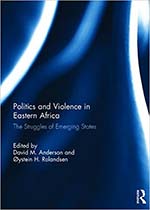
Politics and Violence in Eastern Africa: The Struggles of Emerging StatesDavid Anderson and Øystein H. Rolandsen (editors), Routledge 2015
Over the fifty years between 1940 and 1990, the countries of eastern Africa were embroiled in a range of debilitating and destructive conflicts, starting with the wars of independence, but then incorporating rebellion, secession and local insurrection as the Cold War replaced colonialism. The articles gathered here illustrate how significant, widespread, and dramatic this violence was. In these years, violence was used as a principal instrument in the creation and consolidation of the authority of the state; and it was also regularly and readily utilised by those who wished to challenge state authority through insurrection and secession. Why was it that eastern Africa should have experienced such extensive and intensive violence in the fifty years before 1990? Was this resort to violence a consequence of imperial rule, the legacy of oppressive colonial domination under a coercive and non-representative state system? Did essential contingencies such as the Cold War provoke and promote the use of violence? Or, was it a choice made by Africans themselves and their leaders, a product of their own agency? This book focuses on these turbulent decades, exploring the principal conflicts in six key countries – Kenya, Uganda, Sudan, Ethiopia, Somalia and Tanzania.
- Anderson, David - 04 - Routledge Handbook of African Politics
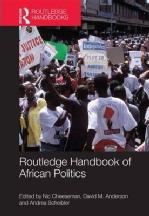
Routledge Handbook of African PoliticsDavid Anderson, Nic Cheeseman, Andrea Scheibler (editors), Routledge 2012
Providing a comprehensive and cutting edge examination of this important continent, Routledge Handbook of African Politics surveys the key debates and controversies, dealing with each of the major issues to be found in Africa’s politics today. Structured into 6 broad areas, the handbook features over 30 contributions focused around The State, Identity, Conflict, Democracy and Electoral Politics, Political Economy & Development, and International Relations. Each chapter deals with a specific topic, providing an overview of the main arguments and theories and explaining the empirical evidence that they are based on, drawing on high-profile cases such as the Democratic Republic of Congo, Kenya, Nigeria, Somalia, South Africa, Rwanda and Zimbabwe. The Handbook also contains new contributions on a wide range of topical issues, including terrorism, the growing influence of China, civil war, and transitional justice, making it required reading for non-specialists and experts alike.
- Anderson, David - 05 - The Khat Controversy: Stimulating the Debate on Drugs
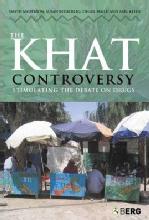
The Khat Controversy: Stimulating the Debate on DrugsDavid Anderson, Susan Beckerleg, Degol Hailu, Axel Klein, Berg 2007
Khat. A harmless natural stimulant or a lethal epidemic sweeping through the international drugs trade? Khat is a natural substance that, in the Middle East, is as ubiquitous as coffee is in the West. It is hugely popular in some African and Arab populations. But critics contend that it is a seriously addictive stimulant that damages the cardiovascular system. In a groundbreaking study, the authors go behind the veil of the drug, questioning its availability and its effect on its Red Sea producers. Interwoven with case studies from Djibouti to Rome, The Khat Controversy goes deeper to explore contemporary issues relating to globalization, ethnicity and culture. With its popularity escalating in London, Rome, Toronto and Copenhagen, khat is fast becoming a problem in the West. The first study of this contested drug, The Khat Controversy provides a concise introduction to the issues surrounding khat usage and suggests how policymakers should address them.
- Anderson, David - 06 - Histories of the Hanged: The Dirty War in Kenya and the End of Empire
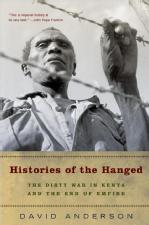
Histories of the Hanged: The Dirty War in Kenya and the End of EmpireDavid Anderson, WW Norton & Co 2005
Histories of the Hanged exposes the long-hidden colonial crimes of the British in Kenya. This groundbreaking work tells how the brutal war between the colonial government and the insurrectionist Mau Mau between 1952 and 1960 dominated the final bloody decade of imperialism in East Africa. Using extraordinary new evidence, David Anderson puts the colonial government on trial with eyewitness testimony from over 800 court cases and previously unseen archives. His research exonerates the Kikuyu rebels—hardly the terrorists they were thought to be—and reveals the British to be brutal aggressors in a "dirty war" that involved leaders at the highest ranks of the British government. This astonishing piece of scholarship portrays a teetering colonial empire in its final phase—employing whatever military and propaganda methods it could to preserve an order that could no longer hold.
- Anderson, David - 07 - Eroding the Commons: The Politics of Ecology in Baringo, Kenya 1890-1963
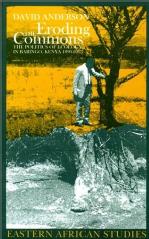
Eroding the Commons: The Politics of Ecology in Baringo, Kenya 1890-1963David Anderson, James Currey, Oxford; Ohio UP, Athens OH 2002
Colonial Baringo was largely unnoticed until drought and localized famine in the mid-1920s led to claims that its crisis was brought on by overcrowding and livestock mismanagement. In response to the alarm over erosion, the state embarked on a program for rehabilitation, conservation, and development.
Eroding the Commons examines Baringo's efforts to contend with the problems of erosion and describes how they became a point of reference for similar programs in British Africa, especially as rural development began to encompass goals beyond economic growth and toward an accelerated transformation of African society. It provides an excellent focus for the investigation of the broader evolution of colonial ideologies and practices of development.
- Anderson, David - 08 - Supporting Ownership: Swedish Development Cooperation with Kenya, Tanzania, and Uganda - Volume 2: Country Studies

Supporting Ownership: Swedish Development Cooperation with Kenya, Tanzania, and Uganda - Volume 2: Country Studies
David Anderson, Christopher Cramer, Alemayehu Geda, Degol Hailu, Frank Muhereza, Matteo Rizzo, Eric Ronge, Howard Stein, John WeeksSida Evaluations 02/33 & 02/33.1, Swedish International Development Cooperation Agency: Stockholm, 2002
Looking at Swedish development cooperation with three countries in East Africa, Kenya, Tanzania and Uganda, this study tries to find out how a longstanding Swedish policy of facilitating and promoting partner country, half a dozen projects and programs are examined in depth. The conclusions of the study are relevant to development cooperation generally, with the shift from projects to programs.
- Anderson, David - 09 - Supporting Ownership: Swedish Development Cooperation with Kenya, Tanzania, and Uganda - Volume 1: Synthesis Report
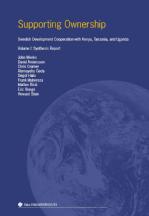
Supporting Ownership: Swedish Development Cooperation with Kenya, Tanzania, and Uganda - Volume 1: Synthesis Report
David Anderson, Christopher Cramer, Alemayehu Geda, Degol Hailu, Frank Muhereza, Matteo Rizzo, Eric Ronge, Howard Stein, John WeeksSida Evaluations 02/33 & 02/33.1, Swedish International Development Cooperation Agency: Stockholm, 2002
Looking at Swedish development cooperation with three countries in East Africa, Kenya, Tanzania and Uganda, this study tries to find out how a longstanding Swedish policy of facilitating and promoting partner country, half a dozen projects and programs are examined in depth. The conclusions of the study are relevant to development cooperation generally, with the shift from projects to programs.
- Anderson, David - 10 - The Poor are Not Us: Poverty and Pastoralism in Eastern Africa
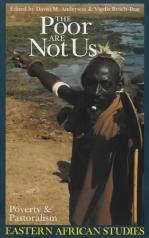
The Poor are Not Us: Poverty and Pastoralism in Eastern AfricaDavid Anderson and Vigdis Broch-Due (editors), James Currey, Oxford; Ohio UP, Athens OH; EAEP, Nairobi; Mkuki na Nyota, Dar es Salaam; Fountain Press, Kampala, 2000
Eastern African pastoralists often present themselves as being egalitarian, equating cattle ownership with wealth. By this definition “the poor are not us”, poverty is confined to non-pastoralist, socially excluded persons and groups. Exploring this notion means discovering something about self-perceptions and community consciousness, how pastoralist identity has been made in opposition to other modes of production, how pastoralists want others to see them and how they see themselves.
This collection rejects the premise of pastoral egalitarianism and poses questions about the gradual creep of poverty, changing patterns of wealth and accumulation, the impact of diminishing resources on pastoral communities and the impact of external values of land, labor, and livestock.
- Anderson, David - 11 - Africa's Urban Past
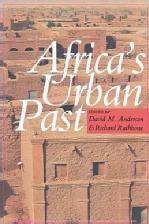
Africa's Urban PastDavid Anderson and Richard Rathbone (editors), James Currey, Oxford; Heinemann, Portsmouth NH, 1999
Africa is witnessing dramatic urban growth on a massive scale which, in the space of this century, has reversed the rural—urban settlement patterns of the continent. Yet urbanization has been an important feature of Africa's history for over two thousand years. Towns and cities have been important arenas around which societies have organized themselves: as centres of trade, economic activity and wealth accumulation; as foci of political action and authority; as military garrisons and symbols of physical domination; as sites of ritual power and contact with the sacred; and as places of refuge, shelter and collective security in troubled times.
This survey reveals a remarkable depth of urbanization in African history. Each chapter places the city at the centre of discussion. Themes developed are unexpectedly diverse, suggesting not only a distinctive history of urbanism but offering great potential for further research. This volume is thus presented as a starting point for the writing of deeper comparative histories of Africa's urban past.
- Anderson, David - 12 - Maasai: People of Cattle
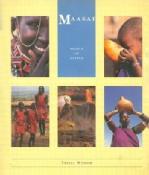
Maasai: People of CattleDavid Anderson
The Little Wisdom Library. Labyrinth, London; Chronicle Books, New York, 1995
In this volume, we take a look at the "tribal wisdom" and culture of the MASSAI people. Among the Maasai, children are much valued and deeply loved. A birth is widely celebrated and any misfortune to befall a child causes distress to the entire community. Children are the future and there is a very palpable sense in which all Maasai recognize this.
- Anderson, David - 13 - Revealing Prophets: Prophecy in Eastern African History
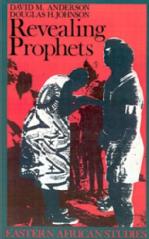
Revealing Prophets: Prophecy in Eastern African HistoryDavid Anderson and Douglas H. Johnson
James Currey, London; Ohio UP, Athens OH; EAEP, Nairobi; Fountain Press, Kampala, 1995
The purpose of this book is to move towards a clearer understanding of the history of prophets within the region of East Africa, and to give an analytical account of the different forms prophecy has taken over the years from place to place.
The book takes a new look at the active dialogue between the prophets and the communities whom they addressed. It suggests that this dialogue continues today as politicians and activists throughout the region still look to prophetic traditions, garnering interpretations of the past in order to provide the validation of prophetic wisdom and heroes for the present.
- Anderson, David - 14 - Policing and Decolonisation: Nationalism, Politics and the Police, 1917-1965

Policing and Decolonisation: Nationalism, Politics and the Police, 1917-1965David Anderson and David Killingray (editors), Manchester UP 1992
Examines the difficulties native police forces encounter when the colonial power that established and protected them pulls out, drawing on examples from the British Empire, such as Ireland, India, Palestine, and Malawi. Traces the typical pattern of public hostility, increasing the numbers of police, creating special units to deal with insurgency, and the political involvement of the police.
Most of the eight studies are from a May 1988 conference at the University of London.
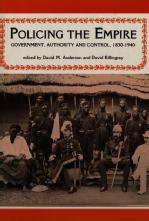
Policing the Empire: Government, Authority and Control, 1830-1940David Anderson and David Killingray (editors), Manchester UP 1991
Established in the belief that imperialism as a cultural phenomenon had as significant an effect on the dominant as it did on the subordinate societies, the "Studies in Imperialism" series seeks to develop the new socio-cultural approach which has emerged through cross-disciplinary work on popular culture, media studies, art history, the study of education and religion, sports history and children's literature. The cultural emphasis embraces studies of migration and race, while the older political, and constitutional, economic and military concerns are never far away. It incorporates comparative work on European and American empire-building, with the chronological focus primarily, though not exclusively, on the 19th and 20th centuries, when these cultural exchanges were most powerfully at work. This work, part of a series on the British Empire, covers and compares the different ways and means that were employed in policing policies from 1830 to 1940. Countries covered range from Ireland, Australia, Africa and India to New Zealand and the Caribbean. The book, in line with the direction of the series as a whole, is concerned with cross-cultural matters, drawing in the social and political effects of the topics under review.
- Anderson, David - 16 - The Ecology of Survival: Case Studies from Northeast African History
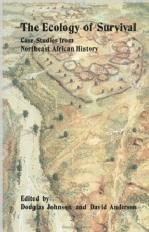
The Ecology of Survival: Case Studies from Northeast African HistoryDavid Anderson and Douglas H. Johnson (editors), Lester Crook, London: Westview Press, Boulder CO 1991
The contribitors to this volume argue that any solutions to Africa's ecological problems must be based on a broad understanding of the historical patterns of ecological change and the interactions between human societies and the environment. Using case studies, they explore the anthropological and historical aspects of ecological problems in Northeast Africa and suggest ways in which policy-makers might take account of this approach.
- Anderson, David - 17 - Conservation in Africa: Peoples, Policies and Practice
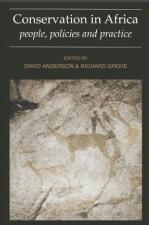
Conservation in Africa: Peoples, Policies and PracticeDavid Anderson and Richard Grove (editors), Cambridge University Press 1987
This book provides a new inter-disciplinary look at the practice and policies of conservation in Africa. Bringing together social scientists, anthropologists and historians with biologists for the first time, the book sheds some light on the previously neglected but critically important social aspects of conservation thinking. To date conservation has been very much the domain of the biologist, but the current ecological crisis in Africa and the failure of orthodox conservation policies demand a radical new appraisal of conventional practices. This new approach to conservation, the book argues, cannot deal simply with the survival of species and habitats, for the future of African wildlife is intimately tied to the future of African rural communities. Conservation must form an integral part of future policies for human development. The book emphasises this urgent need for a complementary rather than a competitive approach. It covers a wide range of topics important to this new approach, from wildlife management to soil conservation and from the Cape in the nineteenth century to Ethiopia in the 1980s. It is essential reading for all those concerned about people and conservation in Africa.
B
- Berg, Maxine - 01 - Goods from the East, 1600-1800: Trading Eurasia
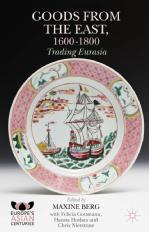
Goods from the East, 1600-1800: Trading EurasiaMaxine Berg (Editor),
The imperative of the long-distance seaborne trade of Europeans, from the age of exploration, was to acquire the goods of the exotic East – the silks and porcelains and tea of China, the spices of the spice islands and the textiles of India. Goods from the East focuses on the trade in fine products: how they were made, marketed and distributed between Asia and Europe. This trade was conducted by East India Companies and many private traders, and the first Global Age that resulted deeply affected European consumption and manufacturing. This book provides a full comparative and connective study of Asia's trade with a range of European countries. Its themes relate closely to issues of fine manufacturing and luxury goods in the current age of globalization. Goods from the East brings together established scholars, such as Jan de Vries, Om Prakash and Josh Gommans, and a new generation of researchers, who together look into the connections between European consumer cultures and Asian trade.
- Berg, Maxine - 02 - Writing the History of the Global: Challenges for the Twenty-First Century
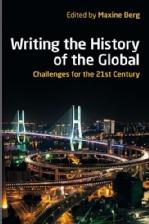
Writing the History of the Global: Challenges for the Twenty-First CenturyMaxine Berg (editor), OUP 2013
The early part of the twenty-first century has witnessed a profound turn in history writing and museum culture towards global and world history. Historians and curators are rapidly changing what they do: no longer satisfied with traditional national histories and area studies, they are pursuing histories of subjects affected by environmental change, migration, slavery, trade and travel. They face challenges of writing about individuals and families in the world, and of political cultures and ideas that have transformed as they have moved between different regions of the world. They are 'going beyond borders' and pursuing wider concepts of connectedness and of cosmopolitanism as these have developed in social theory.
Where has all this come from, and where is it taking us as historians? Writing The History of the Global brings together a number of the major historians now entering the field and re-thinking the way they write their histories. We read the reflections of China experts, historians of India and Japan, of Latin America, Africa and Europe on their past writing, and the new directions in which global history is taking them. It shows the rapid advances in the field from early and inspiring accounts of encounters between East and West, of the wealth and poverty of nations and the crisis of empires, to new thinking on global material cultures, on composite zones and East Asian development paths.
It presents historians at a crossroads: enjoying the great excitement of moving out of national borders and reconnecting parts of the world once studied separately, but also facing the huge challenge of new methodologies of comparison, collaboration and interdisciplinarity and the problems of rapidly disappearing tools of foreign languages.
- Berg, Maxine - 03 - Luxury & Pleasure in Eighteenth-Century Britain
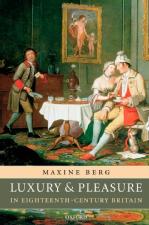
Luxury & Pleasure in Eighteenth-Century BritainMaxine Berg, OUP 2005
Luxury and Pleasure in Eighteenth-Century Britain explores the invention, making, and buying of new, semi-luxury, and fashionable consumer goods during the eighteenth century. It follows these goods, from china tea ware to all sorts of metal ornaments such as candlesticks, cutlery, buckles, and buttons, as they were made and shopped for, then displayed in the private domestic settings of Britain's urban middling classes. It tells the stories and analyses the developments that led from a global trade in Eastern luxuries beginning in the sixteenth century to the new global trade in British-made consumer goods by the end of the eighteenth century. Luxury and Pleasure in Eighteenth-Century Britain is cultural history at its best, built on a fresh empirical base drawn directly from customs accounts, advertising material, company papers, and contemporary correspondence. Maxine Berg traces how this new consumer society of the eighteenth century and the products first traded, then invented to satisfy it, stimulated industrialization itself. Global markets for the consumer goods of private and domestic life inspired the industrial revolution and British products "won the world."
- Berg, Maxine - 04 - Luxury in the Eighteenth Century: Debates, Desires and Delectable Goods
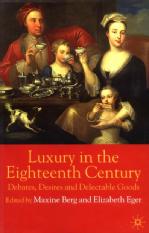
Luxury in the Eighteenth Century: Debates, Desires and Delectable GoodsMaxine Berg and Elizabeth Eger (editors), Palgrave 2002
This volume provides the first interdisciplinary treatment of the history of luxury. It departs from the now well-worked theme of consumer culture to explore luxury as a concept and cultural phenomenon. Luxury was no less than the keyword of the eighteenth century. New foods and raw materials were brought to Europe from around the world: sugar, coffee, chocolate and tea; dyestuffs such as indigo; exotic woods such as mahogany; and porcelain and calicoes. It was such material novelties that stimulated contemporary debates about luxury, contributing to its emergence as a catalyst and signpost of social and intellectual change. This volume explores the political, economic and moral effects of the production and consumption of luxury goods, tying the concept to contmporary discourse on taste, civility and sensibility, aesthetics and literary genres. This cultural history provides a broadly-based focus on luxury in a series of tightly-linked sections addressing key themes of economic debate, material culture, aesthetic prionciples, luxury as a female vice and the exotic.
- Berg, Maxine - 05 - Consumers and Luxury: Consumer Culture in Europe, 1650-1850
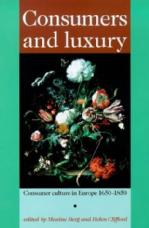
Consumers and Luxury: Consumer Culture in Europe, 1650-1850Maxine Berg and Helen Clifford (editors), Manchester University Press 1999
From tulips to jewels, gastronomy to silver, coffee to colours, that late 17th century and the 18th century saw an explosion of consumer and luxury objexts and a growing demand for their consumption by a widening section of the population.
This interdisciplinary volume brings together a group of scholars to chart the rise of consumer culture in Europe during this period. Essays are included on France and Holland, but the focus is primarily on Britain. Themes discussed include art markets, collecting and display, and are set alongside those of value and luxury, and consumer markets and the public sphere.
- Berg, Maxine - 06 - Technological Revolutions in Europe: Historical Perspectives
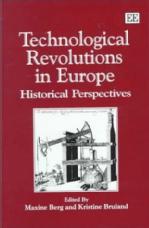
Technological Revolutions in Europe: Historical PerspectivesMaxine Berg and Kristine Bruland (editors), Edward Elgar 1997
This book contains contributions by many of the leading historians of technology. The contributors argue that culture, institutions and learning either made the way for, or blocked technological and industrial transformation. Their essays include broad comparative frameworks between Europe and Asia, and Europe and America, and treat the specific experiences of Britain, France, Holland and Scandinavia.
Themes addressed include cultures of invention and the learning economy, technological inertia and path dependence, patents and product innovation, and technology, institutions and boundaries.
- Berg, Maxine - 07 - A Woman in History: Eileen Power, 1889-1940
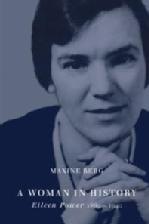
A Woman in History: Eileen Power, 1889-1940Maxine Berg, Cambridge 1996
This book tells the fascinating story of the life and work of Eileen Power, a major British historian who once ranked in fame alongside Tawney, Trevelyan and Toynbee. Using letters, diaries and reminiscences, Maxine Berg recreates the life of this charismatic personality, describing, for the first time, Power's remarkable intellectual and scholarly achievements at a time when she was acting very much outside the conventional female role. Her ability, coupled with her vivid writing and pioneer radio broadcasts, made Eileen Power's unique approach to history compelling reading and listening to a whole generation. Maxine Berg sets Eileen Power's historical writing in the political and cultural framework of the interwar years, and shows how this early writer of women's and medieval social history helped to create a broad, comparative economic and social history for the succeeding generations.
- Berg, Maxine - 08 - The Age of Manufactures, 1700-1820: Industry, Innovation and Work in Britain
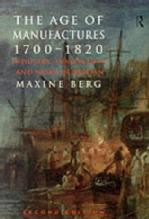
The Age of Manufactures, 1700-1820: Industry, Innovation and Work in BritainMaxine Berg, Second Edition, Routledge 1994
The Age of Manufactures provides an exciting alternative overview of the eighteenth-century British economy. Recent macro-economic history has discounted many of the achievements of the Industrial Revolution. Maxine Berg argues that at the heart of the Industrial Revolution, we find many new consumer industries employing a women's workforce, and bringing with them a rich diversity of technological and organizational change.
Four new chapters explore recent perspectives on the Industrial Revolution, eighteenth century industries, machines and manual labour, and the rise of the factory system. Statistical summaries, and a thorough revision of the whole text have refreshed and enhanced this well-established and important contribution to British ecomonic history.
- Bivins, Roberta - 01 - Contagious Communities: Medicine, Migration, and the NHS in Post War Britain

Contagious Communities: Medicine, Migration, and the NHS in Post War BritainRoberta Bivins, OUP Oxford, 2015
It was only a coincidence that the NHS and the Empire Windrush (a ship carrying 492 migrants from Britain's West Indian colonies) arrived together. On 22 June 1948, as the ship's passengers disembarked, frantic preparations were already underway for 5 July, the Appointed Day when the nation's new National Health Service would first open its doors. The relationship between immigration and the NHS rapidly attained - and has enduringly retained - notable political and cultural significance.
Both the Appointed Day and the post-war arrival of colonial and Commonwealth immigrants heralded transformative change. Together, they reshaped daily life in Britain and notions of 'Britishness' alike. Yet the reciprocal impacts of post-war immigration and medicine in post-war Britain have yet to be explored. Contagious Communities casts new light on a period which is beginning to attract significant historical interest. Roberta Bivins draws attention to the importance - but also the limitations - of medical knowledge, approaches, and professionals in mediating post-war British responses to race, ethnicity, and the emergence of new and distinctive ethnic communities. By presenting a wealth of newly available or previously ignored archival evidence, she interrogates and re-balances the political history of Britain's response to New Commonwealth immigration. Contagious Communities uses a set of linked case-studies to map the persistence of 'race' in British culture and medicine alike; the limits of belonging in a multi-ethnic welfare state; and the emergence of new and resolutely 'unimagined' communities of patients, researchers, clinicians, policy-makers, and citizens within the medical state and its global contact zones.
- Bivins, Roberta - 02 - Alternative Medicine? A History

Alternative Medicine? A HistoryRoberta Bivins, OUP 2007
Walk into the local health food shop or pick up today's paper and the chances are that you'll see adverts for acupuncture and herbal medicine, hypnotists and homeopaths. Some doctors and scientists mourn the lost lustre of mainstream medicine and complain about a new breed of 'irrational' consumer.
But what exactly is 'alternative' medicine? Is the astonishing popularity of alternative and multicultural medicine really such a recent development? And, given the success story of modern biomedical science, why are alternative and traditional treatments now so fashionable? Has the impersonal chill of high-tech medicine driven consumers into the arms of charismatic quacks? Or is it the cost of western medicine that makes its competitors look so attractive? Do patients seek hope, holism, or just the thrill of rebellion?
This book seeks answers to all these questions and more. Comparing the medical systems of China, India, and the west - both mainstream and alternative - Roberta Bivins shows how medical expertise has migrated from one culture to another. From acupuncture in Regency England to homeopathy in the 'Wild West', Bivins unearths the roots of today's distinctions between alternative, complementary, and orthodox medicine, and shows how popular interest in medical alternatives - often of exotic origin - is a phenomenon with a long and fascinating pedigree.
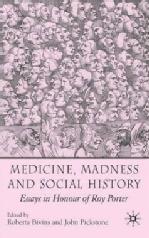
Medicine, Madness and Social History: Essays in Honour of Roy PorterRoberta Bivins and John Pickstone (editors), Palgrave 2007
Roy Porter was a brilliant historian of medicine and madness. He was the British authority on the Enlightenment of the eighteenth century, but he wore his learning lightly. He died, far too young, in 2002.
This collection of essays was written by twenty of his colleagues and students, not just to honour his memory but to convey and extend the spirit of his work. All the essays are based on orginal work in the fields that Porter made his own. They range from the eighteenth century to the present, and tackle major themes, from disability rights to the popularization of science. However, the focus, for the most part, is on people - artisan gardeners jostle with anarchists, dentists and hypnotists in a lively, and very Porterian, parade. Medicine may sometimes seem techinical and remote, but this collection brings it to life through its social history.
- Bivins, Roberta - 04 - Acupuncture, Expertise and Cross-Cultural Medicine
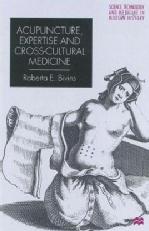
Acupuncture, Expertise and Cross-Cultural MedicineRoberta Bivins, Palgrave 2000
When does a needle in the flesh constitute 'acupuncture', and for whom? Who were Britain's historical acupuncturists? From the exotic tales of seventeenth-century missionaries in the Far East, through reinvention at the cutting edge of adopted French clinical experimentalism, to partial assimilation into British orthodox therapeutic practice in the nineteenth and twentieth centuries, acupuncture in Britain has a long and fascinating history. In this original and well-researched volume, Roberta Bivins describes this history and its implications for the study of continuity and discontinuities in the cross-cultural transmission of medical knowledge, techniques and instrumentation.
Through detailed textual analysis, examination of patient and practitioner networks in the process of medical change, and a case-study of acupuncture and the National Health Service, she looks back to ask, how have we inscribed meaning on to the therapeutic needle? And what does this tell us about technologies and their relationship to culture?
- Branch, Daniel - 01 - Allies at the End of Empire: Loyalists, Nationalists and the Cold War, 1945-76

Allies at the End of Empire: Loyalists, Nationalists and the Cold War, 1945-76David Anderson and Daniel Branch (editors), Routledge 2017
The wars of decolonization fought by European colonial powers after 1945 had their origins in the fraught history of imperial domination, but were framed and shaped by the emerging politics of the Cold War. In all the counter-insurgencies mounted against armed nationalist risings in this period, the European colonial powers employed locally recruited militias – styled as ‘loyalists’ – to fight their ‘dirty wars’.
These loyalist histories have been neglected in the nationalist narratives that have dominated the post-decolonization landscape, and this book offers the first comparative assessment of the role played by these allies at the end of empire. Their experience illuminates the deeper ambiguities of the decolonization story: some loyalists were subjected to vengeful violence at liberation; others actually claimed the victory for themselves and seized control of the emergent state; while others still maintained a role as fighting units into the Cold War. The overlap between the history of decolonization and the emergence of the Cold War is a central theme in the studies presented here. The collection discusses the categorization of these ‘irregular auxiliary’ forces after 1945, and presents seven case studies from five European colonialisms, covering nine former colonies – Portugal (Angola), the Netherlands (Indonesia), France (Algeria), Belgium (Congo) and Britain (Cyprus, Kenya, Aden, South Yemen and Oman). This book was originally published as a special issue of the International History Review.
- Branch, Daniel - 02 - Kenya: Between Hope and Despair, 1963-2011
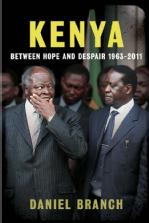
Kenya: Between Hope and Despair, 1963-2011Daniel Branch, Yale University Press 2011
On December 12, 1963, people across Kenya joyfully celebrated independence from British colonial rule, anticipating a bright future of prosperity and social justice. As the nation approaches the fiftieth anniversary of its independence, however, the people's dream remains elusive. During its first five decades Kenya has experienced assassinations, riots, coup attempts, ethnic violence, and political corruption. The ranks of the disaffected, the unemployed, and the poor have multiplied.
In this authoritative and insightful account of Kenya's history from 1963 to the present day, Daniel Branch sheds new light on the nation's struggles and the complicated causes behind them. Branch describes how Kenya constructed itself as a state and how ethnicity has proved a powerful force in national politics from the start, as have disorder and violence. He explores such divisive political issues as the needs of the landless poor, international relations with Britain and with the Cold War superpowers, and the direction of economic development. Tracing an escalation of government corruption over time, the author brings his discussion to the present, paying particular attention to the rigged election of 2007, the subsequent compromise government, and Kenya's prospects as a still-evolving independent state.
- Branch, Daniel - 03 - Defeating Mau Mau, Creating Kenya: Counterinsurgency, Civil War and Decolonisation
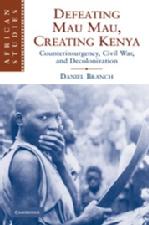
Defeating Mau Mau, Creating Kenya: Counterinsurgency, Civil War and DecolonisationDaniel Branch, Cambridge University Press 2009
This book details the devastating Mau Mau civil war fought in Kenya during the 1950s and the legacies of that conflict for the post-colonial state. As many Kikuyu fought with the colonial government as loyalists joined the Mau Mau rebellion. Focusing on the role of those loyalists, the book examines the ways in which residents of the country’s Central Highlands sought to navigate a path through the bloodshed and uncertainty of civil war. It explores the instrumental use of violence, changes to allegiances, and the ways in which cleavages created by the war informed local politics for decades after the conflict’s conclusion. Moreover, the book moves toward a more nuanced understanding of the realities and effects of counterinsurgency warfare. Based on archival research in Kenya and the United Kingdom and insights from literature from across the social sciences, the book reconstructs the dilemmas facing members of society at war with itself and its colonial ruler.
C
- Carruthers, Susan - 01 - The Good Occupation: Americans Soldiers and the Hazards of Peace

The Good Occupation: Americans Soldiers and the Hazards of PeaceSusan Carruthers, Harvard University Press, November 2016
Waged for a just cause and culminating in total victory, World War II was America’s “good war.” Yet for millions of GIs overseas, the war did not end with Germany and Japan’s surrender. The Good Occupation chronicles America’s transition from wartime combatant to postwar occupier, by exploring the intimate thoughts and feelings of the ordinary servicemen and women who participated—often reluctantly—in the difficult project of rebuilding nations they had so recently worked to destroy.
When the war ended, most of the seven million Americans in uniform longed to return to civilian life. Yet many remained on active duty, becoming the “after-army” tasked with bringing order and justice to societies ravaged by war. Susan Carruthers shows how American soldiers struggled to deal with unprecedented catastrophe among millions of displaced refugees and concentration camp survivors, while negotiating the inevitable tensions that arose between victors and the defeated enemy. Drawing on thousands of unpublished letters, diaries, and memoirs, she reveals the stories service personnel told themselves and their loved ones back home in order to make sense of their disorienting and challenging postwar mission.
The picture Carruthers paints is not the one most Americans recognize today. A venture undertaken by soldiers with little appetite for the task has crystallized, in the retelling, into the “good occupation” of national mythology: emblematic of the United States’ role as a bearer of democracy, progress and prosperity. In real time, however, “winning the peace” proved a perilous business, fraught with temptation and hazard.
- Carruthers, Susan - 02 - The Media at War
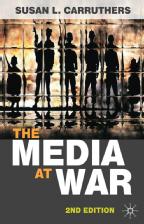
The Media at War (2nd Edition)Susan Carruthers, Basingstoke: Palgrave/Macmillan, 2011
News media, movies, blogs and video games issue constant invitations to picture war, experience the thrill of combat, and revisit battles past. War, it’s often said, sells. But what does it take to sell a war, and to what extent can news media be viewed as disinterested reporters of truth?
Lively and highly readable, this book explores how wars have been reported, interpreted and perpetuated from the dawn of the media age to the present digital era. Spanning a broad geographical and historical canvas, Susan L. Carruthers provides a compelling analysis of the forces that shape the production of news and images of war – from state censorship to more subtle forms of military manipulation and popular pressure. This fully revised second edition has been updated to cover modern-day conflict in the post 9/11 epoch, including the wars in Iraq and Afghanistan.
Rich in historical detail, The Media at War also provides sharp insights into contemporary experience, prompting critical reflection on western society’s paradoxical attitudes towards war.
- Carruthers, Susan - 03 - Cold War Captives: Imprisonment, Escape, and Brainwashing
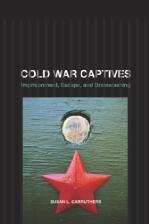
Cold War Captives: Imprisonment, Escape, and BrainwashingSusan Carruthers, University of California Press, 2009
This provocative history of early cold war America recreates a time when World War III seemed imminent. Headlines were dominated by stories of Soviet slave laborers, brainwashed prisoners in Korea, and courageous escapees like Oksana Kasenkina who made a “leap for freedom” from the Soviet Consulate in New York. Full of fascinating and forgotten stories, Cold War Captives explores a central dimension of American culture and politics—the postwar preoccupation with captivity. “Menticide,” the calculated destruction of individual autonomy, struck many Americans as a more immediate danger than nuclear annihilation. Drawing upon a rich array of declassified documents, movies, and reportage—from national security directives to films like The Manchurian Candidate—his book explores the ways in which east-west disputes over prisoners, repatriation, and defection shaped popular culture. Captivity became a way to understand everything from the anomie of suburban housewives to the “slave world” of drug addiction. Sixty years later, this era may seem distant. Yet, with interrogation techniques derived from America’s communist enemies now being used in the “war on terror,” the past remains powerfully present.
- Carruthers, Susan - 04 - The Media At War: Communication and Conflict in the Twentieth Century
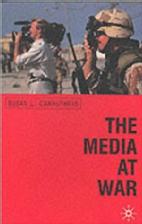
The Media At War: Communication and Conflict in the Twentieth CenturySusan Carruthers, Palgrave/Macmillan, 2000
Drawing on examples from the 20th century's "total wars" and also "limited wars", terrorist campaigns and "complex emergencies" such as Rwanda and Somalia, this study argues that the media's performance in wartime may result as much from peacetime journalistic practices as from the special circumstances of war. The book concludes by assessing the impact of new communications technology and how the representation of future wars is likely to differ from those in the past.
- Carruthers, Susan - 05 - War, Culture and the Media
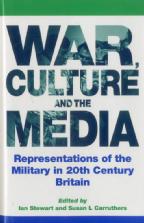
War, Culture and the Media: Representations of the Military in 20th Century BritainSusan Carruthers and Ian Stewart (editors), Flicks Books, 1996
What are the issues -- practical and political -- involved in bringing reports of armed conflict to our television screens? What is the role of the media in our perception of warfare? Are the media reports accurate? These are some of the questions addressed in this new collection of essays.
- Carruthers, Susan - 06 - Winning Hearts and Minds: British Governments, the Media and Colonial Counter-Insurgency 1944-60
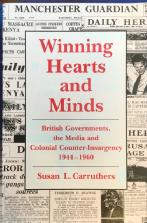
Winning Hearts and Minds: British Governments, the Media and Colonial Counter-Insurgency 1944-60Susan Carruthers, Leicester University Press, 1995
Over the fast twenty-five years, terrorism has attracted immense public and governmental interest. It is not, however, a new phenomenon. This study examines how post-war colonial insurgencies in Palestine, Malaya, Kenya and Cyprus were regarded by British policy-makers and the military as the ‘terrorism’ of their day. Using a great array of archive material, including mass-media sources, the author analyses the way in which propaganda formed an integral part of counter-insurgency strategy. Not only did British governments and their colonial officials produce their own publicity material on events in troubled colonies, they also sought to shape how the media – in Britain and elsewhere – reported them. Unlike many studies of colonial insurgency, this book examines both domestic and international aspects of the battle for ‘hearts and minds’.
- Chen, Song-Chuan - 01 - Merchants of War and Peace: British Knowledge of China in the Making of the Opium War
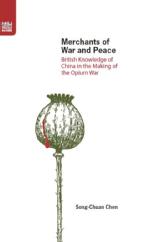
Merchants of War and Peace: British Knowledge of China in the Making of the Opium WarSong-Chuan Chen, Hong Kong University Press 2017
This book challenges conventional arguments that the major driving forces of the First Opium War were the infamous opium smuggling trade, the defence of British national honour, and cultural conflicts between ‘progressive’ Britain and ‘backward’ China. Instead, it argues that the war was triggered by a group of British merchants in the Chinese port of Canton in the 1830s, known as the ‘Warlike Party’. Living in a period when British knowledge of China was growing rapidly, the Warlike Party came to understand China’s weakness and its members returned to London to lobby for intervention until war broke out in 1839.
However, the Warlike Party did not get its way entirely. Another group of British merchants known in Canton as the ‘Pacific Party’ opposed the war. In Britain, the anti-war movement gave the conflict its infamous name, the ‘Opium War’, which has stuck ever since. Using materials housed in the National Archives, UK, the First Historical Archives of China, the National Palace Museum, the British Library, SOAS Library, and Cambridge University Library, this meticulously researched and lucid volume is a new history of the cause of the First Opium War.
- Cowling, Camillia - 01 - Concebendo a liberdade - Mulheres de cor, gênero e a abolição da escravidão nas cidades de Havana e Rio de Janeiro
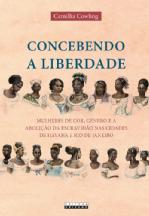
Concebendo a liberdade - Mulheres de cor, gênero e a abolição da escravidão nas cidades de Havana e Rio de JaneiroCamillia Cowling, Unicamp 2018
This is the Portuguese version of Conceiving Freedom: Women of Color, Gender, and the Abolition of Slavery in Havana and Rio De Janeiro.
Em Concebendo a liberdade, Camillia Cowling nos mostra como a categoria de gênero moldou as rotas urbanas em direção à liberdade para os escravos durante o processo de emancipação gradual em Cuba e no Brasil, que ocorreu somente após o restante da América Latina já ter abolido a escravidão e depois, também, da guerra civil norte-americana. Concentrando-se nas últimas décadas do século XIX, nas cidades de Havana e do Rio de Janeiro, a autora evidencia o papel de destaque das mulheres escravizadas na luta em busca de liberdade para elas próprias e para seus filhos através dos tribunais. Ela nos revela como as disputas das mulheres escravizadas conectaram os movimentos abolicionistas em cada uma das cidades e em todo o mundo atlântico, mobilizando novas noções de feminilidade para mulheres escravas e livres. Demonstra ainda como as mulheres gestaram a liberdade e ensinaram a geração de “ventre livre” a entender e influenciar os significados dessa liberdade. Mesmo após a emancipação, as ex-escravas continuariam a utilizar as ações judiciais como ferramentas e seguiram lutando para garantir novos espaços para elas e para suas famílias.
- Cowling, Camillia - 02 - Conceiving Freedom: Women of Color, Gender, and the Abolition of Slavery in Havana and Rio De Janeiro
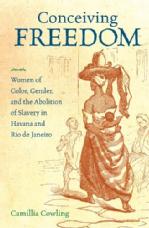
Conceiving Freedom: Women of Color, Gender, and the Abolition of Slavery in Havana and Rio De JaneiroCamillia Cowling, University of North Carolina Press 2013
In Conceiving Freedom, Camillia Cowling shows how gender shaped urban routes to freedom for the enslaved during the process of gradual emancipation in Cuba and Brazil, which occurred only after the rest of Latin America had abolished slavery and even after the American Civil War. Focusing on late nineteenth-century Havana and Rio de Janeiro, Cowling argues that enslaved women played a dominant role in carving out freedom for themselves and their children through the courts.
Cowling examines how women, typically illiterate but with access to scribes, instigated myriad successful petitions for emancipation, often using "free-womb" laws that declared that the children of enslaved women were legally free. She reveals how enslaved women's struggles connected to abolitionist movements in each city and the broader Atlantic World, mobilizing new notions about enslaved and free womanhood. She shows how women conceived freedom and then taught the "free-womb" generation to understand and shape the meaning of that freedom. Even after emancipation, freed women would continue to use these claims-making tools as they struggled to establish new spaces for themselves and their families in post emancipation society.
D
- Davies, Jonathan - 01 - Aspects of Violence in Renaissance Europe
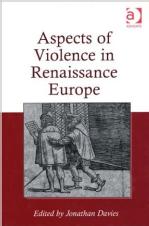
Aspects of Violence in Renaissance EuropeJonathan Davies (editor), Farnham: Ashgate 2013
Interest in the history of violence has increased dramatically over the last ten years and recent studies have demonstrated the productive potential for further inquiry in this field. The early modern period is particularly ripe for further investigation because of the pervasiveness of violence. Certain countries may have witnessed a drop in the number of recorded homicides during this period, yet homicide is not the only marker of a violent society. This volume presents a range of contributions that look at various aspects of violence from the fourteenth to the seventeenth centuries, from student violence and misbehaviour in fifteenth-century Oxford and Paris to the depiction of war wounds in the English civil wars. The book is divided into three sections, each clustering chapters around the topics of interpersonal and ritual violence, war, and justice and the law. Informed by the disciplines of anthropology, criminology, the history of art, literary studies, and sociology, as well as history, the contributors examine all forms of violence including manslaughter, assault, rape, riots, war and justice. Previous studies have tended to emphasise long-term trends in violent behaviour but one must always be attentive to the specificity of violence and these essays reveal what it meant in particular places and at particular times.
- Davies, Jonathan - 02 - Culture and Power: Tuscany and Its Universities 1537-1609
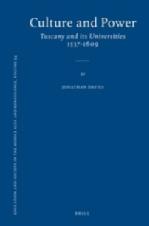
Culture and Power: Tuscany and Its Universities 1537-1609Jonathan Davies, Leiden and Boston: Brill 2009
Traditionally grand ducal Tuscany and its cultural politics have been viewed through the lens of absolutism. Based on a wide range of newly found sources and building on recent revisionist scholarship, this study uses the universities of Pisa and Siena to expose the contradictions and the tensions which characterised the grand duchy. Setting the universities against the diplomatic, military, administrative, economic, ecclesiastical, and cultural development of the grand duchy, it shows how innovation mixed with tradition and local privileges were not only upheld but extended significantly.
- Davies, Jonathan - 03 - Florence & its University during the Early Renaissance
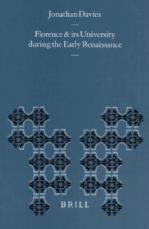
Florence & its University during the Early RenaissanceJonathan Davies, Leiden, Boston and Cologne: Brill 1998
This book makes a substantial contribution to the study of Florentine history. It answers an important but hitherto unresolved question: why did the Florentine Republic keep a university in its capital city between 1385 and 1473 rather than follow the example of other Italian states in maintaining a university in a subject town?
Based on a wide range of newly-found sources, it discloses that the University owed its survival to the support of the Florentine elite, especially the Medici family and its followers. It reveals systematically the close ties between the University and major developments in the social, economic, political, ecclesiastical, and cultural life of Florence and Florentine Tuscany.
The appendices fill some of the greatest gaps in our knowledge of the University, identifying administrators, students, examiners, and teachers.
E
- Earle, Rebecca - 01 - Potato (Object Lessons)
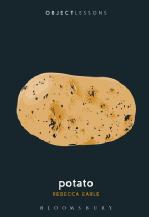
Potato (Object Lessons)Rebecca Earle, Bloomsbury 2019
Object Lessons is a series of short, beautifully designed books about the hidden lives of ordinary things.
Baked potatoes, Bombay potatoes, pommes frites . . . everyone eats potatoes, but what do they mean? To the United Nations they mean global food security (potatoes are the world's fourth most important food crop). To 18th-century philosophers they promised happiness. Nutritionists warn that too many increase your risk of hypertension. For the poet Seamus Heaney they conjured up both his mother and the 19th-century Irish famine.
What stories lie behind the ordinary potato? The potato is entangled with the birth of the liberal state and the idea that individuals, rather than communities, should form the building blocks of society. Potatoes also speak about family, and our quest for communion with the universe. Thinking about potatoes turns out to be a good way of thinking about some of the important tensions in our world.
Object Lessons is published in partnership with an essay series in The Atlantic.
- Earle, Rebecca - 02 - Simple Scoff: The Anniversary Edition

Simple Scoff: The Anniversary EditionRebecca Earle (editor), Warwick University 2015
Students and academics from the University of Warwick, working with the Vice-Chancellor’s wife Lynda Thrift, have put together a cookery book as a part of the University’s 50th anniversary celebrations, Simple Scoff: The Anniversary Edition. The book offers cheap, simple recipes and cooking tips from around the University. It also features illustrations and poems by former students and staff such as BBC media correspondent Torin Douglas.
The book, put together by Professor Rebecca Earle of the University’s History Department, updates Simple Scoff, an innovative cookbook first published in 1972 by the University of Warwick Student Union and Lady Doris Butterworth, the wife of the University’s first Vice-Chancellor. Simple Scoff consisted of recipes and cooking advice contributed by students and other members of the University community, aimed explicitly at students.
- Earle, Rebecca - 03 - The Body of the Conquistador: Food, Race and the Colonial Experience in Spanish America, 1492-1700
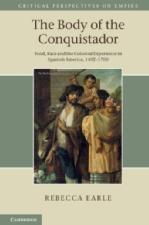
The Body of the Conquistador: Food, Race and the Colonial Experience in Spanish America, 1492-1700Rebecca Earle, Cambridge University Press 2012
This fascinating history explores the dynamic relationship between overseas colonisation and the bodily experience of eating. It reveals the importance of food to the colonial project in Spanish America and reconceptualises the role of European colonial expansion in shaping the emergence of ideas of race during the Age of Discovery. Rebecca Earle shows that anxieties about food were fundamental to Spanish understandings of the new environment they inhabited and their interactions with the native populations of the New World. Settlers wondered whether Europeans could eat New World food, whether Indians could eat European food and what would happen to each if they did. By taking seriously their ideas about food we gain a richer understanding of how settlers understood the physical experience of colonialism and of how they thought about one of the central features of the colonial project. The result is simultaneously a history of food, colonialism and race.
- Earle, Rebecca - 04 - Food & History 7.1: European Cuisine and the Columbian Exchange
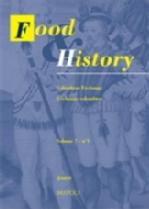
Food & History 7.1: European Cuisine and the Columbian ExchangeRebecca Earle (editor), Food & History 2010
Tomatoes, chiles, chocolate, maize and a host of other New World ingredients bear daily witness to the transformation of global eating habits that followed European colonisation of the Americas. Nonetheless, we know surprisingly little about the processes whereby these foods were naturalised into the cultural universes of their adoptive lands. This special issue of Food and History builds on the growing literature dedicated to the culinary dimensions of the Columbian exchange to offer a detailed analysis of the adoption of particular New World foodstuffs in early modern Europe. How did individual eaters respond to the new foods that curious travellers and sailors brought with them from the Indies? How does the unfamiliar become familiar? The papers that make up this dossier address these questions directly through attentive study of the incorporation of particular New World foodstuffs into the daily diets and cultural spaces of early modern Europeans. Individual articles chart the European trajectories of particular foodstuffs at the same time as they explore the methodological and theoretical frameworks within which the study of food and consumption may be situated.
- Earle, Rebecca - 05 - The Return of the Native: Indians and Myth-Making in Spanish America, 1810-1930
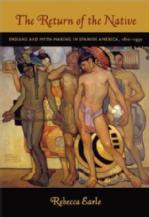
The Return of the Native: Indians and Myth-Making in Spanish America, 1810-1930Rebecca Earle, Duke University Press 2008
Why does Argentina's national anthem describe its citizens as sons of the Inca? Why did patriots in nineteenth-century Chile name a battleship after the Aztec emperor Montezuma? Answers to both questions lie in the tangled knot of ideas that constituted the creole imagination in nineteenth-century Spanish America. Rebecca Earle examines the place of pre-conquest peoples such as the Aztecs and the Incas within the sense of identity - both personal and national - expressed by Spanish American elites in the first century after independence, a time of intense focus on nation-building. Starting with the anti-Spanish wars of independence in the early nineteenth century, Earle charts the changing importance elite nationalists ascribed to the pre-Columbian past through an analysis of a wide range of sources, including historical writings, poems and novels, postage stamps, constitutions, and public sculpture.This eclectic archive illuminates the nationalist vision of creole elites throughout Spanish America, who in different ways sought to construct meaningful national myths and histories. Traces of these efforts are scattered across nineteenth-century culture; Earle maps the significance of those traces. She also underlines the similarities in the development of nineteenth-century elite nationalism across Spanish America. By offering a comparative study focused on Mexico, Guatemala, Colombia, Peru, Chile, and Ecuador, "The Return of the Native" illustrates both the common features of elite nation-building and some of the significant variations. The book ends with a consideration of the pro-indigenous indigenista movements that developed in various parts of Spanish America in the early twentieth century.
- Earle, Rebecca - 06 - Rumours of Wars: Civil Conflict in Nineteenth-Century Latin America
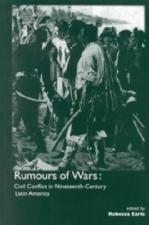
Rumours of Wars: Civil Conflict in Nineteenth-Century Latin AmericaRebecca Earle (editor), University of London/Institute of Latin American Studies 2000
The essays in this volume examine the causes of civil wars in nineteenth-century Latin America. After Independence, most Latin American countries suffered acute political instability. In spite of their recurrence, these conflicts have been largely neglected by modern historiography. This volume aims at encouraging further research in the area. In addition to a general overview of the region as a whole, the volume includes chapters on Brazil, Colombia, Chile, Venzuela, Honduras, Mexico, Argentina and Bolivia. Contributors include: John Chasteen, UNC at Chapel Hill; Marie Danielle Demelas-Bohy, Institut des Hautes Etudes de l'Amerique Latine; Dario A. Euraque, Trinity College; Will Fowler, University of St Andrews; Carlos Malamud, Universidad Nacional de Educacion a Distancia; Elena Plaza, Universidad Central de Venezuela; Frank Safford, Northwestern University.
- Earle, Rebecca - 07 - Spain and the Independence of Colombia 1810-1825
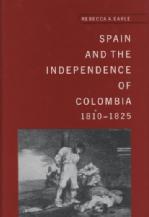
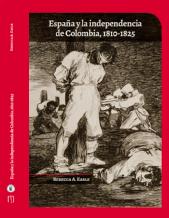
Spain and the Independence of Colombia 1810-1825España y la independencia de Colombia, 1810-1825 (Spanish translation)
Rebecca Earle, University of Exeter Press 2000
Between 1808 and 1825, Latin America was engulfed in a wave of revolution that destroyed the Spanish empire in the Americas. This book studies the process of imperial collapse in one of these Spanish colonies: the Viceroyalty of New Granada, the future Republic of Colombia. Rebecca Earle makes extensive use of previously unexplored Spanish documents to suggest that Spanish royalists inadvertently engineered their own defeat.
- Earle, Rebecca - 08 - Epistolary Selves: Letters and Letter-writers, 1600-1945
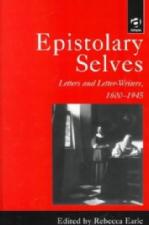
Epistolary Selves: Letters and Letter-writers, 1600-1945Rebecca Earle (editor), Ashgate Press 1999
This volume of ten essays discusses the pivotal role that letters have played in social, economic and political history from the 17th to the 20th century. The contributors aim to establish letters as a category of readable material, whose texts can reveal information about the context in which they were written. Topics covered include the mercantile letter, diplomatic correspondence, and what these epistolary forms suggest about the rise of a polite, literate culture in the 18th century; the experience of immigration from Europe to America during the 19th and 20th centuries; the relationship through the letter; and the working of gender in the epistolary form.
F
- Fagge, Roger - 01 - The Vision of J.B. Priestley
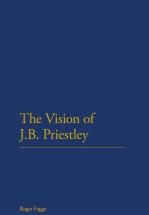
The Vision of J.B. PriestleyRoger Fagge, Continuum 2012
Drawing on private and published sources, Roger Fagge takes an in-depth look at J.B. Priestley's work, seeking to reclaim him as an important English thinker. Priestley grew up in Bradford, and served on the front line in the First World War, before attending Cambridge and embarking on a career as a writer. A committed radical, he wrote widely for the press, as well as producing autobiographies, social criticism and plays. This work revealed a growing interest in the meaning of Englishness and the start of a long-running relationship with America. Priestley achieved even greater influence during the early years of World War II via his popular BBC radio 'postscripts'. His later career, however, saw his faith in the people give way to a disillusionment with the spread of the Americanised mass society, although his critical response to the latter maintained a perceptive engagement with world. The Vision of J.B. Priestley charts the continuities, strengths and weaknesses in the author's long career, and his vision of an outward looking radical Englishness.
- Fagge, Roger - 02 - America in the British Imagination
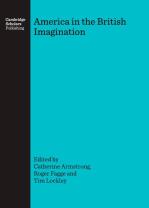
America in the British ImaginationCatherine Armstrong, Roger Fagge, Timothy Lockley (editors), Cambridge Scholars Publishing 2007
No other region of the world has exerted such a fascination for the British, and for such a long time, as the United States of America. From the first explorations and settlements in the seventeenth century, through the heyday of the first British empire in the Americas in the eighteenth century and the fundamental re-conceptualisation of America following independence, to the present day American global hegemony a vast variety of Britons have looked across the Atlantic and pondered on American life, culture, politics and attitudes. In this volume a number of scholars from a variety of different disciplines (History, English, Theatre Studies, Music and History of Art) explore the ways in which Britons have imagined America. They show how some visited America themselves, while others relied on second-hand reports, but all engaged with America on various levels, often imagining and re-imagining it through different time-periods. The reality of American life, or of American politics was one issue, as were other factors including American identity, culture, music and theatre, all of which were filtered through a shifting gaze ranging from admiration to outright hostility Included are essays on the printed representations of early Virginia, the view of British consuls living in the slave South, the interpretations of diverse writers such as Dickens, Auden, Orwell and Amis, and on the lyrics and other public pronouncements of the band Radiohead. The time frame runs from the seventeenth to the twenty-first century, and should enable the reader the see how British perceptions and understandings of America have evolved over those 400 years. Ultimately, the complexity and ambiguity of British imaginings of America emerges as the central theme of the book.
- Fagge, Roger - 03 - Power, Culture and Conflict in the Coalfields: West Virginia and South Wales, 1900-1922
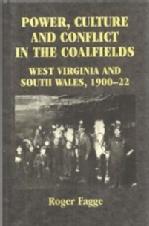
Power, Culture and Conflict in the Coalfields: West Virginia and South Wales, 1900-1922Roger Fagge, Manchester University Press 1996
This text provides a comparative perspective on two major coalfields, in order to allow a historically constructed view of the patterns of experience and behaviour in mining communities. It shows how the contrasting cultural formations, social structures and power relationships within West Virginia and South Wales definitely shaped the content and form of industrial conflict, as well as broader political identities and languages. This led to huge labour "civil wars" in West Virginia, backed by appeals to an ambigous Americanism, while the South Wales miners embarked on less violent solidaristic strike activity, accompanied by a shift towards labourist and class politics. The book draws on a wide range of sources in both Britain and the US, and provides an insight into the complex world of the coal miner. It should be useful to those interested in US and British social and labour history, and the regional histories of Wales and Appalachia.
- Fletcher, Robert - 01 - The Ghost of Namamugi: Charles Lenox Richardson and the Anglo-Satsuma War

The Ghost of Namamugi: Charles Lenox Richardson and the Anglo-Satsuma WarRobert Fletcher, Renaissance Books, 2018
In 1862, a young British merchant was killed by samurai, in uncertain circumstances, at Namamugi – a quiet village near Yokohama, Japan. One year later, a British fleet bombarded the port of Kagoshima to extract reparations, reducing much of this south-western city to ash.
The Ghost of Namamugi is a captivating re-telling of this story, locating it firmly within the wider context of British imperial expansion in East Asia. Dr Fletcher explains how it was that the death of one man led to the partial destruction of a city, and approaches this murder as a window onto the makings and dynamics of a mid-nineteenth century ‘outrage’. The book explores how competing images of the dead of Namamugi, Charles Lenox Richardson – to some a martyr in the cause of free trade, to others the embodiment of a bullying merchant class – have served to justify and to lament Britain’s bombardment ever since.
Making use of newly discovered sources, The Ghost of Namamugi also presents, for the first time and in full, Richardson’s personal correspondence home. Written across ten years spent living and trading at Shanghai, the Richardson letters to give readers a chance to form their own judgement of the man at the centre of an international incident. Together, the book offers new perspectives on the thoughts, experiences and travails of a determined young merchant of the treaty port world, at a critical moment in the history of imperial expansion and conflict in Asia.
- Fletcher, Robert - 02 - British Imperialism and 'The Tribal Question': Desert Administration and Nomadic Societies in the Middle East, 1919-1936
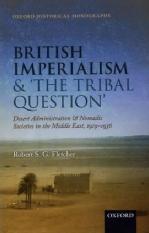
British Imperialism and 'The Tribal Question': Desert Administration and Nomadic Societies in the Middle East, 1919-1936Robert Fletcher, Oxford 2015
British Imperialism and ‘The Tribal Question’ reconstructs the history of Britain's presence in the deserts of the interwar Middle East, making the case for its significance to scholars of imperialism and of the region's past. It tells the story of what happened when the British Empire and Bedouin communities met on the desert frontiers between the Mediterranean Sea and the Persian Gulf. It traces the workings of the resulting practices of 'desert administration' from their origins in the wake of one World War to their eclipse after the next, as British officials, Bedouin shaykhs, and nationalist politicians jostled to influence desert affairs.
Drawn to the commanding heights of political society in the region's towns and cities, historians have tended to afford frontier 'margins' merely marginal treatment. Instead, this volume combines the study of imperialism, nomads, and the desert itself to reveal the centrality of 'desert administration' to the working of Britain's empire, repositioning neglected frontier areas as nerve centres of imperial activity. British Imperialism and ‘The Tribal Question’ leads the shift in historians' attentions from the familiar, urban seats of power to the desert 'hinterlands' that have long been obscured.
G
- Gerritsen, Anne - 01 - Global Gifts: The Material Culture of Diplomacy in Early Modern Eurasia
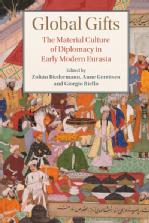
Global Gifts: The Material Culture of Diplomacy in Early Modern Eurasia- Gerritsen, Anne - 02 - Micro-Spatial Histories of Global Labour
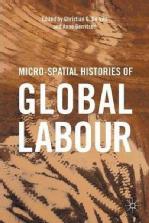
Micro-Spatial Histories of Global LabourChristian de Vito and Anne Gerritsen (editors), Palgrave 2017
This volume suggests a new way of doing global history. Instead of offering a sweeping and generalizing overview of the past, we propose a ‘micro-spatial’ approach, combining micro-history with the concept of space. A focus on primary sources and awareness of the historical discontinuities and unevennesses characterizes the global history that emerges here. We use labour as our lens in this volume. The resulting micro-spatial history of labour addresses the management and recruitment of labour, its voluntary and coerced spatial mobility, its political perception and representation and the workers’ own agency and social networks. The individual chapters are written by contributors whose expertise covers the late medieval Eastern Mediterranean to present-day Sierra Leone, through early modern China and Italy, eighteenth-century Cuba and the Malvinas/Falklands, the journeys of a missionary between India and Brazil and those of Christian captives across the Ottoman empire and Spain. The result is a highly readable volume that addresses key theoretical and methodological questions in historiography.
- Gerritsen, Anne - 03 - The Global Lives of Things: The Material Culture of Connections in the Early Modern World
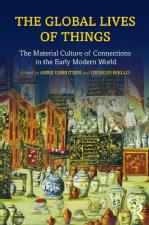
The Global Lives of Things: The Material Culture of Connections in the Early Modern WorldAnne Gerritsen and Giorgio Riello (editors), Routledge 2015
The Global Lives of Things considers the ways in which ‘things’, ranging from commodities to works of art and precious materials, participated in the shaping of global connections in the period 1400-1800. By focusing on the material exchange between Asia, Europe, the Americas and Australia, this volume traces the movements of objects through human networks of commerce, colonialism and consumption. It argues that material objects mediated between the forces of global economic exchange and the constantly changing identities of individuals, as they were drawn into global circuits. It proposes a reconceptualization of early modern global history in the light of its material culture by asking the question: what can we learn about the early modern world by studying its objects?
This exciting new collection draws together the latest scholarship in the study of material culture and offers students a critique and explanation of the notion of commodity and a reinterpretation of the meaning of exchange. It engages with the concepts of ‘proto-globalization’, ‘the first global age’ and ‘commodities/consumption’. Divided into three parts, the volume considers in Part One, Objects of Global Knowledge, in Part Two, Objects of Global Connections, and finally, in Part Three, Objects of Global Consumption. The collection concludes with afterwords from three of the leading historians in the field, Maxine Berg, Suraiya Faroqhi and Paula Findlen, who offer their critical view of the methodologies and themes considered in the book and place its arguments within the wider field of scholarship.
Extensively illustrated, and with chapters examining case studies from Northern Europe to China and Australia, this book will be essential reading for students of global history.
- Gerritsen, Anne - 04 - Writing Material Culture History
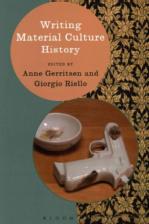
Writing Material Culture HistoryAnne Gerritsen and Giorgio Riello (editors), Bloomsbury 2014
Writing Material Culture History examines the methodologies currently used in the historical study of material culture. Touching on archaeology, art history, literary studies and anthropology, the book provides history students with a fundamental understanding of the relationship between artefacts and historical narratives. The role of museums, the impact of the digital age and the representations of objects in public history are just some of the issues addressed in a book that brings together key scholars from around the world.
A range of artefacts, including a 16th-century Peruvian crown and a 19th-century Alaskan Sea Lion overcoat, are considered, illustrating the myriad ways in which objects and history relate to one another. Bringing together scholars working in a variety of disciplines, this book provides a critical introduction for students interested in material culture, history and historical methodologies.
- Gerritsen, Anne - 05 - Ji'an Literati and the Local in Song-Yuan-Ming China
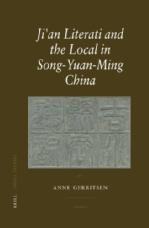
Ji'an Literati and the Local in Song-Yuan-Ming ChinaAnne Gerritsen, Brill 2007
Drawing on largely local sources, including local gazetteers and literati inscriptions for religious sites, this book offers a comprehensive examination of what it means to be 'local' during the Southern Song, Yuan and Ming dynasties in Ji'an prefecture (Jiangxi). It argues that 'belonging locally' was important to Ji'an literati throughout this period. How they achieved that, however, changed significantly. Southern Song and Yuan literati wrote about religious sites from within their local communities, but their early Ming counterparts wrote about local temples from their posts at the capital, seeking to transform local sites from a distance. By the late Ming, temples had been superseded by other sites of local activism, including community compacts, lineage prefaces, and community covenants.
H
- Haberlen, Joachim - 01 - The Emotional Politics of the Alternative Left: West Germany, 1968-1984
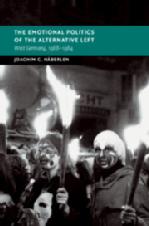
The Emotional Politics of the Alternative Left: West Germany, 1968-1984Joachim Häberlen, Cambridge University Press 2018
In the 1970s, a multifaceted alternative scene developed in West Germany. At the core of this leftist scene was a struggle for feelings in a capitalist world that seemed to be devoid of any emotions. Joachim C. Häberlen offers here a vivid account of these emotional politics. The book discusses critiques of rationality and celebrations of insanity as an alternative. It explores why capitalism made people feel afraid and modern cities made people feel lonely. Readers are taken to consciousness raising groups, nude swimming at alternative vacation camps, and into the squatted houses of the early 1980s. Häberlen draws on a kaleidoscope of different voices to explore how West Germans became more concerned with their selves, their feelings, and their bodies. By investigating how leftists tried to transform themselves through emotional practices, Häberlen gives us a fresh perspective on a fascinating aspect of West German history.
- Haberlen, Joachim - 02 - Vertrauen und Politik im Alltag. Die Arbeiterbewegung in Leipzig und Lyon im Moment der Krise, 1929-1933/38
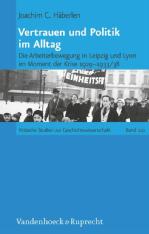
Vertrauen und Politik im Alltag. Die Arbeiterbewegung in Leipzig und Lyon im Moment der Krise, 1929-1933/38 (Kritische Studien zur Geschichtswissenschaft 210)Joachim Häberlen, Göttingen: Vandenhoeck & Ruprecht, 2013
The study investigates social and political practices of the working-class movement in Leipzig and Lyon. It contributes to our understanding of the defeat of the German working-class movement fighting the Nazis and the rise of the Popular Front in France. Why was the German working-class movement struggling against the rise of National-Socialism so easily defeated, whereas the French working-class movement, which was numerically and organizationally much weaker than its German counterpart, succeeded in mobilizing hundreds of thousands of workers against the radical right at the moment of a fascist threat? To answer this question, Joachim Häberlen’s study investigates the social and political practices within the working-class movement in Leipzig and Lyon at the end of the Weimar Republic and, respectively, the Third French Republic. At the core of the study are the role of trust and distrust in social and political movements, and the ambivalent consequences of the politicization of the working-class movement within its local context.
- Haberlen, Joachim - 03 - Vergleichen, Verflechten, Verwirren? Europäische Geschichtsschreibung zwischen Theorie und Praxis

Vergleichen, Verflechten, Verwirren? Europäische Geschichtsschreibung zwischen Theorie und Praxis[Comparing, Entangling, Confusing? Writing European History between Theory and Practice]
Joachim Häberlen, Göttingen: Vandenhoeck & Ruprecht, 2011
- Hajkova, Anna - 01 - Čekám až se vrátíš. Rodinné deníky z války
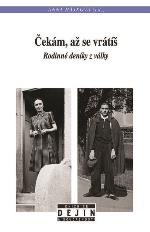
I Am Waiting For You to Come Back: Family Wartime Diaries (Čekám až se vrátíš. Rodinné deníky z války)Anna Hájková (editor), NLN 2018
In the six months he spent in hiding in Prague prior to his arrest in August 1944, the Jewish Communist resistance fighter, Jany Lebovič, kept a diary. Jany was deported to Auschwitz and shot upon arrival. At the time of Jany’s arrest, the Nazis deported the mother of Jany’s friend, Pavla Hájková, for supporting this resistance group. Pavla was liberated from a Ravensbrück satellite camp, and throughout the months following her liberation, Pavla kept a diary testifying to her difficult return trip through a destroyed Germany to Prague, her new beginning in Prague, and her slow realization that her husband would never return. For Jany and Pavla, diary-writing represented a means of communicating with their beloved partners, from whom they were separated by the Nazis. These unique documents speak about the Holocaust, concentration camps, Communist resistance, and love in wartime. This edition of these two family diaries is accompanied by the editor’s historical introduction and critical commentary, memories of Pavla’s and Jany’s relatives, and photographs from family archives.
- Hajkova, Anna - 02 - Alltag im Holocaust: Jüdisches Leben im Großdeutschen Reich 1941-1945

Alltag im Holocaust: Jüdisches Leben im Großdeutschen Reich 1941-1945[The Everyday in the Holocaust: Jewish Life in Greater Germany, 1941-1945]
Anna Hájková, Doris Bergen, Andrea Löw (editors), Munich: Oldenbourg 2013
How everyday designed in the face of persecution and death? The Holocaust research assumes recently strengthened Jewish life in the view. This volume brings together recent studies on the lives of the victims in the Greater German Reich, on their perceptions, maneuver and reactions, whether in Berlin, Vienna or Theresienstadt, the ghetto or in hiding. The persecuted Jews and "half-breeds" appear in this perspective, as members of families, organizations and communities, and especially as the acting individuals who aspired to a life, a new normality in abnormal conditions and learned. These people were trying not only to survive, but to live.
- Hodges, Sarah - 01 - Women's Studies Quarterly: Technologies, Volume 37
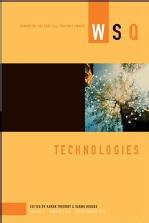
Women's Studies Quarterly: Technologies, Volume 37Sarah Hodges and Karen Throsby (editors) 2009
Technologies considers how medical, digital, and communication technologies are transforming the way we understand gender, motherhood, the body, and feminism. Including articles that investigate fertility clinic websites, Google identities, and the HPV vaccine, Technologies presents research from the social sciences, cultural studies, history, science, and education.
- Hodges, Sarah - 02 - Contraception, Colonialism and Commerce: Birth Control in South India, 1920-1940
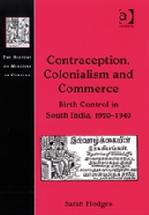
Contraception, Colonialism and Commerce: Birth Control in South India, 1920-1940Sarah Hodges, Ashgate 2008
Birth control holds an unusual place in the history of medicine. Largely devoid of doctors or hospitals, only relatively recently have birth control histories included tales of laboratory-based therapeutic innovation. Instead, these histories elucidate the peculiar slippages between individual bodies and a body politic occasioned by the promotion of techniques to manipulate human reproduction. The history of birth control in India brings these as well as additional complications to the field.
Contrary to popular belief, India has one of the most long-lasting, institutionalized, far-reaching, state sponsored family planning programs in the world. During the inter-war period the country witnessed the formation of groups dedicated to promoting the cause of birth control.
This book outlines the early history of birth control in India, particularly the Tamil south. In so doing, it illuminates India's role in a global network of birth control advocacy. The book also argues how Indians' contraceptive advocacy and associationalism became an increasingly significant realm of action in which they staked claims not just about the utility of contraception but simultaneously over their ability and right to self-rule.
- Hodges, Sarah - 03 - Reproductive Health in India: History, Politics, Controversies
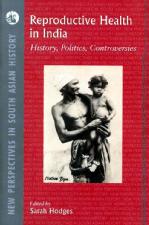
Reproductive Health in India: History, Politics, ControversiesSarah Hodges (editor), Delhi: Orient Longman 2006
Within the scholarly fields of demography, development studies, medical anthropology and public policy, the history of reproduction has been dominated by preconceived and often a-historical ideas about India’s supposed long-term trend towards “over-population.” When these scholarly fields have invoked histories of fertility and contraception, these histories have largely been made to serve as the “pre-modern” antithesis to a fully “modern” future. In contrast, this volume brings together historians to tackle the complex questions of reproduction in modern India. Taken together, these essays interrogate the very idea that reproduction is simply a linch-pin for effecting other social and economic transformations. Instead, these histories map out and ask questions of the institutions, discourses and practices by which women's reproductive health came to hold meaning and play strategic roles in the multiple and at times competing agendas such as social reform, the medical sciences, cultural nationalism, and colonial public health.
K
- Knights, Mark - 01 - Faction Displayed: Reconsidering the Impeachment of Dr Henry Sacheverell
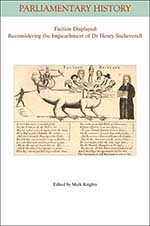
Faction Displayed: Reconsidering the Impeachment of Dr Henry SacheverellMark Knights (editor), Wiley-Blackwell 2012
In 1710, the English clergyman Doctor Henry Sacheverell became embroiled in a celebrated show trial before the House of Lords that developed into one of the greatest controversies of the early 18th century. Faction Displayed: Reconsidering the Impeachment of Dr. Henry Sacheverell features a collection of essays that closely examine the turbulent partisan culture—and bitter public furore—that ensued as a result of the 1710 parliamentary trial of Dr. Henry Sacheverell. Impeached for sermons that challenged the principles underpinning the Revolution of 1688, Sacheverell had lashed out against fundamental Whig ideas about religious toleration, moderation, and a right to resist tyrants—ideas that precipitated one of the largest printed debates in the first half of the eighteenth century. Readings reveal how Sacheverell’s trial cast a wider net on ways the so-called ‘Glorious Revolution’ transformed British society, as well as how it provides deeper insights into the character of Britain’s ‘public sphere’.
Faction Displayed offers important new insights into the politics, religion, press, discourse, ideology, economics and imperialism of a critical period in English history. Part 1 covers the theoretical foundations of intercultural sociolinguistic analysis. The articles presented in Part 2 and 3 illustrate the analytical applications of this theoretical framework, and Part 4 focuses the reader on issues relating to intercultural discourse and communication.
- Knights, Mark - 02 - The Devil in Disguise: Deception, Delusion, and Fanaticism in the Early English Enlightenment
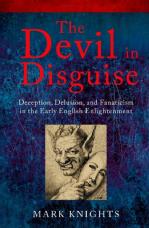
The Devil in Disguise: Deception, Delusion, and Fanaticism in the Early English EnlightenmentMark Knights, OUP 2011
The Devil in Disguise illuminates the impact of the two British revolutions of the seventeenth century and the shifts in religious, political, scientific, literary, economic, social, and moral culture that they brought about.
It does so through the fascinating story of one family and their locality: the Cowpers of Hertford. Their dramatic history contains a murder mystery, bigamy, a scandal novel, and a tyrannized wife, all set against a backdrop of violently competing local factions, rampant religious prejudice, and the last conviction of a witch in England.
Spencer Cowper was accused of murdering a Quaker, and his brother William had two illegitimate children by his second 'wife'. Their scandalous lives became the source of public gossip, much to the horror of their mother, Sarah, who poured out her heart in a diary that also chronicles her feeling of being enslaved to her husband. Her two sons remained in the limelight. Both were instrumental in the prosecution of Henry Sacheverell, a firebrand cleric who preached a sermon about the illegitimacy of resistance and religious toleration. His parliamentary trial in 1710 provoked serious riots in London. William Cowper also intervened in 1712 to secure the life of Jane Wenham, whose trial provoked a wide-ranging debate about witchcraft beliefs.
The Cowpers and their town are a microcosm of a changing world. Their story suggests that an early 'Enlightenment', far from being simply a movement of ideas sparked by 'great thinkers', was shaped and advanced by local and personal struggles.
- Knights, Mark - 03 - The Entring Book of Roger Morrice 1677-1691: Volume 5 The reign of William III, 1689-1691
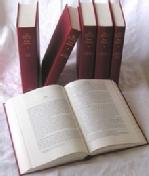
The Entring Book of Roger Morrice 1677-1691: Volume 5 The reign of William III, 1689-1691Mark Knights (editor), Boydell and Brewer 2007
Compiled between the years 1677 and 1691, the Entring Book is 900,000 words long, with many sensitive passages written in a secret shorthand that has only recently been decoded. This remarkable chronicle of public affairs has remained for nearly three centuries, secure but little known, in Dr Williams's Library, London. The Entring Book fits no simple definition. It is not just a political diary, nor is it only the newsletter it sometimes resembles. It's possible that it could have been the material for a history of Morrice's own times, or it may have been a letterbook, recording correspondence to an unnamed recipient. Writing in great detail, with meticulous regularity, Morrice may have been passing on all he knew to senior figures in the opposition to Charles II and James II. The Entring Book's enormous scope means it also covers publishing, plays, business, military and religious matters, foreign affairs, public opinion and London life, making it an essential resource. Through it we can trace the transformation of puritanism into Whiggery and Dissent.
- Knights, Mark - 04 - Representation and Misrepresentation in Later Stuart Britain: Partisanship and Political Culture
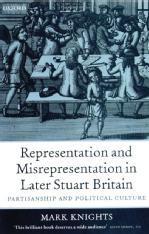
Representation and Misrepresentation in Later Stuart Britain: Partisanship and Political CultureMark Knights, OUP 2005
In this original and illuminating study, Mark Knights reveals how the political culture of the eighteenth century grew out of earlier trends and innovations. Arguing that the period 1675-1720 needs to be seen as the second stage of a seventeenth-century revolution that ran on until c.1720, the book traces the development of the public as an arbiter of politics, the growth of a national political culture, the shift towards a representative society, a crisis of public discourse and credibility, and a political enlightenment rooted in local and national partisan conflict.
- Knights, Mark - 05 - Politics and Opinion in Crisis, 1678-81
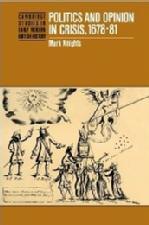
Politics and Opinion in Crisis, 1678-81Mark Knights, CUP 1994
The aftermath of the Popish Plot and the subsequent succession crisis of the years 1678 to 1681 are the context for this new study. It asks two key questions: was there an exclusion crisis? and did these years witness the birth of modern political parties? The author argues that the unrest was not simply due to a centrally organized party machine based around the single issue of exclusion; but was a broad-based controversy about the succession, fears of popery and arbitrary government which produced ideological polarization and political sophistication. Part One examines central politics to explore the succession crisis within the context of the court and an emergent political structure. Part Two explores public opinion in the country as a whole, and argues that propaganda electioneering, religious conflict and petitions committed men to organized networks of belief.
- Kumin, Beat - 01 - The European World 1500–1800: An Introduction to Early Modern History
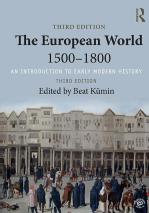
The European World 1500–1800: An Introduction to Early Modern HistoryBeat Kümin (editor), Expanded 3rd Edition, London: Routledge, 2018
The European World 1500-1800 provides a concise and authoritative textbook for the centuries between the Renaissance and the French Revolution. It presents early modern Europe not as a mere transition phase, but a dynamic period worth studying in its own right. Written by an experienced team of specialists, and derived from a successful undergraduate course, it offers a student-friendly introduction to all major themes and processes of early modern history.
This third edition features greatly expanded coverage of ‘The Wider World’, with added chapters on relations with the Ottoman empire, European settlement overseas and the global exchange of goods. Other new content includes an overview of early modern medicine and comprehensive timelines for each of the thematic parts.
Specially designed to assist learning, The European World 1500-1800 features:
- expert surveys of key topics written by an international group of historians
- suggestions for seminar discussion and further reading
- extracts from primary sources and generous illustrations, including maps
- a glossary of key terms and concepts
- a full index of persons, places and subjects
- and a much enhanced companion website, offering colour images, direct access to primary materials, and interactive features which highlight key events and locations discussed in the volume.
The European World 1500-1800 will be essential reading for all students embarking on the discovery of the early modern period.
- Kumin, Beat - 02 - Pfarreien in der Vormoderne: Identität und Kultur im Niederkirchenwesen Europas

Pfarreien in der Vormoderne: Identität und Kultur im Niederkirchenwesen Europas[Pre-modern Parishes: Identity and Culture in Local Ecclesiastical Life]
Michele Ferrari and Beat Kümin (editors), Wiesbaden: Harrassowitz Verlag, 2017
In den letzten Jahrzehnten erhielt die Pfarrei als strukturierende Einheit europäischer Territorien der Vormoderne zunehmend Aufmerksamkeit. Sie war nicht nur ein kirchenrechtlich (verhältnismäßig schwach) definiertes Gebilde, sondern ein lebendiger Ort des Austauschs, in dem institutionelle Konzepte, wirtschaftliche Interessen, soziale Bewegungen und kulturelle Strömungen verhandelt und verarbeitet wurden. Die Pfarrei war die Nahtstelle zwischen den Kirchenoberen und dem Laienvolk, und deshalb kam ihr eine vitale gesellschaftliche Rolle zu. Besonders wichtig war ihre Funktion zur Identitätsbildung lokaler Gemeinschaften, die sich um eine nicht selten eigens gebaute Pfarrkirche versammelten und regen Einfluss auf die Ausstattung des Gotteshauses und auf die Besetzung der Stellen nahmen.
Der Band möchte einen eigenen Beitrag zur Erforschung des Niederkirchenwesens der Vormoderne leisten, indem zum einen eine dezidiert europäische Perspektive gewählt wurde - die Beiträge behandeln die deutschsprachigen Teile Europas sowie England, Frankreich, Ungarn und Italien -, zum anderen aber ein besonderer Akzent auf die kulturellen Errungenschaften der Pfarreien bis zum 16. Jahrhundert gesetzt wird: Kirchenbau und Architektur, Buchwesen und Musikpflege.
- Kumin, Beat - 03 - Politische Freiheit und republikanische Kultur im alten Europa
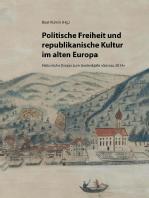
Politische Freiheit und republikanische Kultur im alten Europa (Political Freedom and Republic Culture in Old Europe)Beat Kümin (editor), 2015
The brochure “Political Freedom and Republic Culture in Old Europe” is effectively a slightly expanded set of proceedings of the 2014 conference on “Self-Determination”. In recognition for their expansive work on many aspects of local history, the volume has been dedicated to Marzell Camenzind, honorary district archivist, and Robert Nigg sen., who built up an important collection of old prints. Taken together, the contributions underline the benefits of expanding our horizon beyond the “classic” republics of ancient Greece/Rome, Renaissance Italy, Imperial Free Cities, Cromwellian England and the Dutch/Swiss Confederations to smaller, rural communities on the one hand; and the enormous strength of (and attachment to) “collective freedom”, i.e. the right to self-government with minimal external interference, on the other.
- Kumin, Beat - 04 - At Home and in the Workplace: Domestic and Occupational Space in Western Europe from the Middle Ages
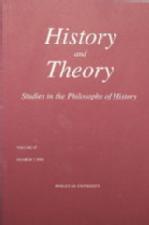
At Home and in the Workplace: Domestic and Occupational Space in Western Europe from the Middle AgesBeat Kümin and Cornelie Usborne (editors), History and Theory 52, 2013
History and Theory is a quarterly peer-reviewed academic journal published by Wiley-Blackwell on behalf of Wesleyan University. The journal was established in 1960 and focuses on the nature of history, including the philosophy of history, historiography, historical methodology, critical theory, and time and culture.
Building on the 2010 conference on ‘From Space to Place: the Spatial Dimension in History of Western Europe’ held at the German Historical Institute in London, this special issue develops two of main themes: domestic space and work space. The case studies range – chronologically – from medieval buildings via early modern alehouses to twentieth-century households; regionally – from England via the Netherlands to Germany; and – thematically – from gender roles via labour markets to witchcraft discourses. Assessing the impact of the ‘spatial turn’ in the light of these contributions, the co-editors argue that ‘spatial methods and approaches help us to capture the complexity of historical constellations and the simultaneity of different experiences and horizons’, while ‘yet greater efforts [need to be made] to engage with the materiality of social exchange’.
- Kumin, Beat - 05 - The Communal Age in Western Europe c.1100-1800: Towns, Villages and Parishes in Pre-Modern Society, Studies in European History
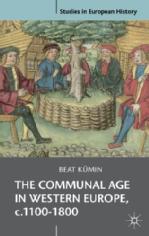
The Communal Age in Western Europe c.1100-1800: Towns, Villages and Parishes in Pre-Modern Society, Studies in European HistoryBeat Kümin, Basingstoke: Palgrave Macmillan 2013
The Communal Age in Western Europe, c.1100-1800 offers a fresh interpretation of the significance of towns, villages and parishes in the medieval and early modern period. Drawing on a wide range of primary and secondary sources from numerous regions, Beat Kümin explains how local communities empowered common people through collective agency and a degree of local autonomy, demonstrates how communal units impacted on key historical developments, from the Reformation to state formation, provides case studies of the Italian city, the English parish and the village in the Holy Roman Empire, surveys communal origins, constitutions and cultural representations, as well as contested issues such as gender roles and inner tensions, and evaluates related historiographical debates on communalism and republicanism. Informed by a genuinely comparative and integrated approach, this original volume offers an excellent introduction to European history 'from below', and to the fundamental building blocks of European society.
- Kumin, Beat - 06 - A Cultural History of Food in the Early Modern Age
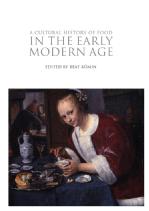
A Cultural History of Food in the Early Modern AgeBeat Kümin (editor), Oxford: Berg 2012
Volume four of the six-part series A Cultural History of Food
The seventeenth and eighteenth centuries form a very distinctive period in European food history. This was a time when enduring feudal constraints in some areas contrasted with widening geographical horizons and the emergence of a consumer society. While cereal-based diets and small-scale trade continued to be the mainstay of the general population, elite tastes shifted from Renaissance opulence toward the greater simplicity and elegance of dining à la française. At the same time, growing spatial mobility and urbanization boosted the demand for professional cooking and commercial catering. An unprecedented wealth of artistic, literary and medical discourses on food and drink allows fascinating insights into contemporary responses to these transformations.
A Cultural History of Food in the Early Modern Age presents an overview of the period with essays on food production, food systems, food security, safety and crises, food and politics, eating out, professional cooking, kitchens and service work, family and domesticity, body and soul, representations of food, and developments in food production and consumption globally.
- Kumin, Beat - 07 - Public Drinking in the Early Modern World 1500-1800: Voices from the Tavern

Public Drinking in the Early Modern World 1500-1800: Voices from the TavernBeat Kümin and B. Ann Tlusty (editors), Vols 2-3: The Holy Roman Empire, London: Pickering & Chatto, 2011
An extensive collection of translated primary sources (travel reports, registers of public houses, taxation records, diaries, moral literature, court proceedings etc) from German-speaking Europe, especially the imperial free city of Augsburg, the principality of Bavaria and the Swiss city republic of Bern. The other two volumes in the series, edited by Thomas Brennan, feature evidence from France and America.
- Kumin, Beat - 08 - Brewing Cultures in Early Modern Towns: special issue of Brewery History 135
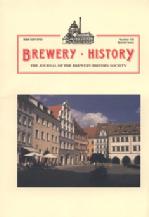
Brewing Cultures in Early Modern Towns: special issue of Brewery History 135Beat Kümin (editor), 2010
Brewery History was first published in 1973 and appears four times a year. Its prime aim is to promote historical research into all aspects of brewing and related industries, both in the United Kingdom and abroad. The journal comprises original articles, photographic essays, reprints of academic theses and difficult to obtain pieces, and book reviews. The scope of Brewery History includes, but is not limited to, histories of existing and closed breweries, research on associated industries (e.g. malting, hops, retailing, etc.), biographical pieces on key figures, and studies into the social, political and economic impact of the brewing industry. The journal occasionally publishes themed issues on specific topics and provides the option for peer review.
Special issue 135, Brewing Cultures in Early Modern Towns, features refereed essays by James Brown, Katja Lindenau, Tim Reinke-Williams and Masatake Wasa.
- Kumin, Beat - 09 - Political Science in Pre-Industrial Europe
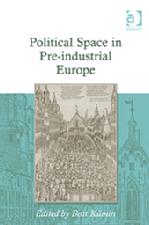
Political Science in Pre-Industrial EuropeBeat Kümin (editor), Aldershot: Ashgate 2009
This collection examines the potential and limitations of spatial approaches for the political history of preindustrial Europe. Adopting a broad definition of ‘political’, the volume concentrates on two key questions: Where did political exchange take place? And how did spatial dimensions affect political life in different periods and contexts? Taken together, the essays demonstrate that premodern Europeans made use of a much wider range of political spaces than is usually assumed, and that spatial dimensions provided key variables in political life. By bridging common gaps between periods and disciplines, the volume offers a timely and critical engagement with the ‘spatial turn’ and a review of the potential and limits of spatial approaches for political history as a whole.
- Kumin, Beat - 10 - The European World 1500-1800: An Introduction to Early Modern History
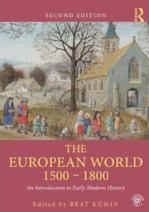
The European World 1500-1800: An Introduction to Early Modern HistoryBeat Kümin (editor), Routledge, 1st edition 2009, 2nd edition 2014
The European World 1500-1800 provides a concise and authoritative textbook for the centuries between the Renaissance and the French Revolution. It presents early modern Europe not as a mere transitional phase, but a dynamic period worth studying in its own right. Written by an experienced team of specialists, and derived from a successful undergraduate course, it offers a student-friendly introduction to all major themes and processes of early modern history.
Structured in four parts dealing with socio-economic, religious, cultural and political issues, it adopts a deliberately broad geographical perspective: Western and Central Europe receive particular attention, but dedicated chapters also explore the wider global context. For this thoroughly revised and improved second edition, the authors have added three new chapters on ‘Politics and Government’, ‘Impact of War' and ‘Revolution’.
Specially designed to assist learning, The European World 1500-1800 features:
- state-of-the-art surveys of key topics written by an international team of historians
- suggestions for seminar discussion and further reading
- extracts from primary sources and generous illustrations, including maps
- a glossary of key terms and concepts
- a chronology of major events
- a full index of persons, places and subjects
- a fully-featured companion website, enhanced for this new edition
The European World 1500-1800 will be essential reading for all students embarking on the discovery of the early modern period.
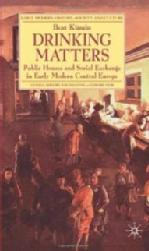
Drinking Matters: Public Houses and Social Exchange in Early Modern Central EuropeBeat Kümin, Palgrave Macmillan 2007
Drinking Matters offers the first comparative survey of early modern public houses. A combination of qualitative and quantitative analysis weaves written, visual and material evidence into a reconstruction of their unique contribution to European culture. Extrapolating from the heterogeneous case studies of Bern and Bavaria, the argument stresses the bewildering versatility of drinking establishments. Public houses emerge as communication spaces in a state of continuous renegotiation. As facilitators of infinite forms of human exchange, they supported rulers as easily as rebels. 'Innovative' principles like consumer choice did not need to be invented by the modern restaurant, they characterized the trade from its medieval origins. Local cultural life depended on inns just as much as the early modern communication revolution. Within a communal infrastructure featuring town halls, market squares and parish churches, public houses became the principal social sites in preindustrial Europe. After about 1800, processes of fragmentation and diversification ended their golden age.
- Kumin, Beat - 12 - Landgemeinde und Kirche im Zeitalter der Konfessionen
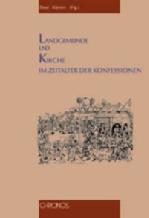
Landgemeinde und Kirche im Zeitalter der Konfessionen[Rural Communities and the Church in the Age of Confessions]
Beat Kümin (editor), Zürich: Chronos Verlag 2004
The state of research on the European Reformation(s) and the Confessional Age has advanced dramatically in recent decades. Almost inevitably, new studies expand the chronological limits, thematic range and analytical tools, while grand narratives such as the concept of confessionalization are viewed more critically. The contributions in this volume demonstrate at least one striking continuity: the influence of parishes and rural communities on religious life before, during and after the transformations of the sixteenth century.
The essays focus on rural areas of the Swiss Confederation, the Holy Roman Empire, England, and Russia. Examining parishes in extremely heterogeneous socio-political as well as denominational contexts, the authors pay special attention to institutions, officials, financial regimes, patterns of worship and festive cultures. The complex interaction between local society and external authority emerges as the main theme, shedding new light on the contrasting priorities of individuals, communities, confessional Churches and emerging territorial states. New religious cultures thus emerged out of a delicate negotiation process rather than Reformations imposed ‘from above’.
- Kumin, Beat - 13 - The World of the Tavern: Public Houses in Early Modern Europe
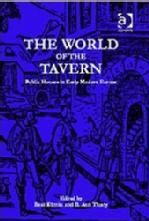
The World of the Tavern: Public Houses in Early Modern EuropeBeat Kümin and B. Ann Tlusty (editors), Aldershot: Ashgate Publishing 2002
The subject of drink received a great deal of attention from early modern contemporaries, who produced a large body of literature addressing the drink problem. Preachers railed against it, urban and rural authorities published ordinances against it, and satirists extolled it. At the same time, the tavern was an institution central to the social, cultural and professional life of most of the male population of Europe. The multifaceted role of inns and taverns in early modern Europe is explored from an interdisciplinary perspective in this anthology. Scholars from England, Germany, Switzerland the USA use research on inns and taverns to shed light on such topics as communal identity, legal and fiscal practice, theological debates, gender and household relationships, and divisions between domestic and public spheres. The result is a volume that should appeal not only to social historians of the period, but also to legal historians and cultural anthropologists.
- Kumin, Beat - 14 - The Parish in English Life 1400-1600

The Parish in English Life 1400-1600Beat Kümin, Katherine French, Gary Gibbs (editors), Manchester University Press 1997
This is the first comprehensive survey of the religious, social and cultural life of late medieval and reformation parishes. This collection introduces the reader to the large number of anthropological, literary, socio-economic and quantitative approaches. It features studies of individual communities and larger areas, illuminates the parish through a great variety of records (parochial, manorial, municipal, diocesan and legal) and explores the most important neighbouring disciplines (literature, art history, archaeology). This volume covers town and country, northern as well as southern communities, and it provides an indication of the European setting. For the first time, the parish is studied through the period just before and just after the enormous social and religious changes of the sixteenth century. All the contributors present their topics not as 'parochial', but as local history in the widest sense of the word, by both reflecting and contributing to current historiographical issues.
- Kumin, Beat - 15 - Reformations Old and New: Essays on the Socio-Economic Impact of Religious Change c.1470-1630
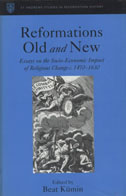
Reformations Old and New: Essays on the Socio-Economic Impact of Religious Change c.1470-1630Beat Kümin (editor), Aldershot and Brookfield/Vermont: Scolar Press, 1996
This collection of essays examines the practical impact of religious change in Central and North Western Europe from the 15th to the 17th century. It focuses on the effects of reform on clergy, church resources, ecclesiastical patronage, education and poor relief. The title reflects the elementary conclusion that there was no one monolithic experience of ‘Reformation’, that initiatives were taken for very different reasons, and that they displayed innovative as well as conservative features.
While offering a great breadth of original research and subject matter, all authors devote particular attention to three main themes: the blend between continuity and change, the share of religious factors in socio-economic developments, and the identification of winners and losers. Taken together, the essays illustrate the scarcity of unambiguous trends, the tenacity of socio-economic structures, the modification of religious dogma by the ‘real’ world, and the conspicuous benefits of religious change for the social élites.
- Kumin, Beat - 16 - The Shaping of a Community: The Rise & Reformation of the English Parish c. 1400-1560
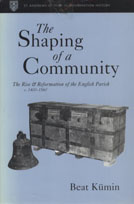
The Shaping of a Community: The Rise & Reformation of the English Parish c. 1400-1560Beat Kümin, Aldershot and Brookfield/Vermont: Scolar Press, 1996
This book offers a new perspective to the current debate about popular religious attitudes in Tudor England, laying particular emphasis on the social and secular dimensions of parish life.
The argument focuses on the role of the laity and especially on the office of churchwarden. It assesses the rising levels of parish income, the importance of the social context for fund-raising strategies, and the growing expenditure on priests, voluntary activities and administrative duties. The final part discusses the Reformation-related reduction in religious options and the intensifying trend towards oligarchical parish regimes and official local government responsibilities.Wherever possible, the English situation is put into sharper focus by comparisons with local ecclesiastical life on the Continent and appendices provide a detailed financial analysis for a large number of parishes.
L
- Lambert, David - 01 - Mastering the Niger: James MacQueen’s African Geography and the Struggle over Atlantic Slavery
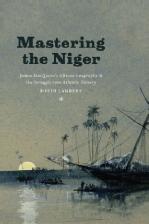
Mastering the Niger: James MacQueen’s African Geography and the Struggle over Atlantic SlaveryDavid Lambert, University of Chicago Press 2013
Mastering the Niger examines the relationships between slavery, geographical knowledge and Britain’s emerging empire in Africa in the late eighteenth and early nineteenth centuries. It does so by analysing a series of geographical claims made about West Africa that were implicated in different and often competing agendas: antislavery, colonial, commercial, humanitarian, missionary and scientific. Although centred on West Africa, the sources and consequences of these claims, as well as the broader agendas to which they were related, extended to the wider Atlantic world, including the slave colonies of the Caribbean.
The book focuses, in particular, on the West African facts and theories promulgated by the Scot, James MacQueen (1778–1870), especially about the course and termination of the River Niger. MacQueen was a famous nineteenth century geographer of Africa – despite never once visiting the continent – who correctly argued that the river flowed to the Atlantic Ocean at least a decade before this was proven to European satisfaction by explorers on the spot. MacQueen was also the former manager of a Caribbean slave plantation, a Glasgow merchant with trans-Atlantic commercial interests, a high-profile critic of the British antislavery campaign and an out-spoken advocate for the colonisation of Africa. MacQueen’s claims about Africa and the responses they engendered from the government, merchants, antislavery campaigners, explorers and other geographers, demonstrates how geographical facts and theories were central to contemporary debates about empire, slavery and scientific knowledge. In analysing MacQueen’s claims, the book argues for an understanding of geographical knowledge that is based on investigating the relations between the textual, numerical and cartographic sites where it is expressed and made credible, and the worldly sites which are its sources and where its effects are felt.
The book stands at the intersection of two main areas of interest: histories of slavery, abolition and empire; and histories (and historical geographies) of science and knowledge. It is innovative in bringing these areas together, and in arguing that the entanglements of Atlantic slavery, geographical knowledge and imperialism can examined through a historical-geographical investigation of the relationships between worldly and representational sites.
- Lambert, David - 02 - Colonial Lives Across the British Empire: Imperial Careering in the Long Nineteenth Century
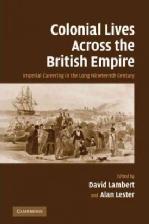
Colonial Lives Across the British Empire: Imperial Careering in the Long Nineteenth CenturyDavid Lambert and Alan Lester (editors), Cambridge University Press 2006
This volume uses a series of portraits of ‘imperial lives’ in order to rethink the history of the British Empire in the nineteenth and early twentieth centuries. It tells the stories of men and women who dwelt for extended periods in one colonial space before moving on to dwell in others, developing ‘imperial careers’. These men and women consist of four colonial governors, two governors’ wives, two missionaries, a nurse/entrepreneur, a poet/civil servant and a mercenary. Leading scholars of colonialism guide the reader through the ways that these individuals made the British Empire, and the ways that the empire made them. Their life histories constituted meaningful connections across the empire that facilitated the continual reformulation of imperial discourses, practices and cultures. Together, their stories help us to re-imagine the geographies of the British Empire and to destabilize the categories of metropole and colony.
- Lambert, David - 03 - White Creole Culture, Politics and Identity during the Age of Abolition
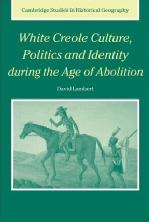
White Creole Culture, Politics and Identity during the Age of AbolitionDavid Lambert, Cambridge University Press 2005
White Creole Culture focuses on white society in the Caribbean island of Barbados during the turbulent period 1780-1833. The book tells of a colonial community in crisis and confusion, unable to understand the momentous changes occurring in Britain that were turning opinion against the material and ideological basis of their society – slavery. But this is not a story of dead white men making history. By focusing on a series of emblematic moments – an effort to reform slavery from within, the writing of a landmark local history, the largest slave rebellion ever on the island, an episode of religious persecution and the final years before the ending of slavery in 1833 – White Creole Culture examines the Atlantic-wide influences that shaped white culture, politics and identity, and particularly the role of the slaves and other non-white people.
Barbados had been transformed into the first true sugar colony in the seventeenth century. The sweet substances and even sweeter profits that flowed from this and other islands stimulated the growth of European consumer culture, financed the industrial revolution and contributed to the expansion of a global, capitalist system. The British slaveholders and their white creole (i.e. locally-born) descendents took great pride in their island's status as an ancient, loyal and vital colony – even after its relative value had declined. Yet underlying all this sweetness was the enslavement of millions of Africans and people of African descent. White Creole Culture focuses on the period when Caribbean slavery came under attack from the slaves themselves – spectacularly so in the revolution that culminated in Haitian independence – and antislavery campaigners in Britain . In Parliament and beyond, these campaigners decried slavery as against everything that was British and Christian. The British metropolitan and humanitarian dimensions of this campaign are well-known, as is its ambivalent impact on the slaves themselves, but never before has the reaction of white slaveholders in the Caribbean been the focus of sustained research. The central question is how did Barbados's whites – so long used to claiming their pre-eminence in the British Empire – respond to attacks on their society as fundamentally ‘un-British'?
- Lockley, Timothy - 01 - Maroon Communities in South Carolina: A Documentary Record
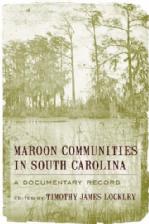
Maroon Communities in South Carolina: A Documentary RecordTimothy Lockley, University of South Carolina Press 2009
Maroon communities were small, secret encampments formed by runaway slaves, typically in isolated and defensible sections of wilderness. The phenomenon began as runaway slaves, unable to escape to safe havens in sympathetic colonies, opted instead to band together for survival near the sites of their former enslavement. In this first survey of documentary records of marronage in colonial and antebellum South Carolina, Timothy Lockley offers students and scholars of history an opportunity to assess the unique features and trends of the maroon experience in the Palmetto State.
- Lockley, Timothy - 02 - Slavery in North America: From the Colonial Period to Emancipation

Slavery in North America: From the Colonial Period to EmancipationTimothy Lockley, Mark M. Smith, Peter S. Carmichael, Jonathan Daniel Wells (editors), Pickering & Chatto 2008
From the founding of Jamestown to the American Civil War, slavery and abolition shaped American national, regional and racial identities. Even now, slavery and its legacy remains the most emotive and divisive aspect of US history. This four-volume reset edition draws together rare sources relating to American slavery systems. The chronological spread of sources reveals changes in the material and intellectual underpinnings of slavery over time. Moreover, the arrangement of the sources reveal the geographical diversity of slavery across North America, and offer scholars access to the experience of a wide range of constituencies from slaves and slave-owners, through abolitionists and pro-slavery ideologues, to travellers and plantation visitors. The complicated role that slavery played in the ideological construction of Confederate nationhood is also explored. The texts included in this edition are rare and difficult-to-access or are transcribed from manuscripts for the first time. The edition includes extensive editorial material including a general introduction, volume introductions, headnotes, endnotes and a consolidated index in the final volume. It will be vital for scholars of the History of Slavery, the History of Abolitionism and American History.
- Lockley, Timothy - 03 - America in the British Imagination

America in the British ImaginationCatherine Armstrong, Roger Fagge, Timothy Lockley (editors), Cambridge Scholars Publishing 2007
No other region of the world has exerted such a fascination for the British, and for such a long time, as the United States of America. From the first explorations and settlements in the seventeenth century, through the heyday of the first British empire in the Americas in the eighteenth century and the fundamental re-conceptualisation of America following independence, to the present day American global hegemony a vast variety of Britons have looked across the Atlantic and pondered on American life, culture, politics and attitudes. In this volume a number of scholars from a variety of different disciplines (History, English, Theatre Studies, Music and History of Art) explore the ways in which Britons have imagined America. They show how some visited America themselves, while others relied on second-hand reports, but all engaged with America on various levels, often imagining and re-imagining it through different time-periods. The reality of American life, or of American politics was one issue, as were other factors including American identity, culture, music and theatre, all of which were filtered through a shifting gaze ranging from admiration to outright hostility Included are essays on the printed representations of early Virginia, the view of British consuls living in the slave South, the interpretations of diverse writers such as Dickens, Auden, Orwell and Amis, and on the lyrics and other public pronouncements of the band Radiohead. The time frame runs from the seventeenth to the twenty-first century, and should enable the reader the see how British perceptions and understandings of America have evolved over those 400 years. Ultimately, the complexity and ambiguity of British imaginings of America emerges as the central theme of the book.
- Lockley, Timothy - 04 - Welfare and Charity in the Antebellum South
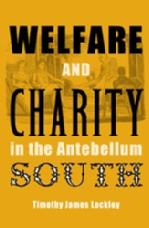
Welfare and Charity in the Antebellum SouthTimothy Lockley, University Press of Florida 2007
Public welfare in the United States has existed in one form or another since the colonial period. Most historical investigations into the practice tend to focus on urban settings, mostly in the North. Welfare and Charity in the Antebellum South offers a much-needed counterpoint, revealing both the breadth of how southerner elites helped their poor, even in rural areas, and the racial impetus behind their actions.
In the nineteenth century, private benevolence was almost exclusively for whites. Public welfare in the South was disproportionately targeted at poor whites, and included the founding of state-supported schools, orphan and health care, and efforts to ameliorate starvation. As a result, poor whites' resentment of the rich was diminished, and they were, as a group, more willing to cast their lot with slaveholders as the Civil War loomed large.
This work ranges over the entire South and makes important comparisons between the upper and lower South, between urban and rural areas, and between welfare efforts in the South and in the North, where charity typically--and incorrectly--has been seen as more widespread.
- Lockley, Timothy - 05 - Lines in the Sand: Race and Class in Lowcountry Georgia, 1750-1860
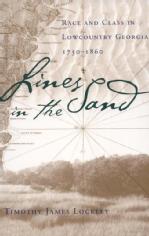
Lines in the Sand: Race and Class in Lowcountry Georgia, 1750-1860Timothy Lockley, University of Georgia Press 2001
Dominated politically and economically by a planter elite and outnumbered by slaves, lowcountry poor whites in antebellum Georgia often found that their closest allies were on the opposite side of the color line. Timothy James Lockley looks at evidence from travel accounts, slave narratives, newspapers, and court documents to reveal that poor whites and blacks formed numerous kinds of relationships in such pursuits as work, recreation, trade, religion, even crime. Sometimes they came together out of mutual affection, sometimes for mutual advantage - but always in spite of the disapproving authority of the planter class.
M
- Marland, Hilary - 01 - Health and Girlhood in Britain, 1874-1920
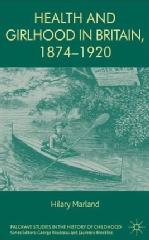
Health and Girlhood in Britain, 1874-1920Hilary Marland, Palgrave-Macmillan 2013
This first book-length study of girls' health in modern Britain explores how debates and advice on healthy girlhood, invoking new visions and practices of health, shaped ideas about the lives and potential of adolescent girls from the 1870s to the 1920s. It demonstrates how the 'modern girl' with her 'modern body' was created during this period, as a range of new experts promoted innovative approaches to hygiene, diet and exercise. Theories concerning the biological limitations of female adolescence were challenged and replaced with a growing emphasis on the importance of behaviour in producing good health, and girls deemed responsible for taking care of their own wellbeing. New practices of health, though varying significantly across the social classes, enabled the extension of girls' roles in education, work, sport, and recreation, and fed into the creation of a new cultural category of 'girlhood' as a discrete and important phase between childhood and womanhood.
- Marland, Hilary - 02 - Migration, Health and Ethnicity in the Modern World
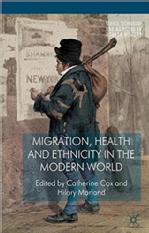
Migration, Health and Ethnicity in the Modern WorldCatherine Cox and Hilary Marland (editors), Palgrave-Macmillan 2013
This volume examines the relationship between migration, health and illness in a global context from c.1820 to the present day. Bringing together leading scholars from the history of medicine and social policy, it assesses the changing health status of migrant groups in a period encompassing Imperial expansion, decolonisation and new waves of economic and political migration in the twentieth century. Focusing chiefly on the Anglophone world, the volume takes a wide range of case studies to explore the themes of epidemic disease and its containment, chronic illness and mental breakdown in Britain, the US, Israel and the Caribbean. The concerns of the volume echo and enable reflection upon the health challenges experienced by migrants and countries of destinations in recent years.
- Marland, Hilary - 03 - Dangerous Motherhood: Insanity and Childbirth in Victorian Britain
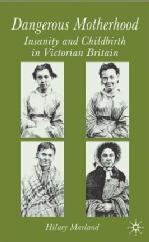
Dangerous Motherhood: Insanity and Childbirth in Victorian BritainHilary Marland, Houndmills: Palgrave-Macmillan, 2004
Dangerous Motherhood is the first study of the close and complex relationship between mental disorder and childbirth. Exploring the relationship between women, their families and their doctors reveals how explanations for the onset of puerperal insanity were drawn from a broad set of moral, social and environmental frameworks, rather than being bound to ideas that women as a whole were likely to be vulnerable to mental illness. The horror of this devastating disorder which upturned the household and turned gentle mothers into disruptive and dangerous, mad women, was magnified by its occurrence at a time when it was anticipated that women would be most happy in the fulfillment of their role as mothers.
- Marland, Hilary - 04 - Cultures of Child Health in Britain and the Netherlands in the Twentieth Century
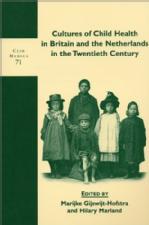
Cultures of Child Health in Britain and the Netherlands in the Twentieth CenturyHilary Marland and Marijke Gijswijt-Hofstra (editors)
Wellcome Institute Series in the History of Medicine, Amsterdam and New York: Rodopi, 2003
In 1999 a group of Dutch and British historians working in child health gathered at Warwick University for a workshop on ‘Child health and national fitness in the twentieth century’. National fitness emerged as a less important unifying theme to the workshop than had been anticipated. As the editors wrote in the introduction to the volume which emerged from the workshop, the dominance of “national efficiency” was challenged. National efficiency was still viewed as a central motivating factor for child welfare and health in early-twentieth-century Britain by those who wrote on that subject; for example in his chapter on mental deficiency, Mark Jackson cited an early-twentieth-century doctor who proclaimed: “The hand that wrecks the cradle wrecks the nation”. Yet it was also shown to be time and place specific. The Dutch historians argued that national fitness was less important in discourses of child health than the “pillared” denominational society of early-twentieth-century Netherlands. Other papers focusing on post-Second World War societies showed that concerns of national fitness had given way to other considerations based on social changes and the new child psychology (such as the “separation anxiety” discussed by Harry Hendrick, the sexual revolution discussed by Hugo Röling, and the anti-psychiatry movement and youth culture discussed by Gemma Blok). This collection of essays highlights the importance of viewing the history of child health in its broader social and cultural context, and the value of comparative history in the unravelling of those contextual constructions.
- Marland, Hilary - 05 - Midwives, Society and Childbirth: Debates and Controversies in the Modern Period
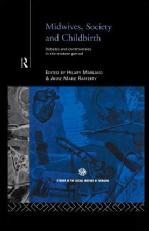
Midwives, Society and Childbirth: Debates and Controversies in the Modern PeriodHilary Marland and Anne Marie Rafferty (editors), London and New York: Routledge, 1997
Midwives, Society and Childbirth is the first book to examine midwives' lives and work in the nineteenth and twentieth centuries on a national and international scale. Focusing on six countries from Europe, the approach is interdisciplinary with the studies written by a diverse team of social, medical and midwifery historians, sociologists, and those with experience in delivering childbirth services. Questioning for the first time many conventional historical assumptions, this book is fundamental to a better understanding of the effect on midwives of the unprecedented progress of science in general and obstetric science in particular from the late nineteenth century. The contributors challenge the traditional bleak picture of midwives' decline in the face of institutional obstetrics, medical technology, and the growing power of the medical profession, while stressing the importance of regional influences and locality.
- Marland, Hilary - 06 - Illness and Healing Alternatives in Western Europe
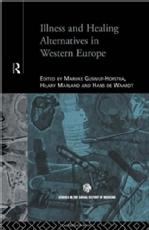
Illness and Healing Alternatives in Western EuropeMarijke Gijswit-Hofstra,
- Marland, Hilary - 07 - The Task of Healing: Medicine, Religion and Gender in England and the Netherlands 1450-1800

The Task of Healing: Medicine, Religion and Gender in England and the Netherlands 1450-1800Hilary Marland and Margaret Pelling (editors), Rotterdam: Erasmus Publishing, 1996
- Marland, Hilary - 08 - The Art of Midwifery: Early Modern Midwives in Europe
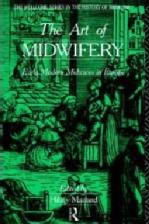
The Art of Midwifery: Early Modern Midwives in EuropeHilary Marland (editor), London and New York: Routledge, 1993
The Art of Midwifery is the first book to examine midwives' lives and work across Europe in the early modern period. Drawing on a vast range of archival material from England, Holland, Germany, France, Italy and Spain, the contributors show the diversity in midwives' practices, competence, socio-economic background and education, as well as their public function and image. The Art of Midwifery is an excellent resource for students of women's history, social history and medical history.
- Marland, Hilary - 09 - Women and Children First: International Maternal and Infant Welfare, 1870-1945

Women and Children First: International Maternal and Infant Welfare, 1870-1945Valerie Fildes, Lara Marks, Hilary Marland (editors), Routledge 1992
The International Maternal and Infant Welfare movement of the last decades of the 19th century and first decades of the 20th was a direct response to high maternal and infant mortality rates and falling marital fertility in most countries of the world. In some it was given impetus by major conflicts such as the Boer War and World War I, which decimated populations, robbed nations of their young men and concentrated attention on ensuring the survival of future generations to people lands and empires. Imperialist concerns were bolstered by a range of economic and humanitarian motivations and the desire to save the lives of mothers and young children. "Women and Children First" examines these efforts to reduce maternal and infant deaths in five continents from Australia, South Africa, Burma and Malaya to Britain, Holland and North America. Obstetric services, maternity nursing, hospital facilities, infant welfare services, and financial assistance varied greatly from country to country. Within individual countries the variation in the amount of help provided could also be great.
- Marland, Hilary - 10 - Medicine and Society in Wakefield and Huddersfield 1780-1870
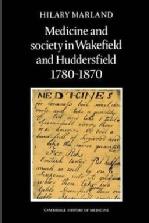
Medicine and Society in Wakefield and Huddersfield 1780-1870Hilary Marland, Cambridge University Press 1987
This ambitious book presents an across-the-board study of medicine, in any urban centre, for any period of British history. By selecting Wakefield and Huddersfield as contrasting types of northern towns, and examining in details their systems of medical care, Dr Marland has written a local history that says something important about the country as a whole. Wakefield and Huddersfield contrasted in their economic demographic and social development during the late eighteenth and early nineteenth centuries, allowing an effective comparative analysis of medical facilities in the two communities. By drawing on diverse sources: from Poor Law and philanthropy to self-help organisations, fringe medicine and medical practice, the book places the development of medical services against the backdrop of the communities in which they evolved, their class structure, organization and social, civic and economic developments.
- Marland, Hilary - 11 - Mother and Child were Saved: The Memoirs (1693-1740) of the Frisian Midwife Catharina Schrader
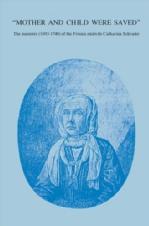
'Mother and Child were Saved'. The Memoirs (1693-1740) of the Frisian Midwife Catharina SchraderHilary Marland, Amsterdam: Editions Rodopi 1987
"Mother and Child were Saved" features a translation of the memoirs that Frisian midwife, Catharina Schrader had written in the late 17th and the early 18th centuries. These were extracted from her notes that documented almost 3000 deliveries over the course of Schrader's career as a midwife. The memoir, exhibited around 100 of the most complicated that Schrader had helped with. These included both mother and child who had died, some where only the child died, some where one of a set of multiples lived, some where both lived happily. Though the essays and the introduction focus on the medical aspects of Schrader's career, the social aspect as a female midwife in a period of medicalized transition cannot be overlooked. One can see the burgeoning reticence emanate even from Schrader herself towards midwives who were incompetent and merely "tortured" their patients. However, this Memoir is integral for any study of midwifery in Europe during the early modern period.
- Marshall, Peter - 01 - Invisible Worlds: Death, Religion And The Supernatural In England, 1500-1700
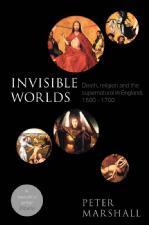
Invisible Worlds: Death, Religion And The Supernatural In England, 1500-1700Peter Marshall, SPCK Publishing 2017
Following a masterly interpretative introduction, Peter Marshall traces the effects of the Reformers' assaults on established beliefs about the afterlife. He shows how debates about purgatory and the nature of hellfire acted as unwitting agents of modernization. He then turns to popular beliefs about angels, ghosts and fairies, and considers how these were reimagined and reappropriated when cut from their medieval moorings.
'Invisible Worlds offers convincing proof of the central role played by conceptions of the supernatural and the afterlife in the religious upheavals of the early modern period . . . Peter Marshall's work is indispensable reading for anyone who desires to understand the intellectual and spiritual shaping of early modern England and of the Western imagination as well.'
Carlos Eire, Professor of History and Religious Studies, Yale University'With characteristic elegance and subtlety, Peter Marshall . . . shows how pastoral imperative sometimes bowed to popular belief, and how, simultaneously, Protestantism sowed the seeds of scepticism about the supernatural. Full of intriguing insights, Invisible Worlds will be warmly welcomed by scholars, students and general readers alike.'
Alexandra Walsham, Professor of Modern History, University of Cambridge- Marshall, Peter - 02 - 1517: Martin Luther and the Invention of the Reformation
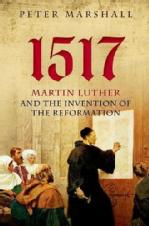
1517: Martin Luther and the Invention of the ReformationPeter Marshall, OUP Oxford 2017
Martin Luther's posting of the 95 Theses to the door of the Castle Church in Wittenberg on 31 October 1517 is one of the most famous events of Western history. It inaugurated the Protestant Reformation, and has for centuries been a powerful and enduring symbol of religious freedom of conscience, and of righteous protest against the abuse of power.
But did it actually really happen?
In this engagingly-written, wide-ranging and insightful work of cultural history, leading Reformation historian Peter Marshall reviews the available evidence, and concludes that, very probably, it did not. The theses-posting is a myth. And yet, Marshall argues, this fact makes the incident all the more historically significant. In tracing how - and why - a 'non-event' ended up becoming a defining episode of the modern historical imagination. Marshall compellingly explores the multiple ways in which the figure of Martin Luther, and the nature of the Reformation itself, have been remembered and used for their own purposes by subsequent generations of Protestants and others - in Germany, Britain, the United States and elsewhere.
As people in Europe, and across the world, prepare to remember, and celebrate, the 500th anniversary of Luther's posting of the theses, this book offers a timely contribution and corrective. The intention is not to 'debunk', or to belittle Luther's achievement, but rather to invite renewed reflection on how the past speaks to the present - and on how, all too often, the present creates the past in its own image and likeness.
- Marshall, Peter - 03 - Heretics and Believers: A History of the English Reformation
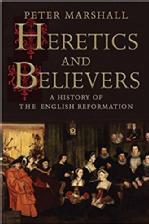
Heretics and Believers: A History of the English ReformationPeter Marshall, Yale University Press 2017
Centuries on, what the Reformation was and what it accomplished remain deeply contentious. Peter Marshall's sweeping new history-the first major overview for general readers in a generation-argues that sixteenth-century England was a society neither desperate for nor allergic to change, but one open to ideas of "reform" in various competing guises. King Henry VIII wanted an orderly, uniform Reformation, but his actions opened a Pandora's Box from which pluralism and diversity flowed and rooted themselves in English life. With sensitivity to individual experience as well as masterfully synthesizing historical and institutional developments, Marshall frames the perceptions and actions of people great and small, from monarchs and bishops to ordinary families and ecclesiastics, against a backdrop of profound change that altered the meanings of "religion" itself. This engaging history reveals what was really at stake in the overthrow of Catholic culture and the reshaping of the English Church.
- Marshall, Peter - 04 - The Oxford Illustrated History of the Reformation
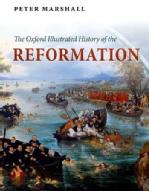
The Oxford Illustrated History of the ReformationPeter Marshall, OUP 2015
The Reformation was a seismic event in history, whose consequences are still working themselves out in Europe and across the world. The protests against the marketing of indulgences staged by the German monk Martin Luther in 1517 belonged to a long-standing pattern of calls for internal reform and renewal in the Christian Church. But they rapidly took a radical and unexpected turn, engulfing first Germany and then Europe as a whole in furious arguments about how God's will was to be discerned, and how humans were to be 'saved'.
However, these debates did not remain confined to a narrow sphere of theology. They came to reshape politics and international relations; social, cultural, and artistic developments; relations between the sexes; and the patterns and performances of everyday life. They were also the stimulus for Christianity's transformation into a truly global religion, as agents of the Roman Catholic Church sought to compensate for losses in Europe with new conversions in Asia and the Americas.
Covering both Protestant and Catholic reform movements, in Europe and across the wider world, this beautifully illustrated volume tells the story of the Reformation from its immediate, explosive beginnings, through to its profound longer-term consequences and legacy for the modern world. The story is not one of an inevitable triumph of liberty over oppression, enlightenment over ignorance. Rather, it tells how a multitude of rival groups and individuals, with or without the support of political power, strove after visions of 'reform'. And how, in spite of themselves, they laid the foundations for the plural and conflicted world we now inhabit.
- Marshall, Peter - 05 - The Reformation: A Very Short Introduction
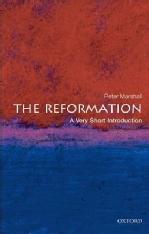
The Reformation: A Very Short IntroductionPeter Marshall, Oxford 2009
The Reformation transformed Europe, and left an indelible mark on the modern world. It began as an argument about what Christians needed to do to be saved, but rapidly engulfed society in a series of fundamental changes. This Very Short Introduction provides a lively and up-to-date guide to the process. It explains doctrinal debates in a clear and non-technical way, but is equally concerned to demonstrate the effects the Reformation had on politics, society, art, and minorities.
Peter Marshall argues that the Reformation was not a solely European phenomenon, but that varieties of faith exported from Europe transformed Christianity into a truly world religion. The complex legacy of the Reformation is also assessed; its religious fervour produced remarkable stories of sanctity and heroism, and some extraordinary artistic achievements, but violence, holy war, and martyrdom were equally its products. A paradox of the Reformation - that it intensified intolerance while establishing pluralism - is one we still wrestle with today.
- Marshall, Peter - 06 - Catholic Gentry in English Society: The Throckmortons of Coughton from Reformation to Emancipation
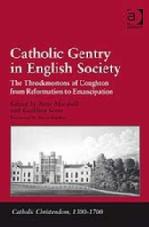
Catholic Gentry in English Society: The Throckmortons of Coughton from Reformation to EmancipationPeter Marshall and Geoffrey Scott (editors), Aldershot 2009
This volume advances scholarly understanding of English Catholicism in the early modern period through a series of interlocking essays on single family: the Throckmortons of Coughton Court, Warwickshire, whose experience over several centuries encapsulates key themes in the history of the Catholic gentry. Despite their persistent adherence to Catholicism, in no sense did the Throckmortons inhabit a 'recusant bubble'. Family members regularly played leading roles on the national political stage, from Sir George Throckmorton's resistance to the break with Rome in the 1530s, to Sir Robert George Throckmorton's election as the first English Catholic MP in 1831.
Taking a long-term approach, the volume charts the strategies employed by various members of the family to allow them to remain politically active and socially influential within a solidly Protestant nation. In so doing, it contributes to ongoing attempts to integrate the study of Catholicism into the mainstream of English social and political history, transcending its traditional status as a 'special interest' category, remote from or subordinate to the central narratives of historical change. It will be particularly welcomed by historians of the sixteenth through to the nineteenth century, who increasingly recognise the importance of both Catholicism and anti-Catholicism as central themes in English cultural and political life.
- Marshall, Peter - 07 - Mother Leakey & the Bishop: A Ghost Story
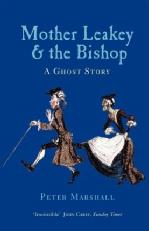
Mother Leakey & the Bishop: A Ghost StoryPeter Marshall, Oxford 2007
Halloween 1636: sightings of the ghost of an old woman begin to be reported in the small English coastal town of Minehead, and a royal commission is sent to investigate. December 1640: a disgraced Protestant bishop is hanged in the Irish capital, Dublin, after being convicted of an 'unspeakable' crime.
In this remarkable piece of historical detective work, Peter Marshall sets out to uncover the intriguing links between these two seemingly unconnected events.
The result is a compelling tale of dark family secrets, of efforts to suppress them, and of the ways in which they finally come to light. It is also the story of a shocking seventeenth-century Church scandal which cast its shadow over religion and politics in Britain and Ireland for the best part of three centuries, drawing in a host of well known and not-so-well-known characters along the way, including Jonathan Swift, Samuel Taylor Coleridge, and Walter Scott.
A fascinating story in its own right, Mother Leakey and the Bishop is also a sparkling demonstration of how the telling of stories is central to the way we remember the past, and can become part of the fabric of history itself.
- Marshall, Peter - 08 - Angels in the Early Modern World
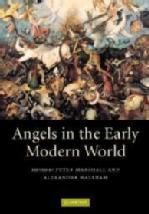
Angels in the Early Modern WorldPeter Marshall and Alexandra Walsham (editors), Cambridge 2006
Belief in the importance of angels was as widespread and intense in the early modern era as it had been in the middle ages. This volume is the first to consider how ideas about the nature, existence and activities of angels negotiated the religious, intellectual and cultural upheavals of the sixteenth and seventeenth centuries. The contributors explore the fate and fortunes of these heavenly protectors and messengers against the backdrop of the Renaissance and Reformation and in the context of scientific change. Ranging from the British Isles and continental Europe to New England and Latin America, they consider how angels were implicated in the processes of Protestant and Catholic renewal, their relationship with witchcraft and magic, and their representation in literature and art. Based on original research, the essays offer genuinely fresh insight into the moments and movements that defined the early modern world.
- Marshall, Peter - 09 - Religious Identities in Henry VIII's England

Religious Identities in Henry VIII's EnglandPeter Marshall, Aldershot 2006
Henry VIII's decision to declare himself supreme head of the church in England, and thereby set himself in opposition to the authority of the papacy, had momentous consequences for the country and his subjects. At a stroke people were forced to reconsider assumptions about their identity and loyalties, in rapidly shifting political and theological circumstances. Whilst many studies have investigated Catholic and Protestant identities during the reigns of Elizabeth and Mary, much less is understood about the processes of religious identity-formation during Henry's reign.
In this volume Peter Marshall explores a wide range of evidence that underlines the complex web of overlapping and competing identities that people were forced to assume as a religiously conservative king sought to take control of his national church. Investigating broad issues of conversion, polemic and propaganda, scripture, exile, forgery and miracles, as well as looking at specific cases of individuals and events, a rich picture is built up of the ambiguities and paradoxes of the early reformation process in England.
- Marshall, Peter - 10 - Reformation England 1480-1642
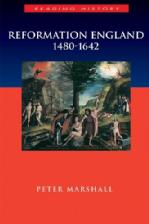
Reformation England 1480-1642Peter Marshall, London 2003
There is a growing perception among scholars that the English (and Welsh) experienced a `Long Reformation', whose roots lie in the fifteenth century, and whose effects were still being felt well into the seventeenth. Yet general surveys of the Reformation often begin the story in 1529, and most draw to a close at some point in the sixteenth century. This book insists that to make sense of the Reformation it is necessary to adopt a less restricted view-point. The subject is not merely the changes to official doctrine and ritual initiated by Henry VIII and concluded by Elizabeth I, but a fundamental cultural transformation which arguably did more than any other process to shape the kind of society England was to become in modern times. Reformation England combines reassessment of familiar debates and topics with introductions to newer historiographical concerns: religious life before the Reformation; the early evangelical movement; aims and achievements of the Henrician, Edwardian, and Marian Reformations; meanings of `puritanism' and `catholicism' in the later sixteenth and seventeenth centuries; the nature of religious `conformity'; religious conflict and the advent of civil war. The book addresses a problem whose ramifications are still with us: why the English became divided over religion, and why, despite the efforts of a succession of governments, those divisions could not be healed.
- Marshall, Peter - 11 - Beliefs and the Dead in Reformation England
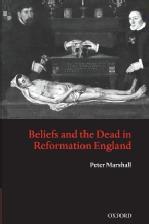
Beliefs and the Dead in Reformation EnglandPeter Marshall, Oxford 2002
This is the first comprehensive study of one of the most important aspects of the Reformation in England: its impact on the status of the dead. Protestant reformers insisted vehemently that between heaven and hell there was no 'middle place' of purgatory where the souls of the departed could be assisted by the prayers of those still living on earth. This was no remote theological proposition, but a revolutionary doctrine affecting the lives of all sixteenth-century English people, and the ways in which their Church and society were organized.
This book illuminates the (sometimes ambivalent) attitudes towards the dead to be discerned in pre-Reformation religious culture, and traces (up to about 1630) the uncertain progress of the 'reformation of the dead' attempted by Protestant authorities, as they sought both to stamp out traditional rituals and to provide the replacements acceptable in an increasingly fragmented religious world. It also provides detailed surveys of Protestant perceptions of the afterlife, of the cultural meanings of the appearance of ghosts, and of the patterns of commemoration and memory which became characteristic of post-Reformation England. Together these topics constitute an important case-study in the nature and tempo of the English Reformation as an agent of social and cultural transformation.
The book speaks directly to the central concerns of current Reformation scholarship, addressing questions posed by 'revisionist' historians about the vibrancy and resilience of traditional religious culture, and by 'post-revisionists' about the penetration of reformed ideas. Dr Marshall demonstrates not only that the dead can be regarded as a significant 'marker' of religious and cultural change, but that a persistent concern with their status did a great deal to fashion the distinctive appearance of the English Reformation as a whole, and to create its peculiarities and contradictory impulses.
- Marshall, Peter - 12 - The Beginnings of English Protestantism

The Beginnings of English ProtestantismPeter Marshall and Alec Ryrie (editors), Cambridge 2002
This collection of essays examines the traumatic religious upheavals of early- and mid-sixteenth century England from the point of view of the early Protestants, a group which has been seriously neglected by recent scholarship. Leading British and American scholars re-examine early Protestantism, arguing that it was a complex movement which could have evolved in a number of directions. They explore its approach to issues of gender roles, the place of printing and print culture, and the ways in which Protestantism continued to be influenced by medieval religious culture.
- Marshall, Peter - 13 - The Place of the Dead: Death and Remembrance in Late Medieval and Early Modern Europe
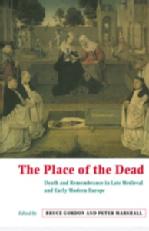
The Place of the Dead: Death and Remembrance in Late Medieval and Early Modern EuropePeter Marshall and Bruce Gordon (editors), Cambridge 2000
Although much has been published on the social history of death, this is the first book to give a comprehensive account of attitudes toward the dead--above all the "placing" of the dead, in physical, spiritual and social terms--in order to reveal the social and religious outlook of past societies. The contributions range widely geographically, from Scotland to Transylvania, and address a spectrum of themes: attitudes toward the corpse, patterns of burial, forms of commemoration, the treatment of dead infants, the nature of the afterlife, and ghosts.
- Marshall, Peter - 14 - The Impact of the English Reformation 1500-1640

The Impact of the English Reformation 1500-1640Peter Marshall (editor), London 1997
The English Reformation remains deeply controversial. While there is a growing perception that the English experienced a 'long Reformation', that it was a protracted process rather than an 'event', very significant historiographical differences remain over the pace of change, the means of implementation, and the degree of enthusiasm with which the English people experienced the dismantling of their medieval Catholic culture. How widespread was the appeal of early Protestantism in England, and what, if anything, did it owe to native roots? How effectively was religious change enacted in the localities, and how did local communities react to the swings of official policy? In what sense was England a 'Protestant nation' by the early seventeenth century? How much continuity remained with the Catholic past?
The contributions in this book identify and, in different and sometimes contradictory ways, attempt to resolve these and other questions. It is structured in three sections that combine a thematic focus with an overall sense of chronological development, exploring the English Reformation in terms of its origins, implementation, and outcomes.
- Marshall, Peter - 15 - The Catholic Priesthood and the English Reformation
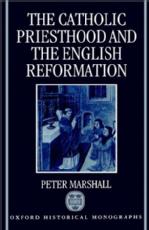
The Catholic Priesthood and the English ReformationPeter Marshall, Ocford 1994
In this scholarly new study, Peter Marshall offers a fresh look at the impact of the English Reformation at parish level. The religious changes of Henry VIII and Edward VI had a profound effect upon the clergy of the English church, raising questions as to its status, jurisdiction, and proper place in the divine scheme of salvation. This is the first full examination of the cumulative impact of these changes upon the relationship between priests in the parishes and the lay men and women who depended upon them for spiritual nourishment and religious instruction, and who not infrequently found them wanting in these and other respects. It provides a perceptive exploration of the role of the Catholic priesthood in the church and in the life of the community. Using a wide range of contemporary sources, Dr Marshall demonstrates how the practical consequences of the Reformation undermined the fragile modus vivendi that had sustained the late medieval system.
- Mick, Christoph - 01 - Lemberg, Lwów, L'viv, 1914‒1947: Violence and Ethnicity in a Contested City
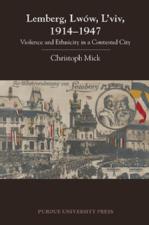
Lemberg, Lwów, L'viv, 1914‒1947: Violence and Ethnicity in a Contested CityChristoph Mick, Purdue University Press 2015
Known as Lemberg in German and Lwów in Polish, the city of L’viv in modern Ukraine was in the crosshairs of imperial and national aspirations for much of the twentieth century. This book tells the compelling story of how its inhabitants (Roman Catholic Poles, Greek Catholic Ukrainians, and Jews) reacted to the sweeping political changes during and after World Wars I and II. The Eastern Front shifted back and forth, and the city changed hands seven times. At the end of each war, L'viv found itself in the hands of a different state.
While serious tensions had existed among Poles, Ukrainians/Ruthenians, and Jews in the city, before 1914 eruptions of violence were still infrequent. The changes of political control over the city during World War I led to increased intergroup frictions, new power relations, and episodes of shocking violence, particularly against Jews. The city’s incorporation into the independent Polish Republic in November 1918 after a brief period of Ukrainian rule sparked intensified conflict. Ukrainians faced discrimination and political repression under the new government, and Ukrainian nationalists attacked the Polish state. In the 1930s, anti-Semitism increased sharply. During World War II, the city experienced first Soviet rule, then Nazi occupation, and finally Soviet conquest. The Nazis deported and murdered nearly all of the city’s large Jewish population, and at the end of the war the Soviet forces expelled the city’s Polish inhabitants.
Based on archival research conducted in L’viv, Kiev, Warsaw, Vienna, Berlin, and Moscow, as well as an array of contemporary printed sources and scholarly studies, this book examines how the inhabitants of the city reacted to the changes in political control, and how ethnic and national ideologies shaped their dealings with each other. An earlier German version of this volume was published as Kriegserfahrungen in einer multiethnischen Stadt: Lemberg 1914‒1947 (2011).
- Mick, Christoph - 02 - Kriegserfahrungen in einer multiethnischen Stadt. Lemberg 1914-1947
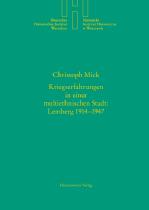
Kriegserfahrungen in einer multiethnischen Stadt. Lemberg 1914-1947[War Experiences in a Multi-Ethnic City: Lviv 1914-1947]
Christoph Mick, Wiesbaden: Harrassowitz 2010
Focusing on Lviv, Christoph Mick’s Kriegserfahrungen is an essential work for understanding not the unravelling but the making of Soviet rule over much of what had once been Galicia, even if most of it addresses the period before 1944, that is, before the crucial transformative interventions of Soviet rule, the expulsion of Western Ukraine’s Poles, the full collectivisation of the peasants, and the industrialisation of Lviv. Clearly, as in the case of the Soviet collapse in 1991, the Soviet conquest of Lviv in 1939, and again in 1944, was driven by a central project of authoritarian-socialist modernity and central international strategies, depending on international politics far beyond Lviv itself. Yet the local circumstances of Sovietisation were shaped by the preceding decades. They, in turn, influenced the manner in which Soviet rule was established in Lviv and in what was turned into Western Ukraine. Soviet power dealt with and fed on what it found, even while implementing, after 1944, what Mick correctly identifies as an accelerated re-run of 1930s-style Stalinist ‘socialism building’. Local reactions to Sovietisation were conditioned not only by the experiences of the Second World War, but by decades marked by what Mick identifies as the central focus of his work, ‘the connection between war, nation-making, and the brutalization of ethnic conflict’.
The book systematically traces the history of Lviv from the nineteenth century to the aftermath of the Second World War, from inter-ethnic relationships and early nationalism in a Habsburg imperial city to post-war Sovietisation and Ukrainisation in a Soviet city, in which pre-war Jews and Poles were either dead or gone. Mick focuses on the years after the beginning of the First World War, and his narrative is structured by the regime changes (Herrschaftswechseln), conquests, occupations, demographic ruptures, social changes, and—in the case of the Second World War—genocide brought to the city by the two World Wars.
- Mick, Christoph - 03 - Forschen für Stalin. Deutsche Fachleute in der sowjetischen Rüstungsindustrie 1945-1958
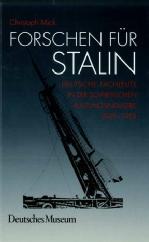
Forschen für Stalin. Deutsche Fachleute in der sowjetischen Rüstungsindustrie 1945-1958[Search for Stalin: German Specialists in the Soviet Rüstungsindustrie, 1945-1958]
Christoph Mick, Munich, Vienna: Oldenbourg Verlag 2001
Technology transfer belongs among the core topics of the history of technology. One of its most intriguing chapters is the transfer of Third Reich high technology to the victorious powers after World War II. Even before the end of the war, the Allies started a race for German know-how and signaled that the "hot" conflict would be followed by a "cold" war. How this race started, the different motives and strategies of the Allies, and the outcomes they attained—these are some of the questions that Christoph Mick seeks to answer in this book.
From these questions, it becomes clear that the title—"Developing for Stalin"—indicates the book's content only in part. Mick does not limit his investigation to the employment of German specialists by the Soviet defense industry, but extends his analysis to include ways in which the Western allies acquired knowledge and experts from Germany. He also goes beyond the immediate Stalinist era. But the main part of his study does deal with the exploitation of German specialists within the Soviet military-industrial complex. He describes precisely the areas where the Germans were deployed. On the basis of hitherto unavailable archival data, he provides evidence for the assumption that the Soviets transferred not just scientists and engineers, as the Americans and the British did, but entire working groups, including skilled labor and auxiliary personnel.
- Mick, Christoph - 04 - Sowjetische Propaganda, Fünfjahrplan und deutsche Russlandpolitik 1928-1932
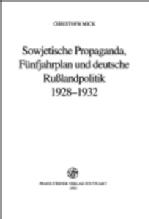
Sowjetische Propaganda, Fünfjahrplan und deutsche Russlandpolitik 1928-1932[Soviet Propaganda, Five Year Plan, and Germany's Russia Policy from 1928-1932]
Christoph Mick, Stuttgart: Steiner Verlag 1995
Christoph Mick studies a five-year period of the German-Soviet diplomatic relations and their propaganda background music, and also the Soviet and German domestic politics that had influence. In addition, Christoph Mick considers the military cooperation of the two States to undermine the Treaty of Versailles and the benevolent support - on the one hand - and the observation of suspicious - on the other – of the Communist Party of Germany as an offshoot of the Communist International.
- Molà, Luca - 01 - Threads of Global Desire: Silk in the Pre-modern World
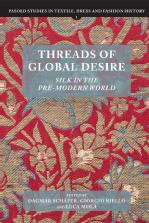
Threads of Global Desire: Silk in the Pre-modern WorldSilk has long been a global commodity that, because of its exceptional qualities, high value and relative portability, came to be traded over very long distances. Similarly, the silk industry - from sericulture to the weaving of cloth - was one of the most important fields of production in the medieval and early modern world. The production and consumption of silks spread from China to Japan and Korea and travelled westward as far as India, Persia and the Byzantine Empire, Europe, Africa and the Americas. As contributors to this book demonstrate, in this process of diffusion silk fostered technological innovation and allowed new forms of organization of labour to emerge. Its consumption constantly reshaped social hierarchies, gender roles, aesthetic and visual cultures,as well as rituals and representations of power.
Threads of Global Desire is the first attempt at considering a global history of silk in the pre-modern era. The book examines the role of silk production and use in various cultures and its relation to everyday and regulatory practices. It considers silk as a major force of cross cultural interaction through technological exchange and trade in finished and semi-finished goods. Silks mediated design and a taste for luxuries and were part of gifting practices in diplomatic and private contexts. Silk manufacturing also fostered the circulation of skilled craftsmen, connecting different centres and regions across continents and linking the countryside to urban production.
- Molà, Luca - 02 - Il Rinascimento italiano e l’Europa: Volume Terzo
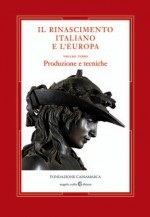
Il Rinascimento italiano e l’Europa: Volume Terzo[The Italian Renaissance and Europe: Volume Three]
Luca Molà and Philippe Braunstein (editors), Angelo Colla Editore, Treviso-Vicenza 2007
The third volume of the series leads us to the knowledge of the production and of the techniques that were developed in Italy during the Renaissance to meet the new demands of luxury and consumption economy pursued by the courts, by the nobility and the bourgeoisie in Italy and that spread throughout Europe in the wake of craftsmen, technicians, Chief artists, codes and books. Extraordinary, in this volume, the iconographic exhibition of artefacts: by machines for research and exploitation of energy sources, scientific instruments for the measurement of time and space, the variety of goldsmith productions, glass, bronzes, ceramics, textiles and tapestries, armour and artillery.
- Molà, Luca - 03 - La seta in Italia dal Medioevo al Seicento. Dal baco al drappo
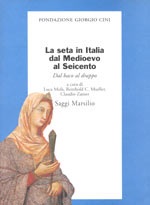
La seta in Italia dal Medioevo al Seicento. Dal baco al drappo[Silk in Italy from the Middle Ages to the 17th Century: From the Silkworm to the Fabrics]
Luca Molà, Reinhold C. Mueller, Claudio Zanier (editors), Marsilio: Venice 2000
The essays collected in this work are the result of interdisciplinary work which put studies of economic and social history, techniques, art history, architecture and literature in relation but also techniques of the industrial production of silk and fabrics. These researches demonstrate how, between the 14th and the 17th centuries, Italians managed to conquer first place in silk on the main international markets.
- Molà, Luca - 04 - The Silk Industry of Renaissance Venice
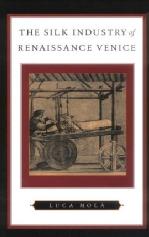
The Silk Industry of Renaissance VeniceLuca Molà, Johns Hopkins University Press, Baltimore-London 2000
The manufacture of luxury textiles, such as silk, was central to an Italian Renaissance economy based on status and conspicuous consumption. From the rapidly changing fashions that drove demand to the jobs created for craftsmen, weavers, and merchants, the wealth and prestige associated with silk throughout Europe made it Italy's leading export industry. In this important book, Luca Molà examines the silk industry in Renaissance Venice amid changing markets, suppliers, producers, and government regulations.
Drawing on archival research and a vast amount of European scholarship, Molà documents the innovations Venetians made in manufacturing and marketing to spur the silk industry. He uncovers the alliance between manufacturers and government to promote the industry in a changing international economic environment. Through flexible laws, quality was regulated to meet the varying requirements of an increasing range of customers. Molà also analyzes state policy that favored the development and organization of silk producers throughout the Terraferma. His findings contribute in an important way to the ongoing scholarly assessment of Venice's place in the economy of the Renaissance and the Mediterranean world.
- Molà, Luca - 05 - La comunità dei lucchesi a Venezia: Immigrazione e industria della seta nel tardo medioevo
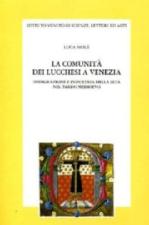
La comunità dei lucchesi a Venezia: Immigrazione e industria della seta nel tardo medioevo[The Community of Lucca to Venice: Immigration and the Silk Industry in the Late Middle Ages]
Luca Molà, Istituto Veneto di Scienze, Lettere ed Arti, Venice 1994
P
- Peplow, Simon - Race and Riots in Thatcher's Britain
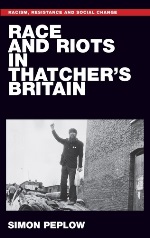
Race and Riots in Thatcher's BritainSimon Peplow, Manchester University Press 2019
This powerful and original book locates the anti-police violence that spread across England in 1980-1 within a longer struggle against racism and disadvantage faced by black Britons, which had seen a growth in more militant forms of resistance since the Second World War. It explains these disturbances as 'collective bargaining by riot' - attempts to increase political inclusion by this marginalised group. Through case studies of Bristol, Brixton and Manchester, the book explores the actions of community organisations in the aftermath of disorders. Highlighting the political activities of black Britons and the often-problematic reliance upon 'official' sources when forming historical narratives, it demonstrates the contested value awarded to public inquiries - contrastingly viewed by black Britons as either a method for increased political participation or simply a governmental diversionary tactic.
- Philp, Mark - 01 - On Liberty, Utilitarianism and Other Essays
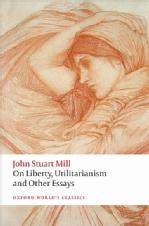
On Liberty, Utilitarianism and Other EssaysJohn Stuart Mill (Author),
- Philp, Mark - 02 - Re-Imagining Democracy in the Age of Revolutions: America, France, Britain, Ireland 1750-1850
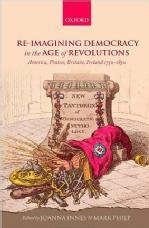
Re-Imagining Democracy in the Age of Revolutions: America, France, Britain, Ireland 1750-1850Mark Philp and Joanna Innes (editors), Cambridge University Press 2013
Re-imagining Democracy in the Age of Revolutions charts a transformation in the way people thought about democracy in the North Atlantic region in the years between the American Revolution and the revolutions of 1848. In the mid-eighteenth century, 'democracy' was a word known only to the literate. It was associated primarily with the ancient world and had negative connotations: democracies were conceived to be unstable, warlike, and prone to mutate into despotisms. By the mid-nineteenth century, however, the word had passed into general use, although it was still not necessarily an approving term. In fact, there was much debate about whether democracy could achieve robust institutional form in advanced societies.
In this volume, an international cast of contributors shows how common trends developed throughout the United States, France, Britain, and Ireland, particularly focussing on the era of the American, French, and subsequent European revolutions. Re-imagining Democracy in the Age of Revolutions argues that 'modern democracy' was not invented in one place and then diffused elsewhere, but instead was the subject of parallel re-imaginings, as ancient ideas and examples were selectively invoked and reworked for modern use. The contributions significantly enhance our understanding of the diversity and complexity of our democratic inheritance.
- Philp, Mark - 03 - Reforming Ideas in Britain: Politics and Language in the Shadow of the French Revolution, 1789-1815
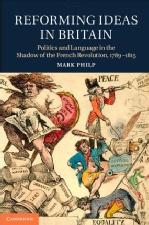
Reforming Ideas in Britain: Politics and Language in the Shadow of the French Revolution, 1789-1815Mark Philp, Cambridge University Press 2013
Between 1789 and 1815, Britain faced a surge of challenges brought about by the French Revolution. Growing tensions with France, then the outbreak of war, exacerbated domestic political controversy, giving rise to new forms of political protest, to which the government responded with ever-increasing severity. Reforming Ideas in Britain brings together a series of essays to provide a vibrant historiography of Britain's political thought and movements during the 1790s and beyond. Challenging traditional perceptions of the period, Philp prompts us to reconsider the weight of various ideas, interpretations and explanations of British politics and language; showing us instead that this dynamic world of popular politics was at once more chaotic, innovative and open-minded than historians have typically perceived it to be. This is an essential interdisciplinary text for scholars of history, political theory and romanticism that offers a fresh perspective on radicalism, loyalism and republicanism in Britain during the French Revolution.
- Philp, Mark - 04 - William Godwin, Enquiry Concerning Political Justice
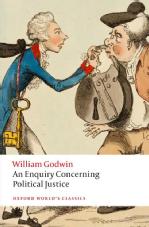
William Godwin, Enquiry Concerning Political JusticeMark Philp (editor), World's Classics 2013
'To a rational being there can be but one rule of conduct, justice, and one mode of ascertaining that rule, the exercise of his understanding.' Godwin's Political Justice is the founding text of philosophical anarchism. Written in the immediate aftermath of the French Revolution, it exemplifies the political optimism felt by many writers and intellectuals. Godwin drew on enlightenment ideas and his background in religious dissent for the principles of justice, utility, and the sanctity of individual judgement that drove his powerful critique of all forms of secular and religious authority. He predicts the triumph of justice and equality over injustice, and of mind over matter, and the eventual vanquishing of human frailty and mortality. He also foresees the gradual elimination of practices governing property, punishment, law, and marriage and the displacement of politics by an expanded personal morality resulting from reasoned argument and candid discussion. Political Justice raises deep philosophical questions about the nature of our duty to others that remain central to modern debates on ethics and politics. This edition reprints the first-edition text of 1793, and examines Godwin's evolving philosophy in the context of his life and work.
- Philp, Mark - 05 - Machiavelli, Hobbes, & Rousseau
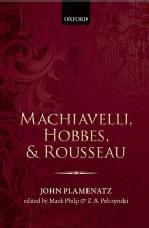
Machiavelli, Hobbes, & RousseauJohn Plamenatz (author), Mark Philp and Zbigniew Pelczynski (editors), OUP 2012
This volume presents lucid and insightful lectures on three great figures from the history of political thought, by John Plamenatz (1912-1975), a leading political philosopher of his time. He explores a range of themes in the political thought of Machiavelli, Hobbes, and Rousseau, at substantially greater length and depth than in his famous work of 1961, Man and Society. The lectures exemplify Plamenatz's view that repeated engagement with the texts of canonical thinkers can substantially enrich and expand our capacity for political reflection. Edited by Mark Philp and Zbigniew Pelczynski, the volume includes annotations to supply Plamenatz's sources and to refer readers to developments in their interpretation. A substantial introduction by Philp sets some of Plamenatz's concerns in the light of trends in recent scholarship, and illuminates the relevance of his work to the contemporary study of political thought.
- Philp, Mark - 06 - Rights of Man, Common Sense, and Other Political Writings
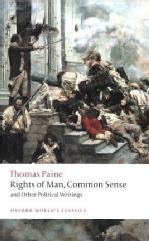
Rights of Man, Common Sense, and Other Political WritingsThomas Paine (author) and Mark Philp (editor), OUP 2008
'An army of principles will penetrate where an army of soldiers cannot ...it will march on the horizon of the world and it will conquer.' Thomas Paine was the first international revolutionary. His Common Sense (1776) was the most widely read pamphlet of the American Revolution; his Rights of Man (1791-2) was the most famous defence of the French Revolution and sent out a clarion call for revolution throughout the world. He paid the price for his principles: he was outlawed in Britain, narrowly escaped execution in France, and was villified as an atheist and a Jacobin on his return to America. Paine loathed the unnatural inequalities fostered by the hereditary and monarchical systems. He believed that government must be by and for the people and must limit itself to the protection of their natural rights. But he was not a libertarian: from a commitment to natural rights he generated one of the first blueprints for a welfare state, combining a liberal order of civil rights with egalitarian constraints. This collection brings together Paine's most powerful political writings from the American and French revolutions in the first fully annotated edition of these works.
- Philp, Mark - 07 - Political Conduct
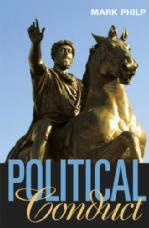
Political ConductMark Philp, Cambridge, Mass., Harvard University Press, 2007
This book explores how the processes and practices of politics shape political values, such as liberty, justice, equality, and democracy. Mining the history of political episodes and political thinkers, including Caesar and Machiavelli, Mark Philp argues that it is through political activity that "values are articulated and embraced, and they become powerful motivating forces". "Political Conduct" is thus an attempt to inform and enrich political theory - to show that its principles would be more relevant to actual politics if they were immersed in history and practice. Philp argues for a separation between moral and political philosophy and proposes that a less abstract and ideal approach to political philosophy than that provided by Rawls, Dworkin, Nagel and Cohen would be more useful in illuminating the conduct of politicians and the limitations on what they can achieve.
- Philp, Mark - 08 - Thomas Paine (Very Interesting People)
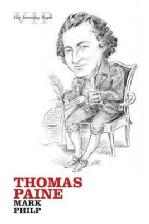
Thomas Paine (Very Interesting People)Mark Philp 2007
Definitive, concise, and very interesting... From William Shakespeare to Winston Churchill, the Very Interesting People series provides authoritative bite-sized biographies of Britain's most fascinating historical figures - people whose influence and importance have stood the test of time. Each book in the series is based upon the biographical entry from the world-famous Oxford Dictionary of National Biography.
- Philp, Mark - 09 - Resisting Napoleon: The British Response to the Threat of Invasion 1797-1815
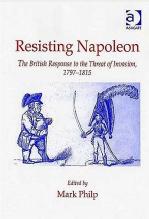
Resisting Napoleon: The British Response to the Threat of Invasion 1797-1815Mark Philp (editor), Aldershot: Ashgate 2006
The long war with Revolutionary France had a fundamental impact on British political culture. The most dramatic example of this is the mass mobilisation of the British people in response to French invasion threats throughout the last years of the century but, most spectacularly, in the period 1803-5, after the collapse of the Peace of Amiens, and the massing of an invasion fleet by Napoleon. The preparations for the threatened invasion had many dimensions including military and naval mobilization, the development of defensive earthworks and fortifications on the British Coast, the surveillance and monitoring of radicals identified with the French cause, the incitement of loyalist sentiment through caricature, newspapers, tracts and broadsides, and loyalist songs, and the construction of Napoleon as the prime enemy of British interests. Although aspects of these issues have been studied, this book is the first time that they have been brought together systematically. By bringing together historians of Britain and France to examine the dynamics of the military conflict between the two nations in this period, this book measures its impact on their domestic political cultures, and its effect on their perceptions of each other. In so doing, it will encourage scholars to further examine aspects of popular mobilisation which have hitherto been largely ignored, such as the resurgence of loyalism in 1803, and to see their contributions in the light of the dual contexts of domestic political conflict and their war with each other. By allowing scholars to focus their attention on this period of heightened tension, the book contributes both new detail to our understanding of the period and a better overall understanding of the complex place which each nation came to occupy in the consciousness of the other.
- Philp, Mark - 10 - Napoleon and the Invasion of Britain
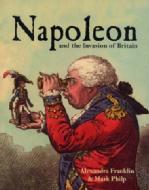
Napoleon and the Invasion of BritainMark Philp and Alexandra Franklin, Bodleian Library: Oxford 2003
Chronicling the real fear of a Napoleonic invasion of Britain from 1798 to 1805, this book reconstructs Britain's political, social and military response, and tells the story of the forces dividing the nation in the 1790s, and the debates underlying the patriotism of 1803, through a rich collection of satirical cartoons, medals, pamphlets and broadsides. Cartoons and pamphlets produced during the two invasion scares show the transformation of British politics during the wars against Revolutionary France. In 1798, Britain was racked by internal divisions, fiscal crisis, and social unrest, factors that the French invaders hoped to capitalize on, turning the invasion into a war of liberation. Five years later, the renewal of the invasion threat in 1803 led to an unprecedented mobilization of the British population - nearly half a million men volunteered to defend the country against invasion - and an outpouring of patriotic literature and images.
- Philp, Mark - 11 - The Political and Philosophical Writings of William Godwin
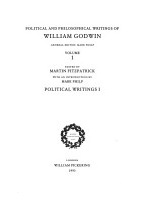
The Political and Philosophical Writings of William GodwinMark Philp (editor), Pickering & Chatto 1993
Contains all the major political, philosophical and educational writings of William Godwin, one of the foremost philosophers of his age. His work on government and individual freedom, Political Justice, made him the chief exponent of English radicalism, and a major influence on Thomas Holcroft, William Wordsworth, Samuel Taylor Coleridge and others in the radical movement of the 1790s and later. Godwin was an influential historian and educationalist. His works include historical pamphlets, polemical journalism, philosophical and educational treatises, novels and literary works. Political Justice is printed in its original edition, with variants to the manuscript and first three editions. It also includes manuscript material never before published.
- Philp, Mark - 12 - The Collected Novels and Memoirs of William Godwin

The Collected Novels and Memoirs of William GodwinWilliam Godwin (author), Mark Philp, Pamela Clemit, Maurice Hindle, Marilyn Butler (editors), Pickering & Chatto 1992
This is a collection in eight volumes of the novels and memoirs of William Godwin, one of the foremost philosophers and radical thinkers of his age. There is a general introduction covering Godwin's life and literary works and each volume is prefaced by a scholarly introduction. His monumental work on government and individual freedom, Political Justice, made him the chief philosophical exponent of English radicalism. Both his novels and his philosophical works were a major influence on Thomas Holcroft, William Wordsworth, Samuel Taylor Coleridge and others in the radical movement of the 1790s, and on William Hazlitt, Percy Bysshe Shelley and others in early nineteenth century literary circles. Caleb Williams, St Leon and Fleetwood in particular, were widely-read and influential novels when first published.
- Philp, Mark - 13 - The French Revolution and British Popular Politics
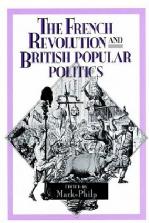
The French Revolution and British Popular PoliticsMark Philp (editor), Cambridge University Press 1991
The nine essays in this collection focus on the dynamics of British popular politics in the 1790s and on the impact of the French Revolution and the subsequent war with France. Leading scholars in the field explore the nature and origins of the ideological conflicts between reformers and loyalists, the impact of the war with France on the organisation of the British state and on its relations with its people, and the extent of the threat of revolution on both British and colonial territory. The French Revolution and British Popular Politics makes an unusually integrated and coherent collection of essays, substantially advancing knowledge in this controversial area and bringing together important work by senior figures in the field.
- Philp, Mark - 14 - Paine
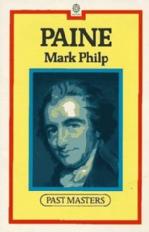
PaineMark Philp, Oxford University Press, Past Master Series, 1989
This examination of Paine's commitment to democracy and republicanism aims to show how the clear, direct style of his rhetoric is intimately bound up with the power of his political and religious ideas. Thomas Paine (1737-1809) was oulawed and burnt in effigy in his native Britain. Paine believed that government, at best a necessary evil, should be by and for the people, exercising minimal interference in society. He drafted one of the first blueprints for a welfare state and argued for the progressive taxation of property to secure a basic provision for all. His "Common Sense" (1776) was seen by some as the most important pamphlet of the American Revolution and his "Rights of Man" (1791-2) the most famous defence of the French Revolution. "The Age of Reason" (1795), his last major work, proved as damaging to the established Church as his political thought was to governments.
- Philp, Mark - 15 - Godwin's Political Justice

Godwin's Political JusticeMark Philp, Duckworth (UK) and Cornell University Press (USA), 1986
A profound study, providing important insights into Godwin's work and time. Concentrating on his initial inspirations, Philp continues with Godwin's philosophy, going into detailed analysis, continuing with the Debate on France and the ideas in Godwin's Political Justice.
- Plath, Lydia - 01 - Black and White Masculinity in the American South, 1800-2000
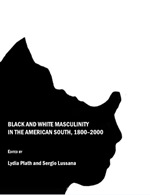
Black and White Masculinity in the American South, 1800-2000Sergio Lussana and Lydia Plath (editors), Cambridge Scholars Publishing 2009
This book consists of a range of essays written by historians and literary critics which examine the historical construction of Southern masculinities, rich and poor, white and black, in a variety of contexts, from slavery in the antebellum period, through the struggle for Civil Rights, right up to the recent South. Building on the rich historiography of gender and culture in the South undertaken in recent years, this volume aims to highlight the important role Southern conceptions of masculinity have played in the lives of Southern men, and to reflect on how masculinity has intersected with class, race and power to structure the social relationships between blacks and whites throughout the history of the South. The volume highlights the multifaceted nature of Southern masculinities, demonstrating the changing ways black and white masculinities have been both imagined and practised over the years, while also emphasizing that conceptions of black and white masculinity in the American South rarely seem to be divorced from wider questions of class, race and power.
- Poskett, James - 01 - Materials of the Mind
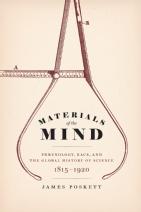
Materials of the Mind: Phrenology, Race, and the Global History of Science, 1815-1920James Poskett, University of Chicago Press 2019
Phrenology was the most popular mental science of the Victorian age. From American senators to Indian social reformers, this new mental science found supporters around the globe. Materials of the Mind tells the story of how phrenology changed the world—and how the world changed phrenology.
This is a story of skulls from the Arctic, plaster casts from Haiti, books from Bengal, and letters from the Pacific. Drawing on far-flung museum and archival collections, and addressing sources in six different languages, Materials of the Mind is an impressively innovative account of science in the nineteenth century as part of global history. It shows how the circulation of material culture underpinned the emergence of a new materialist philosophy of the mind, while also demonstrating how a global approach to history can help us reassess issues such as race, technology, and politics today.
- Pullin, Naomi - 01 - Female Friends and the Making of Transatlantic Quakerism, 1650-1750
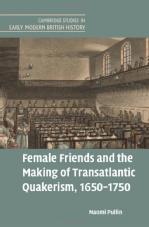
Female Friends and the Making of Transatlantic Quakerism, 1650-1750Naomi Pullin, Cambridge University Press 2018
Quaker women were unusually active participants in seventeenth- and eighteenth-century cultural and religious exchange, as ministers, missionaries, authors and spiritual leaders. Drawing upon documentary evidence, with a focus on women's personal writings and correspondence, Naomi Pullin explores the lives and social interactions of Quaker women in the British Atlantic between 1650 and 1750. Through a comparative methodology, focused on Britain and the North American colonies, Pullin examines the experiences of both those women who travelled and preached and those who stayed at home. The book approaches the study of gender and religion from a new perspective by placing women's roles, relationships and identities at the centre of the analysis. It shows how the movement's transition from 'sect to church' enhanced the authority and influence of women within the movement and uncovers the multifaceted ways in which female Friends at all levels were active participants in making and sustaining transatlantic Quakerism.
- Purseigle, Pierre - 01 - Aftermath: Legacies and Memories of War in Europe, 1918-1945-1989

Aftermath: Legacies and Memories of War in Europe, 1918-1945-1989Tim Houghton, Nicholas Martin, and Pierre Purseigle (editors), Routledge 2016
Focusing on three of the defining moments of the twentieth century - the end of the two World Wars and the collapse of the Iron Curtain - this volume presents a rich collection of authoritative essays, covering a wide range of thematic, regional, temporal and methodological perspectives. By re-examining the traumatic legacies of the century’s three major conflicts, the volume illuminates a number of recurrent yet differentiated ideas concerning memorialisation, mythologisation, mobilisation, commemoration and confrontation, reconstruction and representation in the aftermath of conflict. The post-conflict relationship between the living and the dead, the contestation of memories and legacies of war in cultural and political discourses, and the significance of generations are key threads binding the collection together. While not claiming to be the definitive study of so vast a subject, the collection nevertheless presents a series of enlightening historical and cultural perspectives from leading scholars in the field, and it pushes back the boundaries of the burgeoning field of the study of legacies and memories of war. Bringing together historians, literary scholars, political scientists and cultural studies experts to discuss the legacies and memories of war in Europe (1918-1945-1989), the collection makes an important contribution to the ongoing interdisciplinary conversation regarding the interwoven legacies of twentieth-century Europe’s three major conflicts.
- Purseigle, Pierre - 02 - Mobilisation, Sacrifice Et Citoyennete: Angleterre-France 1900-1918
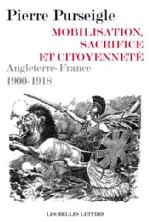
Mobilisation, Sacrifice Et Citoyennete: Angleterre-France 1900-1918[Mobilization, Sacrifice and Citizenship: England-France 1900-1918]
Pierre Purseigle, Paris: Les Belles Lettres 2013
This book offers a comparative urban history of social mobilization in France and Great Britain during the First World War. It calls into question the analytical primacy of the nation-State consolidated by British military history and, in France, by historiographical controversy. This study emphasizes the need as the interest to think the Great War is wearing below, beyond, but also across the nation. This book rejects antagonism supposed social and cultural conflict stories, artificially invoked in the academic field-specific struggles. It strives to give their place to material, cultural and political of wartime mobilization determinants.
This book replaces the experience of war in time along the process of nationalization and modernization in Europe. It highlights the emergence of a genuine ethic of the mobilizations and gives to see reconfigurations of citizenship caused by the war. Finally, it suggests a redefinition of the contours of French and British States in 1914-1918.
- Purseigle, Pierre - 03 - Le Monde Britannique, 1815-1931
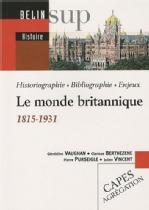
Le Monde Britannique, 1815-1931[The British World, 1815-1931]
Pierre Purseigle, Géraldine Vaughan, Julien Vincent, Clarisse Berthezène
Paris, Editions Belin, 2010
As decolonization progressed, historical research relating to the UK world has ceased to grow. Deeply renewed by post-colonial studies at the end of the 1970s, the new British historiography offers a transnational approach and regards Croisés encompassing domestic history of the British Isles and colonial history. By the end of the wars Napoleonic (1815) to the adoption of the Statute of Westminster and the devaluation of the pound sterling (1931), the British World redefining itself and deploys economic, political, military, religious and cultural axes. This book first presents the various historiographical approaches to the issue and offers a guided selection of work dealing with the history of the British World. He then attaches to examine key issues of the topic: the economic forces at work. migration within the imperial space; the issue of pax britannica and the wars; urban spaces and citizenship, and the construction of knowledge.
- Purseigle, Pierre - 04 - Warfare and Belligerence: Perspectives in First World War Studies

Warfare and Belligerence: Perspectives in First World War StudiesPierre Purseigle (editor), Boston: Leiden, Brill, 2005
The essays collected here suggest some of the ways in which an interdisciplinary perspective may contribute to our understanding of the Great War. Contributors examine the relationship between the character of the war and the nature of belligerent societies, and present original research on the comparative history of the First World War. In 1914-1918, the front lines did not only separate warring nations, but also cut across belligerent societies and ultimately determined the social responses to the conflict. Indeed, the 'totalizing logic' of the First World War entailed the blurring of boundaries between combatants and non-combatants, soldier and civilian. Subjects included are operational and tactical evolution, social mobilization, military discipline and morale, prisoners of war, veterans and demobilization, religion and politics, war literature and cinema, memory and commemoration.
- Purseigle, Pierre - 05 - Uncovered Fields: Perspectives in First World War Studies
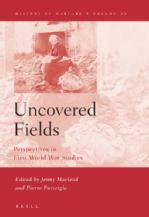
Uncovered Fields: Perspectives in First World War StudiesPierre Purseigle and Jenny Macleod (editors), Boston: Leiden, Brill, 2004
This volume presents original research on the military, social and cultural history of the First World War. Inspired by the reinvigoration of this subject area in the last decade, its chapters explore the stresses of waging a war, whose "totalizing logic" issued formidable challenges to communities, accounted for the pervasion of the conflict into the private sphere, and brought about specific intellectual responses. Subjects included are race and gender relations, shellshock, civil-military relations, social mobilization and military discipline. It encompasses an unusually broad geographical range, including papers on Britain, France and Germany, but also Belgium, the Netherlands, Austria-Hungary and Latin America. This collective undertaking will interest those who are dedicated to the comparative history of modern warfare.
R
- Read, Christopher - 01 - Stalin: From the Caucasus to the Kremlin
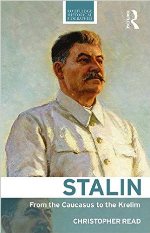
Stalin: From the Caucasus to the KremlinChristopher Read, Routledge 2016
This new biography of Stalin offers an accessible and up-to-date representation of one of the twentieth century’s defining figures, as well as new insights, analysis and illumination to deepen our understanding of his actions, intentions, and the nature of the power that he wielded.
Christopher Read examines Stalin’s contribution to and impact on Russian and world events in the first half of the twentieth century. The biography brings together the avalanche of sources and scholarship which followed the collapse of the system Stalin constructed, including the often neglected writings and speeches of Stalin himself. In addition to a detailed narrative and analysis of Stalin’s rule, chapters also cover his early years and humble beginnings in a small town at a remote outpost of the Russian Empire, his role in the revolution, his relationships with Lenin, Trotsky and others in the 1920s, and his rise to become one of the most powerful figures in human history. The book closes with an account of Stalin’s afterlife and legacy, both in the immediate aftermath of his death and in the decades since.
This concise account of Stalin’s life is the perfect introduction for students of modern Russian history.
- Read, Christopher - 02 - War and Revolution in Russia, 1914-22: The Collapse of Tsarism and the Establishment of Soviet Power
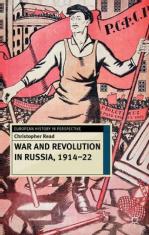
War and Revolution in Russia, 1914-22: The Collapse of Tsarism and the Establishment of Soviet PowerChristopher Read, Basingstoke and New York, Palgrave 2013
The First World War unleashed a powerful, transforming, destructive storm across the European continent. Its consequences were felt as harshly in Russia as anywhere else in the world. A spiral of chaos and violence erupted, continuing to reign throughout years of revolution and civil war.
Leading expert Christopher Read presents a cutting-edge, highly readable introduction to Russia's crisis years. Read synthesises a wealth of newly available material and treats the period 1914-22 as a whole in order to contextualise and better understand the events of 1917 and their impact. As he examines the multiple revolutions, Read asks how and why the Bolsheviks were able to survive the storm, eventually taking over the world's largest country.
- Read, Christopher - 03 - Lenin: A Revolutionary Life
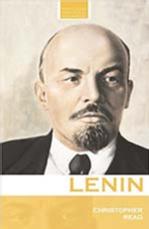
Lenin: A Revolutionary LifeChristopher Read, Routledge Historical Biographies, Abingdon and New York 2005
From a highly distinguished author on the subject, this biography is an excellent scholarly introduction to one of the key figures of the Russian Revolution and post-Tsarist Russia. Not only does it make use of archive material made newly available in the glasnost and post-Soviet eras, it re-examines traditional sources as well, providing an original interpretation of Lenin's life and historical importance.
- Read, Christopher - 04 - The Stalin Years: A Reader
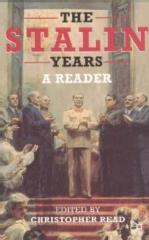
The Stalin Years: A ReaderChristopher Read (editor), Basingstoke and New York, Palgrave, 2002
Ever since his rise to power Stalin has been a controversial figure. From the hatred of his Trotsky-supporting contemporaries to the uncritical adulation of present-day followers in Russia and his native land of Georgia he has stirred passions and arguments. Traditionally, scholars, too, have been equally divided into totalitarians and revisionists. Despite the differences, however, one feature has remained constant: the vast majority of views of Stalin have been highly politically charged.
In this collection of cutting-edge research, Christopher Read guides the reader through the turbulent history of the Stalin years using post-Soviet articles which provide more balanced and scholarly assessments of the leader's time in power. The essays examine not only Stalin's central role and the key points of his rule from the late 1920s to the postwar years, but also look at Russian society as a whole. Taken together with Read's own contributions, which include an up-to-date historiographic survey, they constitute a complex and dynamic history of the central features of a terrible era.
- Read, Christopher - 05 - The Making and Breaking of the Soviet System: An Interpretation
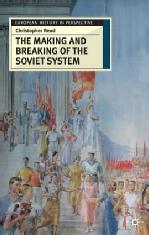
The Making and Breaking of the Soviet System: An InterpretationChristopher Read, Basingstoke and New York, Palgrave, 2001
The consequences of the Russian Revolution of 1917 have been among the most dominant shaping forces of the twentieth century, eventually dividing almost the entire globe into a battleground between capitalism and communism. The reputations of the main leaders of Russia/the Soviet Union - Lenin, Stalin, Khrushchev, Brezhnev, Gorbachev and Yeltsin - have soared and plummeted. Great achievements such as victory over Nazi Germany; putting the first satellite and human in space; building a massive industrial base and advancing the living and educational standards of the population have been undermined by political repression and incalculable human cost.
In a cool, non-polemical manner, the author shows how the contradictory parts of the Soviet experience are linked. Using post-Soviet materials and perspectives he examines the reasons for the successes and failures of the Soviet system. In particular, the book argues that the underlying reasons for the system's collapse can be found in the contradictions of the revolution which gave birth to it. The consequences are traced through the Stalin Revolution, the Great Terror, the Second World War, the Cold War, the Khrushchev and Brezhnev years down to Gorbachev's doomed attempt to transform the Soviet system. Particular attention is given to the divergence between the aspirations of the leadership and the social evolution of the ordinary Russian people. The study concludes with a survey of the post-Soviet scene from Yeltsin to Putin. The result is a volume indispensible to anyone who needs a readily comprehensible guide to the Russia that lies beyond the stereotypes.
- Read, Christopher - 06 - From Tsar to Soviets: The Russian People and Their Revolution, 1917-21
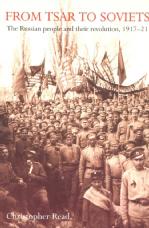
From Tsar to Soviets: The Russian People and Their Revolution, 1917-21Christopher Read, London, UCL Press; New York, Oxford University Press, 1996
This highly readable and authoritative new study of the 1917 Revolution restores to center stage the experiences of the ordinary men and women of Russia's towns and villages. By examining the revolution in the light of these experiences rather than the activities of central parties and politicians, the book challenges many commonly held assumptions and sheds new light on the realities of living through and participating in such tumultuous events. As well as putting forward a challenging and fresh interpretation of the revolution, this book provides readers with a superb synthesis of recent research, and is unrivalled in its clarity and balance.
- Read, Christopher - 07 - Culture and Power in Revolutionary Russia: The Intelligentsia and the Transition from Tsarism to Communism
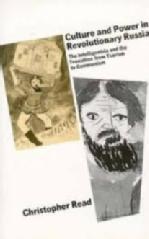
Culture and Power in Revolutionary Russia: The Intelligentsia and the Transition from Tsarism to CommunismChristopher Read, London: Macmillan 1990
This book shows that the rise of the intelligentsia occurred earlier than is normally thought, and that by 1922, rather than 1932, the underlying principles of the new Soviet government's policies towards culture had already emerged, "proto-Stalinism" being increasingly important. Various sources have been used, including Proletkul't, Moscow University and the rabfaky and the works of various individuals such as Bagdanov, Lunacharsky, Andreev, Berdiaev and Chagall. Christopher Read has written "Religion, Revolution and the Russian Intelligentsia" and has produced a video "The Decline of Tsarism".
- Read, Christopher - 08 - Religion, Revolution & the Russian Intelligentsia, 1900-1912
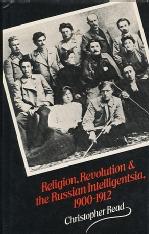
Religion, Revolution & the Russian Intelligentsia, 1900-1912Christopher Read, London: Macmillan 1979
- Richardson, Sarah - 01 - Performing the Self: Women's Lives in Historical Perspective
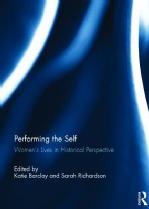
Performing the Self: Women's Lives in Historical PerspectiveSarah Richardson and Katie Barclay (editors), Routledge 2014
That the self is 'performed', created through action rather than having a prior existence, has been an important methodological intervention in our understanding of human experience. It has been particularly significant for studies of gender, helping to destabilise models of selfhood where women were usually defined in opposition to a male norm.
In this multidisciplinary collection, scholars apply this approach to a wide array of historical sources, from literature to art to letters to museum exhibitions, which survive from the medieval to modern periods. In doing so, they explore the extent that using a model of performativity can open up our understanding of women's lives and sense of self in the past. They highlight the way that this method provides a significant critique of power relationships within society that offers greater agency to women as historical actors and offers a challenge to traditional readings of women's place in society. An innovative and wide-ranging compilation, this book provides a template for those wishing to apply performativity to women's lives in historical context. This book was originally published as a special issue of Women's History Review.
- Richardson, Sarah - 02 - The Political Worlds of Women: Gender and Politics in Nineteenth Century Britain
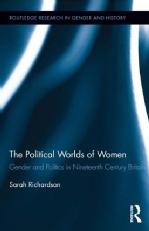
The Political Worlds of Women: Gender and Politics in Nineteenth Century Britain(Routledge Research in Gender and History)
Sarah Richardson, Routledge 2013
Traditional analyses of nineteenth-century politics have assigned women a peripheral role. By adopting a broader interpretation of political participation, the author identifies how middle-class women were able to contribute to political affairs in the nineteenth century. Examining the contribution that women made to British political life in the period 1800-1870 stimulates debates about gender and politics, the nature of authority and the definition of political culture.
This volume examines female engagement in both traditional and unconventional political arenas, including female sociability, salons, child-rearing and education, health, consumption, religious reform and nationalism. Richardson focuses on middle-class women’s social, cultural, intellectual and political authority, as implemented by a range of public figures and lesser-known campaigners. The activists discussed and their varying political, economic and religious backgrounds will demonstrate the significance of female interventions in shaping the political culture of the period and beyond.
- Richardson, Sarah - 03 - Using Computers in History

Using Computers in HistorySarah Richardson and Sonja Cameron, Palgrave 2005
Information and communications technology is now an essential tool for the historian and for anyone engaging in historical study. Today's 'history workstation' includes computers, modems, scanners, printers, digital cameras and a wide range of software applications to access the World Wide Web and to analyse historical sources. Sonja Cameron and Sarah Richardson provide a clear, jargon-free introduction which demystifies the computing skills needed for historical research.
This step-by-step guide covers all aspects of history and computing including presentation, history and the World Wide Web, databases, spreadsheets, and digitised text and images.- Richardson, Sarah - 04 - The History of the Suffrage, 1760-1867
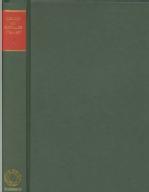
The History of the Suffrage, 1760-1867 (6 Volumes)Sarah Richardson and Anna Clark (editors), Pickering Chatto 2000
This work brings together key texts drawn from the history of suffrage advocacy and agitation. The whole issue of voting rights and representation is shown to be anchored firmly in the wider political culture of Britain and Ireland as well as the Empire as a whole. This gradual process is charted from the age of Wilkes and Cartwright and the issue of voting rights in the American colonies, throughout the events of the Romantic age, to the Great Reform Act of 1832. The later volumes span the middle years of the 19th century which saw increasing organization and mobilization on the part of the suffrage movement up until the 2nd Reform Act of 1867.
- Richardson, Sarah - 05 - Women in British Politics, 1760-1860: The Power of the Petticoat
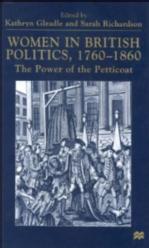
Women in British Politics, 1760-1860: The Power of the PetticoatSarah Richardson and Kathryn Gleadle (editors), Macmillan 2000
This groundbreaking volume examines women's political involvement from a variety of innovative angles. In addition to exploring literary sources and women's contribution to electoral processes, pressure group politics are examined in depth (including Jewish civil rights and the campaigns against the Corn Laws and Indian widow-burning). The attention to neglected aspects of women's political activity, such as religion, domesticity, European nationalism, empire and life-style enable this book to challenge not only the historiography of Georgian and Victorian women, but also the nature of political history itself.
- Richardson, Sarah - 06 - The Anglican Clergy and Yorkshire Politics in the Eighteenth Century
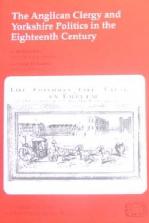
The Anglican Clergy and Yorkshire Politics in the Eighteenth CenturySarah Richardson and Richard Hall, York: Borthwick Papers 1998
- Riello, Giorgio - 01 - The Right to Dress: Sumptuary Laws in a Global Perspective, c.1200-1800
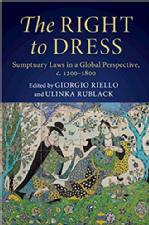
The Right to Dress: Sumptuary Laws in a Global Perspective, c.1200-1800Giorgio Riello and Ulinka Rublack (editors), Cambridge University Press 2019
This is the first global history of dress regulation and its place in broader debates around how human life and societies should be visualised and materialised. Sumptuary laws were a tool on the part of states to regulate not only manufacturing systems and moral economies via the medium of expenditure and consumption of clothing but also banquets, festivities and funerals. Leading scholars on Asian, Latin American, Ottoman and European history shed new light on how and why items of dress became key aspirational goods across society, how they were lobbied for and marketed, and whether or not sumptuary laws were implemented by cities, states and empires to restrict or channel trade and consumption. Their findings reveal the significance of sumptuary laws in medieval and early modern societies as a site of contestation between individuals and states and how dress as an expression of identity developed as a modern 'human right'.
- Riello, Giorgio - 02 - Global Economic History
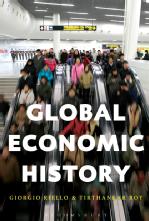
Global Economic History- Riello, Giorgio - 03 - Threads of Global Desire: Silk in the Pre-modern World

Threads of Global Desire: Silk in the Pre-modern WorldSilk has long been a global commodity that, because of its exceptional qualities, high value and relative portability, came to be traded over very long distances. Similarly, the silk industry - from sericulture to the weaving of cloth - was one of the most important fields of production in the medieval and early modern world. The production and consumption of silks spread from China to Japan and Korea and travelled westward as far as India, Persia and the Byzantine Empire, Europe, Africa and the Americas. As contributors to this book demonstrate, in this process of diffusion silk fostered technological innovation and allowed new forms of organization of labour to emerge. Its consumption constantly reshaped social hierarchies, gender roles, aesthetic and visual cultures,as well as rituals and representations of power.
Threads of Global Desire is the first attempt at considering a global history of silk in the pre-modern era. The book examines the role of silk production and use in various cultures and its relation to everyday and regulatory practices. It considers silk as a major force of cross cultural interaction through technological exchange and trade in finished and semi-finished goods. Silks mediated design and a taste for luxuries and were part of gifting practices in diplomatic and private contexts. Silk manufacturing also fostered the circulation of skilled craftsmen, connecting different centres and regions across continents and linking the countryside to urban production.
- Riello, Giorgio - 04 - Global Gifts: The Material Culture of Diplomacy in Early Modern Eurasia

Global Gifts: The Material Culture of Diplomacy in Early Modern Eurasia- Riello, Giorgio - 05 - Luxury: A Rich History
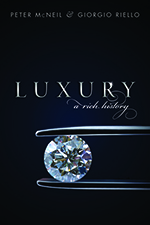
Luxury: A Rich HistoryPeter McNeil and Giorgio Riello, OUP 2016
We live in a world obsessed by luxury. Long-distance airlines compete to offer first-class sleeping experiences and hotels recommend exclusive suites where you are never disturbed. Luxury is a rapidly changing global industry that makes the headlines daily in our newspapers and on the internet. More than ever, luxury is a pervasive presence in the cultural and economic life of the West - and increasingly too in the emerging super-economies of Asia and Latin America.
Yet luxury is hardly a new phenomenon. Today's obsession with luxury brands and services is just one of the many manifestations that luxury has assumed. In the middle ages and the Renaissance, for example, luxury was linked to notions of magnificence and courtly splendour. In the eighteenth century luxury was at the centre of philosophical debates over its role in shaping people's desires and oiling the wheels of commerce. And it continues to morph today, with the growth of the global super-rich and increasing wealth polarization.
From palaces to penthouses, from couture fashion to lavish jewellery, from handbags to red wine, from fast cars to easy money, Peter McNeil and Giorgio Riello present the first ever global history of luxury, from the Romans to the twenty-first century: a sparkling and ever-changing story of extravagance, excess, novelty, and indulgence.
- Riello, Giorgio - 06 - The Global Lives of Things: The Material Culture of Connections in the Early Modern World

The Global Lives of Things: The Material Culture of Connections in the Early Modern WorldAnne Gerritsen and Giorgio Riello (editors), Routledge 2015
The Global Lives of Things considers the ways in which ‘things’, ranging from commodities to works of art and precious materials, participated in the shaping of global connections in the period 1400-1800. By focusing on the material exchange between Asia, Europe, the Americas and Australia, this volume traces the movements of objects through human networks of commerce, colonialism and consumption. It argues that material objects mediated between the forces of global economic exchange and the constantly changing identities of individuals, as they were drawn into global circuits. It proposes a reconceptualization of early modern global history in the light of its material culture by asking the question: what can we learn about the early modern world by studying its objects?
This exciting new collection draws together the latest scholarship in the study of material culture and offers students a critique and explanation of the notion of commodity and a reinterpretation of the meaning of exchange. It engages with the concepts of ‘proto-globalization’, ‘the first global age’ and ‘commodities/consumption’. Divided into three parts, the volume considers in Part One, Objects of Global Knowledge, in Part Two, Objects of Global Connections, and finally, in Part Three, Objects of Global Consumption. The collection concludes with afterwords from three of the leading historians in the field, Maxine Berg, Suraiya Faroqhi and Paula Findlen, who offer their critical view of the methodologies and themes considered in the book and place its arguments within the wider field of scholarship.
Extensively illustrated, and with chapters examining case studies from Northern Europe to China and Australia, this book will be essential reading for students of global history.
- Riello, Giorgio - 07 - Writing Material Culture History

Writing Material Culture HistoryAnne Gerritsen and Giorgio Riello (editors), Bloomsbury 2014
Writing Material Culture History examines the methodologies currently used in the historical study of material culture. Touching on archaeology, art history, literary studies and anthropology, the book provides history students with a fundamental understanding of the relationship between artefacts and historical narratives. The role of museums, the impact of the digital age and the representations of objects in public history are just some of the issues addressed in a book that brings together key scholars from around the world.
A range of artefacts, including a 16th-century Peruvian crown and a 19th-century Alaskan Sea Lion overcoat, are considered, illustrating the myriad ways in which objects and history relate to one another. Bringing together scholars working in a variety of disciplines, this book provides a critical introduction for students interested in material culture, history and historical methodologies.
- Riello, Giorgio - 08 - Cotton: The Fabric that Made the Modern World

Cotton: The Fabric that Made the Modern WorldGiorgio Riello, Cambridge University Press 2013
Today's world textile and garment trade is valued at a staggering $425 billion. We are told that under the pressure of increasing globalisation, it is India and China that are the new world manufacturing powerhouses. However, this is not a new phenomenon: until the industrial revolution, Asia manufactured great quantities of colourful printed cottons that were sold to places as far afield as Japan, West Africa and Europe. Cotton explores this earlier globalised economy and its transformation after 1750 as cotton led the way in the industrialisation of Europe. By the early nineteenth century, India, China and the Ottoman Empire switched from world producers to buyers of European cotton textiles, a position that they retained for over two hundred years. This is a fascinating and insightful story which ranges from Asian and European technologies and African slavery to cotton plantations in the Americas and consumer desires across the globe.
- Riello, Giorgio - 09 - La moda. Una storia dal Medioevo a oggi
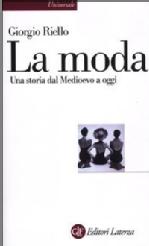
La moda. Una storia dal Medioevo a oggi[Fashion: A Story from the Middle Ages to the Present]
Giorgio Riello, Rome and Bari: Laterza, 2012
Fashion as a process of individualization and socialization, and at the same time a means to differentiate themselves from one another and form of social sharing. Fashion is used to create a certain look and to appear different from what are believed to be. This book has many instances of how fashion has been used continuously to "reinvent itself" and improve their social and economic condition. Fashion is not only worn or eaten, but it is also designed, created, produced, marketed and promoted. The consumer is not the unchallenged master of fashion; pretty fashion is a "system" of interaction between different actors and forces. Fashion is also a tool through which men and women differ. Today we think of fashion as a woman's weapon, but, for most of its history, fashion was more important for men than for women.
- Riello, Giorgio - 10 - Global Design History
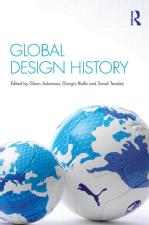
Global Design HistoryGiorgio Riello, Glenn Adamson, Sarah Teasley (editors), Basingstoke: Routledge 2011
Globalism is often discussed using abstract terms, such as ‘networks’ or ‘flows’ and usually in relation to recent history. Global Design History moves us past this limited view of globalism, broadening our sense of this key term in history and theory.
Individual chapters focus our attention on objects, and the stories they can tell us about cultural interactions on a global scale. They place these concrete things into contexts, such as trade, empire, mediation, and various forms of design practice. Featuring work from leading design historians, each chapter is paired with a ‘response’, designed to expand the discussion and test the methodologies on offer. An extensive bibliography and resource guide will also aid further research, providing students with a user friendly model for approaches to global design.
- Riello, Giorgio - 11 - Moda: Storia e Storie
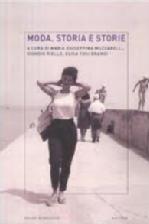
Moda: Storia e Storie[Fashion: the History and Stories]
Giorgio Riello, M. G. Muzzarelli, E. Tosi Brandi (editors), Milan: Bruno Mondadori 2010
Considered passenger and in continuous becoming, it almost seems like a contradiction that fashion has a past. However, fashion is not only what is in vogue today, but also a process that unfolds over time. This volume presents contributions from international specialists on how fashion and history intertwine throughout time and tools necessary to recover the past. The importance of women in the redefinition of the concept of fashion in an increasingly globalised world, the book examines the evolution of the phenomenon in a multidisciplinary perspective, considering aspects of sociology, anthropology, business administration and history of art among many. The authors also offer the reader a critical guide on how the fashion history is understood and taught, especially through the use of archival materials, objects found in museums and galleries and images preserved on film.
- Riello, Giorgio - 12 - Racconti d'Impresa. I Calzaturieri del Brenta tra Locale e Globale
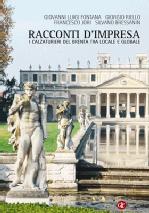
Racconti d'Impresa. I Calzaturieri del Brenta tra Locale e Globale[Business Stories: The Brenta Footwear between Local and Global]
Giorgio Riello, Giovanni Luigi Fontana, Francesco Jori, Silvano Bressanin 2010
This book tells stories of living and working conditions of people and businesses, with unwavering confidence and strong collective commitment, have led the economic revival of the Riviera del Brenta, elegant resort area of the Venetian aristocracy between Padua and Venice, which during the 19th century was one of the most depressed areas of the Veneto.
- Riello, Giorgio - 13 - The Fashion History Reader: Global Perspectives
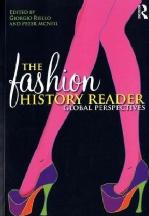
The Fashion History Reader: Global PerspectivesGiorgio Riello and Peter McNeil (editors), Basingstoke: Routledge 2010
The Fashion History Reader is an innovative work that provides a broad introduction to the complex literature in the fields of fashion studies, and dress and fashion history. Twenty-three chapters and over forty shorter ‘Snapshot’ texts cover a wide range of topics and approaches within the history of fashion, ranging from object-based studies to theory-driven analyses. The book is divided into six parts, surveying some of the key themes in the history of fashion. Themes also move in and across time, providing a chronology to enable student learning.
A comprehensive introduction by the editors contextualizes debates for students, synthesising past history and bringing them up-to-date through a discussion of globalization. Each section also includes a short, accessible introduction by the editors, placing each chapter within the wider, thematic treatment of fashion and its history, and an 'Annotated Guide to Further Reading' encourages students to enhance their learning independently.
- Riello, Giorgio - 14 - How India Clothed the World: The World of South Asian Textiles, 1500-1850
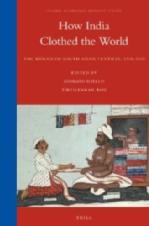
How India Clothed the World: The World of South Asian Textiles, 1500-1850Giorgio Riello and Tirthankar Roy (editors), Leiden: Brill 2009
Cloth has always been the most global of all traded commodities. It is an illuminating example of the circulation of goods, skills, knowledge and capital across wide geographic spaces. South Asia has been central to the making of these global exchanges over time. This volume presents innovative research that explores the dynamic ways in which diverse textile production and trade regions generated the 'first globalization'. A series of experts connect this global commodity with the dramatic political and economic transformations that characterised the Indian Ocean in the seventeenth and eighteenth centuries. Collectively, the essays transform our understanding of the contribution of South Asian cloth to the making of the modern world economy.
- Riello, Giorgio - 15 - The Spinning World: A Global History of Cotton Textiles, 1200-1850
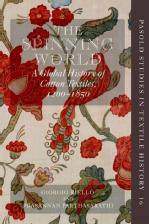
The Spinning World: A Global History of Cotton Textiles, 1200-1850Giorgio Riello and Prasannan Parthasarathi (editors), Oxford University Press 2009
Cotton textiles were the first good to achieve a truly global reach. For many centuries muslins and calicoes from the Indian subcontinent were demanded in the trading worlds of the Indian Ocean and the eastern Mediterranean. After 1500, new circuits of exchange were developed. Of these, the early-modern European craze for Indian calicoes and the huge nineteenth-century export trade in Lancashire goods, and subsequent deindustrialization of the Indian subcontinent, are merely the best known. These episodes, although of great importance, far from exhaust the story of cotton. They are well known because of the enormous research energy that has been devoted to them, but other important elements of cotton's long history are deserving of similar attention.
The purpose of this collection of essays is to examine the history of cotton textiles at a global level over the period 1200-1850. This volume sheds light on new answers to two questions: what is it about cotton that made it the paradigmatic first global commodity? And second, why did cotton industries in different parts of the world follow different paths of development?
- Riello, Giorgio - 16 - Eighteenth-Century Interiors: Redesigning the Georgian
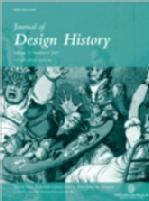
Eighteenth-Century Interiors: Redesigning the GeorgianSpecial Issue of the Journal of Design History, 20/4, 2007
Giorgio Riello and Hannah Greig (editors), 2007
Journal of Design History is a leading journal in its field. It plays an active role in the development of design history (including the history of the crafts and applied arts), as well as contributing to the broader field of studies of visual and material culture. The journal includes a regular book reviews section and lists books received, and from time to time publishes special issues.
- Riello, Giorgio - 17 - A Foot in the Past: Consumers, Producers, and Footwear in the Long Eighteenth Century (Pasold Studies in Textile History)
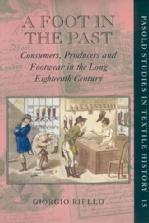
A Foot in the Past: Consumers, Producers, and Footwear in the Long Eighteenth Century (Pasold Studies in Textile History)Giorgio Riello, Oxford University Press 2006
A Foot in the Past analyses how footwear was consumed, retailed and produced in the eighteenth century. How many shoes were consumed? Who wore them? And what did the wearing of shoes mean in a society where part of the population walked barefoot? The book replies to such questions by showing how the increasing availability of boots, shoes and slippers in the eighteenth century was matched by profound changes in the way footwear was sold by shoe sellers and purchased by customers. By the mid-eighteenth century large shops provided a wide array of types, sizes and shapes of footwear from high-class lustrous boots to cheap shoes with nailed soles. Shoemaking, however, remained during the eighteenth and for most of the nineteenth century one of the most 'traditional' sectors of British and continental economies. The fact that mechanization and industrialization affected boot and shoemaking only after 1850 is not exceptional. The production of most consumer goods remained dominated by small-scale urban manufacturing in which the application of machinery played little part in either increasing productivity or changing the shape and quality of products. This book argues that the social and economic practices in the consumption of footwear are fundamental for understanding how such garments were produced and sold. Rather than embracing a vision of economic development based on mechanization and industrialization, this book investigates how social and cultural contexts for consumption shaped the way in which consumers' needs were satisfied. These lines of enquiry are developed through a comparative analysis of British and French histories based upon primary and secondary sources and a wide-ranging survey of the literature on dress and fashion in the eighteenth century.
- Riello, Giorgio - 18 - Shoes: A History from Sandals to Sneakers

Shoes: A History from Sandals to SneakersGiorgio Riello and Peter McNeil (editors), Oxford and
New York: Berg, 2006 What do your shoes say about you? Shoes are now much more than just things to walk in. From kids on the block to models on the catwalk, we use them to signal how fashionable we are. But, beyond style, this most intimate object communicates much more ...our sexual desires, aesthetic sense, social status and personality. And, before they became supreme objects of desire, shoes had a history. From ancient times to the present, shoes have had a cultural as well as a practical purpose. Within these pages is pretty much everything you ever wanted to know about shoes - the tiny crushing shoes of China, the infamous chopine with its 23-inch heel, how dandies made men's shoes beautiful in the eighteenth century, and how the powers of conservatism made them dull again, war and the Wellington boot, sex and the high heel, the codes of the "gay shoe," shoes in fairytales and in art, the irresistible rise of the sneaker, and the cult of shoe designers.
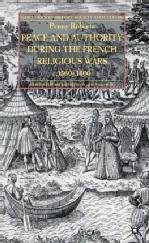
Peace and Authority During the French Religious Wars c.1560-1600Penny Roberts, Palgrave Macmillan 2013
The Edict of Nantes of 1598 is traditionally celebrated as an enlightened act of religious toleration ending the long and bloody conflict of the French religious wars. It is often forgotten, however, that it was preceded by a series of increasingly elaborate royal edicts which sought to pacify the country and to reconcile Protestant and Catholic. This book provides the first comprehensive overview of the process of peacemaking to cover the whole period of the wars throughout the French kingdom. It re-examines the sometimes fraught relationship between the crown and its subjects: the nobility, regional authorities, and urban communities, as well as confessional groups dissatisfied with royal policy. Through a wide-ranging and close analysis of archival sources, it re-evaluates both the role of royal authority and of local agency in the peace process, and provides a new perspective on the political, religious, social and cultural history of the conflict.
- Roberts, Penny - 02 - Ritual and Violence: Natalie Zemon Davis and Early Modern France (Past and Present Supplement 7)
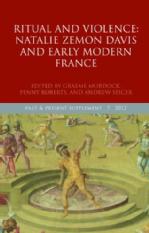
Ritual and Violence: Natalie Zemon Davis and Early Modern France (Past and Present Supplement 7)Penny Roberts, Graeme Murdock, Andrew Spicer (editors), Oxford University Press 2012
This collection of essays, edited by Graeme Murdock, Penny Roberts, and Andrew Spicer, developed from a one-day conference 'Religion and Violence in Early Modern France: The Work of Natalie Zemon Davis' which was held in June 2008 at the Shakespeare Institute, Stratford-upon-Avon.
Five of the papers published here were initially delivered on that occasion, but the conference also sought to learn from the differing perspectives of violence outside sixteenth-century France. This concern is also reflected in this collection, which seeks to offer new insights and approaches to the relationship and significance of religion and violence as well as paying tribute to the immense contribution made in this field by the writings of Natalie Zemon Davis.
- Roberts, Penny - 03 - History at the End of the World? History, Climate Change and the Possibility of Closure
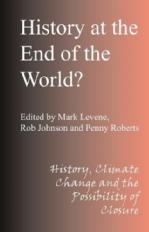
History at the End of the World? History, Climate Change and the Possibility of ClosurePenny Roberts, Mark Levene, Rob Johnson (editors), Humanities-Ebooks 2010
The authors of this collection of essays propose that climate change means serious peril. The approaches begin from archaeology, literature, religion, psychology, sociology, philosophy of science, engineering and sustainable development, as well as 'straight' history. Our argument, however, is not about the science per se. It is about us, our deep and more recent history, and how we arrived at this calamitous impasse. With contributions from academic activists and independent researchers, History at the End of the World challenges advocates of 'business as usual' to think again. But in its wide-ranging assessment of how we transcend the current crisis, it also proposes that the human past could be our most powerful resource in the struggle for survival.
- Roberts, Penny - 04 - Political Culture in Early Modern France

Political Culture in Early Modern France, French HistoryPenny Roberts (guest editor), Volume 21.2 2007
This volume brings together five essays written in homage to Professor R. J. Knecht on the occasion of his eightieth birthday. The contributors have all, in their various ways, enjoyed and benefited over many years from Professor Knecht's support, advice, patronage and friendship, as too has the Society for the Study of French History (of which he was one of the founding members and former president) and its associated journal French History. A commemoration of the meeting which created the Society - Twenty Years On - can be found later in this volume. Yet the essays here, by British historians of early modern France, represent the recognition of only a small group of those who might pay tribute to Bob (as his friends and colleagues know him). In France, in particular, but also North America, he has forged a wide circle of friendships with fellow historians, art historians and literary scholars in the field of early modern French studies, both from his own and later generations, as reflected in the postscript to this volume by Denis Crouzet.
- Roberts, Penny - 05 - The Adventure of Religious Pluralism in Early Modern France
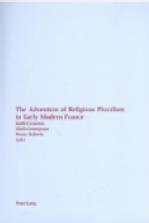
The Adventure of Religious Pluralism in Early Modern FrancePenny Roberts, Keith Cameron, Mark Greengrass (editors), Peter Lang 2000
France was the largest unified political entity in early-modern Europe to attempt a major, institutionalised degree of religious pluralism. For a monarchy that had its roots in catholic traditions this was, indeed, an adventure full of unexpected consequences. This volume is based on papers delivered at a colloquium at the University of Exeter in 1999 and takes as its starting-point the various edicts - culminating in the famous edict of Nantes of 1598 - that epitomised religious pluralism. Its authors explore the national, international and local dimensions of a pluralism that challenged established notions of political authority and social behaviour at every turn. At the national level, the king issued edicts which embodied the royal intent but to what extent did they carry the endorsement of the parlements, the sovereign courts whose task was to interpret the law and adapt it to circumstance? How were these edicts carried out locally in the provinces? How different was the security of France's protestant minority within the wider community after the king had granted them such controversial privileges? How does the pluralism accorded a religious minority compare with other countries? The chapters in this volume tackle these questions from new and interesting viewpoints, encourage a comparative approach and reflect the new agenda for the subject that emerged in the light of the 400th anniversary commemoration of the edict of Nantes in 1998.
- Roberts, Penny - 06 - The Massacre in History (War and Genocide)
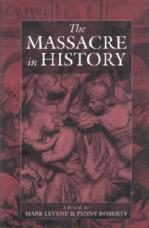
The Massacre in History (War and Genocide)Penny Roberts and Mark Levene (editors), Berghahn, 1999
The role of massacre in history has been given little focused attention either by historians or academics in related fields. This is surprising as its prevalence and persistence surely demands that it should be a subject of serious and systematic exploration. What exactly is a massacre? When - and why - does it happen? Is there a cultural, as well as political framework within which it occurs? How do human societies respond to it? What are its social and economic repercussions? Are massacres catalysts for change or are they part of the continuity of the human saga? These are just some of the questions the authors address in this important volume. Chronologically and geographically broad in scope, The Massacre in History provides in-depth analysis of particular massacres and themes associated with them from the 11th century to the present. Specific attention is paid to 15th century Christian-Jewish relations in Spain, the St. Batholemew's Day massacre, England and Ireland in the civil war era, the 19th century Caucasus, the rape of Nanking in 1937 and the Second World War origins of the Serb-Croat conflict. The book explores the subject of massacre from a variety of perspectives - its relationship to politics, culture, religion and society, its connection to ethnic cleansing and genocide, and its role in gender terms and in relation to the extermination of animals. The historians provide evidence to suggest that the "massacre" is often central to the course of human development and societal change.
- Roberts, Penny - 07 - Fear in Early Modern Society
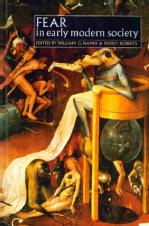
Fear in Early Modern SocietyPenny Roberts and Bill Naphy (editors), Manchester University Press 1997
These essays present an examination of the events and crises which generated fear in early-modern societies. They offer examples of fear, and popular responses to it. From the natural threats of fire, flood and plague to the theoretical traumas of death and the afterlife, this volume covers the panoply of personal and communal tragedies which tormented, tortured and terrified the early-modern world.
- Roberts, Penny - 08 - A City in Conflict: Troyes During the French Wars of Religion
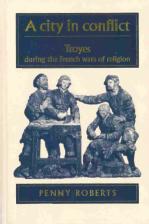
A City in Conflict: Troyes During the French Wars of ReligionPenny Roberts, Manchester University Press 1996
This text explores in depth the impact of the French wars of religion on the inhabitants of one French city, Troyes, in Champagne. Drawing on previously neglected sources, the author examines the individual and collective experience of the religious conflict in Troyes. She considers how the religious divisions created such brutal conflict between neighbours. The book deals with the attempt and ultimate failure to establish the Reformed Church in the city, the composition of its congregation, and the difficulties faced by the ministers appointed to serve it. Particular emphasis is given to the role of the local authorities - ecclesiastical, municipal and royal - in nurturing or obstructing the progress of the Reform in Troyes, and to the reconstruction of events in the city during the crucial years of 1562 and 1572. Finally, the book focuses on the Catholic inhabitants, the effect the wars had on their traditional devotions, and their receptiveness to the Catholic League and its period of domination in the city.
- Ross, Anna - 01 - Beyond the Barricades: Government and State-Building in Post-Revolutionary Prussia, 1848-1858

Beyond the Barricades: Government and State-Building in Post-Revolutionary Prussia, 1848-1858Anna Ross, Oxford University Press 2019
Beyond the Barricades is an original study of government after the 1848 revolutions. It focuses on the state of Prussia, where a number of conservative ministers sought to learn lessons from their experiences of upheaval and introduce a wave of reform in the 1850s. Using extensive archival research, the work explores Prussia's entry into the constitutional age, charting initiatives to transform criminal justice, agriculture, industry, communications, urban life, and the press. Reform strengthened contact with the Prussian population, making this a classic episode of state-building, but Beyond the Barricades seeks to go further. It makes a case for taking notice of government activity at this particular juncture because the measures endorsed by conservative statesmen in the 1850s sought to remove the feudal intermediaries that had lingered long into the nineteenth century and replace them with an array of government institutions, legal regimes, and official practices. In sum, this book recasts the post-revolutionary decade as a period which saw the transition from an old to a new world, pivotal to the making of modern Prussia and ultimately, modern Germany.
S
- Salzberg, Rosa - 01 - Ephemeral City: Cheap Print and Urban Culture in Renaissance Venice
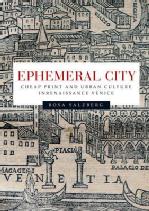
Ephemeral City: Cheap Print and Urban Culture in Renaissance VeniceRosa Salzberg, Manchester University Press 2014
Ephemeral City explores the rapid rise of cheap print and how it permeated Venetian urban culture in the Renaissance. It offers the first view of one of the city's most productive and creative industries from the bottom up and a new and unexpected vision of Renaissance culture, characterised by the fluid mobility and dynamic intermingling of texts, ideas, goods and people.
Closely intertwined with oral culture and often peddled in the streets, cheap printed texts helped to open up new audiences for literature, providing information and entertainment to a diverse public and transforming the city into an epicentre of vernacular literature and performance. Examining the ways in which the production and dissemination of cheap print infiltrated Venice's urban environment and changed the course of its cultural life, the book also traces how local authorities responded by escalating censorship and control over the course of the sixteenth century.
Ephemeral City will be of interest to scholars and students of early modern European and Italian Renaissance culture and society and the history of the book and communication.
- Sarkar, Aditya - 01 - Trouble at the Mill: Factory Law and the Emergence of Labour Question in Late Nineteenth-Century Bombay
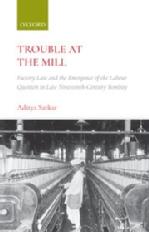
Trouble at the Mill: Factory Law and the Emergence of Labour Question in Late Nineteenth-Century BombayAditya Sarkar, OUP India 2018
The book uses the Factory Acts of the late nineteenth century as an entry point into the early history of labour relations in India, specifically the mill industry of Bombay. It unites legal and social history in a manner which differs from most social histories of labour, and offers a new perspective on the constitution of industrial relations in colonial India.
The Factory Act passed by the Government of British India in 1881 produced the first official definition of 'factories' in modern Indian history as workplaces using steam power and regularly employing over 100 workers. It imposed certain minimal restrictions upon the freedom of employers in a limited range of industrial workplaces and invested factory workers, most explicitly children, with a slim set of immunities and entitlements. In 1891, the Factory Act was amended: factories were redefined as workplaces employing over 50 workers, the upper age limit of legal 'protection' was raised, weekly holidays were established, and women mill-workers were brought within its ambit. In its own time, factory law was experienced as a minor official initiative, but it connected with some of the most potent ideological debates and political oppositions of the age.
This book takes these two pieces of labour legislation as an entry point into the history of 'industrial relations' (the term did not yet exist in its present sense) in colonial India, in the last quarter of the nineteenth century combining the legal and social history which diverges from most studies of Indian workers. It identifies an emergent 'factory question' built on the problem of protective labour legislation. The cotton-mill industry of Bombay, long familiar to labour historians as one of the nodal points of modern Indian capitalism, is the principal focal point of this investigation. While this is a book about law and regulation, it is neither a legislative nor a policy history. While it is preoccupied with the history of factory legislation, it does not offer a full narrative that takes this as its 'object'. And while the book focuses on Bombay's cotton mills, it contains significant departures both from the city and its major industry. A number of questions which have only rarely been thematized by labour historians-the ideologies of factory reform, the politics of factory commissions, the routines of factory inspection, and the earliest waves of strike action in the cotton textile industry-are raised in this book.
- Schwartz, Laura - 01 - Infidel Feminism: Secularism, Religion and Women's Emancipation, England 1830-1914
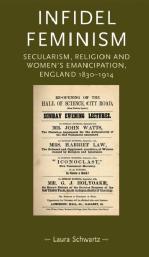
Infidel Feminism: Secularism, Religion and Women's Emancipation, England 1830-1914Laura Schwartz, Manchester University Press 2013
Infidel feminism is the first in-depth study of a distinctive brand of women’s rights that emerged out of the Victorian Secularist movement. It looks at the lives and work of a number of female activists, whose renunciation of religion shaped their struggle for emancipation. Anti-religious or secular ideas were fundamental to the development of feminist thought, but have, until now, been almost entirely passed over in the historiography of the Victorian and Edwardian women’s movement. In uncovering an important tradition of Freethinking feminism, this book reveals an ongoing radical and free love current connecting Owenite feminism with the more ‘respectable’ post-1850 women’s movement and the ‘New Women’ of the early twentieth century. This book will be invaluable to both scholars and students of social and cultural history and feminist thought, and to interdisciplinary studies of religion and secularisation, as well as those interested in the history of women’s movements more broadly.
- Schwartz, Laura - 02 - A Serious Endeavour: Gender, Education and Community at St Hugh's, 1886-2011
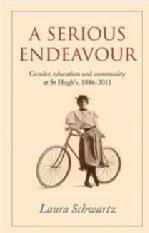
A Serious Endeavour: Gender, Education and Community at St Hugh's, 1886-2011Laura Schwartz, London: Profile Books, 2011
Neither a cosy anecdotal inside story, nor a straightforward account of women's struggle to enter the university, this history of St Hugh's College, Oxford looks both upstairs and downstairs, at dons and undergraduates but also at domestic staff. What did it mean for the would-be school teacher, the flapper on the motorcycle, the depression era grammar-school girl, and the student revolutionary of the 1970s to re-invent themselves as educated women? Who remained excluded from this emancipated identity? What were the tensions between old and new generations of dons and undergraduates? And what of the first Principal's notorious belief in time-travel?
In this innovative study, Schwartz explores the relationship between personal and collective identity in one of the first higher educational establishments run by and for women, during a period in which women's role both in society and university education changed beyond recognition. Based on new and original research, A Seroius Endeavour offers a fresh and sometimes disquieting perspective on the history of gender and education in twentieth-century Britain, opening up new ways of thinking about the development of women's higher education.
- Shafiee, Katayoun - 01 - Machineries of Oil: An Infrastructural History of BP in Iran
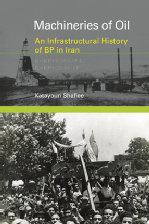
Machineries of Oil: An Infrastructural History of BP in IranKatayoun Shafiee, MIT Press 2018
The emergence of the international oil corporation as a political actor in the twentieth century, seen in BP's infrastructure and information arrangements in Iran. In the early twentieth century, international oil corporations emerged as a new kind of political actor. The development of the world oil industry, argues Katayoun Shafiee, was one of the era's largest political projects of techno-economic development. In this book, Shafiee maps the machinery of oil operations in the Anglo-Iranian oil industry between 1901 and 1954, tracking the organizational work involved in moving oil through a variety of technical, legal, scientific, and administrative networks. She shows that, in a series of disagreements, the British-controlled Anglo-Iranian Oil Company (AIOC, which later became BP) relied on various forms of information management to transform political disputes into techno-economic calculation, guaranteeing the company complete control over profits, labor, and production regimes. She argues that the building of alliances and connections that constituted Anglo-Iranian oil's infrastructure reconfigured local politics of oil regions and examines how these arrangements in turn shaped the emergence of both nation-state and transnational oil corporation. Drawing on her extensive archival and field research in Iran, Shafiee investigates the surprising ways in which nature, technology, and politics came together in battles over mineral rights; standardizing petroleum expertise; formulas for calculating profits, production rates, and labor; the "Persianization" of employees; nationalism and oil nationalization; and the long-distance machinery of an international corporation. Her account shows that the politics of oil cannot be understood in isolation from its technical dimensions.
- Shaw, Claire - 01 - Deaf in the USSR: Marginality, Community, and Soviet Identity, 1917-1991
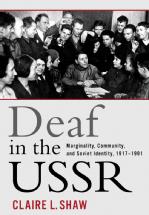
Deaf in the USSR: Marginality, Community, and Soviet Identity, 1917-1991Claire Shaw, Cornell University Press 2017
In Deaf in the USSR, Claire L. Shaw asks what it meant to be deaf in a culture that was founded on a radically utopian, socialist view of human perfectibility. Shaw reveals how fundamental contradictions inherent in the Soviet revolutionary project were negotiated--both individually and collectively-- by a vibrant and independent community of deaf people who engaged in complex ways with Soviet ideology.
Deaf in the USSR engages with a wide range of sources from both deaf and hearing perspectives--archival sources, films and literature, personal memoirs, and journalism--to build a multilayered history of deafness. This book will appeal to scholars of Soviet history and disability studies as well as those in the international deaf community who are interested in their collective heritage. Deaf in the USSR will also enjoy a broad readership among those who are interested in deafness and disability as a key to more inclusive understandings of being human and of language, society, politics, and power.
- Smith, Benjamin - 01 - The Mexican Press and Civil Society, 1940–1976
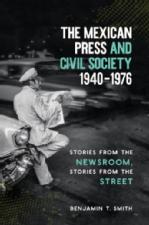
The Mexican Press and Civil Society, 1940–1976Benjamin Smith, The University of North Carolina Press
Mexico today is one of the most dangerous places in the world to report the news, and Mexicans have taken to the street to defend freedom of expression. As Benjamin T. Smith demonstrates in this history of the press and civil society, the cycle of violent repression and protest over journalism is nothing new. He traces it back to the growth in newspaper production and reading publics between 1940 and 1976, when a national thirst for tabloids, crime sheets, and magazines reached far beyond the middle class.
As Mexicans began to view local and national events through the prism of journalism, everyday politics changed radically. Even while lauding the liberty of the press, the state developed an arsenal of methods to control what was printed, including sophisticated spin and misdirection techniques, covert financial payments, and campaigns of threats, imprisonment, beatings, and even murder. The press was also pressured by media monopolists tacking between government demands and public expectations to maximize profits, and by coalitions of ordinary citizens demanding that local newspapers publicize stories of corruption, incompetence, and state violence. Since the Cold War, both in Mexico City and in the provinces, a robust radical journalism has posed challenges to government forces.
- Smith, Benjamin - 02 - Dictablanda: Politics, Work, and Culture in Mexico, 1938–1968
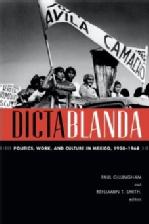
Dictablanda: Politics, Work, and Culture in Mexico, 1938–1968Benjamin Smith and Paul Gillingham (editors), Duke University Press 2014
In 1910 Mexicans rebelled against an imperfect dictatorship; after 1940 they ended up with what some called the perfect dictatorship. A single party ruled Mexico for over seventy years, holding elections and talking about revolution while overseeing one of the world's most inequitable economies. The contributors to this groundbreaking collection revise earlier interpretations, arguing that state power was not based exclusively on hegemony, corporatism, or violence. Force was real, but it was also exercised by the ruled. It went hand-in-hand with consent, produced by resource regulation, political pragmatism, local autonomies and a popular veto. The result was a dictablanda: a soft authoritarian regime.
This deliberately heterodox volume brings together social historians, anthropologists, sociologists, and political scientists to offer a radical new understanding of the emergence and persistence of the modern Mexican state. It also proposes bold, multidisciplinary approaches to critical problems in contemporary politics. With its blend of contested elections, authoritarianism, and resistance, Mexico foreshadowed the hybrid regimes that have spread across much of the globe. Dictablanda suggests how they may endure.
- Smith, Benjamin - 03 - The Roots of Conservatism in Mexico: Catholicism, Society, and Politics in the Mixteca Baja, 1750-1962
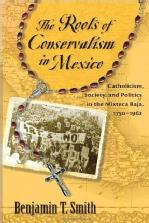
The Roots of Conservatism in Mexico: Catholicism, Society, and Politics in the Mixteca Baja, 1750-1962Benjamin Smith, Albuquerque: University of New Mexico Press, 2012
The Roots of Conservatism is the first attempt to ask why over the past two centuries so many Mexican peasants have opted to ally with conservative groups rather than their radical counterparts. Blending socioeconomic history, cultural analysis, and political narrative, Smith's study begins with the late Bourbon period and moves through the early republic, the mid-nineteenth-century Reforma, the Porfiriato, and the Revolution, when the Mixtecs rejected Zapatista offers of land distribution, ending with the armed religious uprising known as the "last Cristiada," a desperate Cold War bid to rid the region of impious "communist" governance. In recounting this long tradition of regional conservatism, Smith emphasizes the influence of religious belief, church ritual, and lay-clerical relations both on social relations and on political affiliation. He posits that many Mexican peasants embraced provincial conservatism, a variant of elite or metropolitan conservatism, which not only comprised ideas on property, hierarchy, and the state, but also the overwhelming import of the church to maintaining this system.
- Smith, Benjamin - 04 - Pistoleros and Popular Movements: The Politics of State Formation in Postrevolutionary Oaxaca
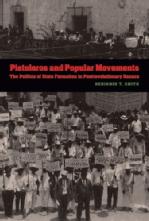
Pistoleros and Popular Movements: The Politics of State Formation in Postrevolutionary OaxacaBenjamin Smith, Lincoln: University of Nebraska Press, 2009
The postrevolutionary reconstruction of the Mexican government did not easily or immediately reach all corners of the country. At every level, political intermediaries negotiated, resisted, appropriated, or ignored the dictates of the central government. As a result, national policy reverberated through Mexico's local and political networks in countless different ways and resulted in a myriad of regional arrangements. It is this process of diffusion, politicking, and conflict that Benjamin T. Smith examines in "Politics in Postrevolutionary Oaxaca, 1920-1952".Oaxaca's urban social movements and the tension between federal, state, and local governments illuminate the multivalent contradictions, fragmentations, and crises of the state-building effort at the regional level. A better understanding of these local transformations yields a more realistic overall view of the national project of state building. Smith places Oaxaca within this larger framework of postrevolutionary Mexico by comparing the region to other states and linking local politics to state and national developments. Drawing on an impressive range of regional case studies, this volume is a comprehensive and engaging study of postrevolutionary Oaxaca's role in the formation of modern Mexico.
- Smyth, J E - 01 - Nobody's Girl Friday: The Women Who Ran Hollywood
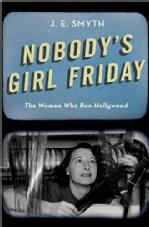
Nobody's Girl Friday: The Women Who Ran HollywoodJ E Smyth, New York: Oxford University Press 2018
Looking back on her career in 1977, Bette Davis remembered with pride, "Women owned Hollywood for twenty years." She had a point. Between 1930 and 1950, over 40% of film industry employees were women, 25% of all screenwriters were female, one woman ran MGM behind the scenes, over a dozen women worked as producers, a woman headed the Screen Writers Guild three times, and press claimed Hollywood was a generation or two ahead of the rest of the country in terms of gender equality and employment.
The first comprehensive history of Hollywood's high-flying career women during the studio era, Nobody's Girl Friday covers the impact of the executives, producers, editors, writers, agents, designers, directors, and actresses who shaped Hollywood film production and style, led their unions, climbed to the top during the war, and fought the blacklist.
Based on a decade of archival research, author J.E. Smyth uncovers a formidable generation working within the American film industry and brings their voices back into the history of Hollywood. Their achievements, struggles, and perspectives fundamentally challenge popular ideas about director-based auteurism, male dominance, and female disempowerment in the years between First and Second Wave Feminism.
Nobody's Girl Friday is a revisionist history, but it's also a deeply personal, collective account of hundreds of working women, the studios they worked for, and the films they helped to make. For many years, historians and critics have insisted that both American feminism and the power of women in Hollywood declined and virtually disappeared from the 1920s through the 1960s. But Smyth vindicates Bette Davis's claim. The story of the women who called the shots in studio-era Hollywood has never fully been told-until now.
- Smyth, J E - 02 - From Here to Eternity

From Here to EternityJ E Smyth, London BFI 2015
From Here to Eternity (1953) is one of the most controversial films of its time. Adapted from James Jones's bestselling novel, the landmark blockbuster deals frankly with adultery, military corruption, physical abuse, racism and murder, and traces the unhappy lives of five American outsiders in the last days before Pearl Harbor. Made at the height of the Cold War and Hollywood's anticommunist purges, director Fred Zinnemann, writer Daniel Taradash and producer Buddy Adler defied military and industry pressure to censor the material.
Exploring the film's full production history and drawing upon archival documents and rare interviews with cast and crew, J. E. Smyth provides a fascinating behind-the-scenes look at the film many industry insiders thought couldn't be made. This special edition features original cover artwork by Eda Akaltun.
- Smyth, J E - 03 - Fred Zinnemann and the Cinema of Resistance
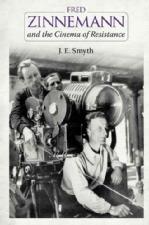
Fred Zinnemann and the Cinema of ResistanceJ E Smyth, University Press of Mississippi, 2014
Fred Zinnemann directed some of the most acclaimed and controversial films of the twentieth century, yet he has been a shadowy presence in Hollywood history. In Fred Zinnemann and the Cinema of Resistance, J. E. Smyth reveals the intellectual passion behind some of the most powerful films ever made about the rise and resistance to fascism and the legacy of the Second World War, from The Seventh Cross and The Search to High Noon, From Here to Eternity, and Julia. Smyth's book is the first to draw upon Zinnemann's extensive papers at the Academy of Motion Picture Arts and Sciences and brings Fred Zinnemann's vision, voice, and film practice to life. In his engagement with the defining historical struggles of the twentieth century, Zinnemann fought his own battles with the Hollywood studio system, the critics, and a public bent on forgetting. Zinnemann's films explore the role of women and communists in the antifascist resistance, the West's support of Franco after the Spanish Civil War, and the darker side of America's national heritage. Smyth reconstructs a complex and conflicted portrait of Zinnemann's cinema of resistance, examining his sketches, script annotations, editing and production notes, and personal letters. Illustrated with seventy black-and-white images from Smyth's collection, Fred Zinnemann and the Cinema of Resistance discusses the director's professional and personal relationships with Spencer Tracy, Montgomery Clift, Audrey Hepburn, Vanessa Redgrave, and Gary Cooper; the critical reaction to his revisionist Western, High Noon; his battles over the censorship of From Here to Eternity, The Nun's Story, and Behold a Pale Horse; his unrealized history of the communist Revolution in China, Man's Fate; and the controversial study of political assassination, The Day of the Jackal. In this intense, richly textured narrative, Smyth enters the mind of one of Hollywood's master directors, redefining our knowledge of his artistic vision and practice.
- Smyth, J E - 04 - Hollywood and the American Historical Film
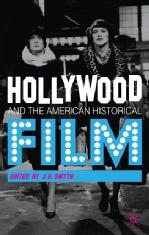
Hollywood and the American Historical FilmJ E Smyth (editor), London: Palgrave Macmillan, 2012
This definitive interdisciplinary collection by leading scholars probes the theoretical and historical contexts of films made about the American past, from silent film to the present. The book offers a fresh assessment of studio era historical filmmaking and its legacy across a range of genres.
- Smyth, J E - 05 - Edna Ferber's Hollywood: American Fictions of Gender, Race, and History

Edna Ferber's Hollywood: American Fictions of Gender, Race, and HistoryJ E Smyth, Austin: University of Texas Press 2009
Edna Ferber's Hollywood reveals one of the most influential artistic relationships of the twentieth century—the four-decade partnership between historical novelist Edna Ferber and the Hollywood studios. Ferber was one of America's most controversial popular historians, a writer whose uniquely feminist, multiracial view of the national past deliberately clashed with traditional narratives of white masculine power. Hollywood paid premium sums to adapt her novels, creating some of the most memorable films of the studio era—among them Show Boat, Cimarron, and Giant. Her historical fiction resonated with Hollywood's interest in prestigious historical filmmaking aimed principally, but not exclusively, at female audiences.
In Edna Ferber's Hollywood, J. E. Smyth explores the research, writing, marketing, reception, and production histories of Hollywood's Ferber franchise. Smyth tracks Ferber's working relationships with Samuel Goldwyn, Leland Hayward, George Stevens, and James Dean; her landmark contract negotiations with Warner Bros.; and the controversies surrounding Giant's critique of Jim-Crow Texas. But Edna Ferber's Hollywood is also the study of the historical vision of an American outsider—a woman, a Jew, a novelist with few literary pretensions, an unashamed middlebrow who challenged the prescribed boundaries among gender, race, history, and fiction. In a masterful film and literary history, Smyth explores how Ferber's work helped shape Hollywood's attitude toward the American past.
- Smyth, J E - 06 - Reconstructing American Historical Cinema: From "Cimarron" to "Citizen Kane"

Reconstructing American Historical Cinema: From "Cimarron" to "Citizen Kane"J E Smyth, Lexington: University Press of Kentucky 2006
In Reconstructing American Historical Cinema: From Cimarron to Citizen Kane, J. E. Smyth dramatically departs from the traditional understanding of the relationship between film and history. By looking at production records, scripts, and contemporary reviews, Smyth argues that certain classical Hollywood filmmakers were actively engaged in a self-conscious and often critical filmic writing of national history. Her volume is a major reassessment of American historiography and cinematic historians from the advent of sound to the beginning of wartime film production in 1942. Focusing on key films such as Cimarron (1931), The Public Enemy (1931), Scarface (1932), Ramona (1936), A Star Is Born (1937), Jezebel (1938), Young Mr. Lincoln (1939), Gone with the Wind (1939), Stagecoach (1939), and Citizen Kane (1941), Smyth explores historical cinema’s connections to popular and academic historigraphy, historical fiction, and journalism, providing a rich context for the industry’s commitment to American history. Rather than emphasizing the divide between American historical cinema and historical writing, Smyth explores the continuities between Hollywood films and history written during the first four decades of the twentieth century, from Carl Becker’s famous “Everyman His Own Historian” to Howard Hughes’s Scarface to Margaret Mitchell and David O. Selznick’s Gone with the Wind. Hollywood’s popular and often controversial cycle of historical films from 1931 to 1942 confronted issues as diverse as frontier racism and women’s experiences in the nineteenth-century South, the decline of American society following the First World War, the rise of Al Capone, and the tragic history of Hollywood’s silent era. Looking at rarely discussed archival material, Smyth focuses on classical Hollywood filmmakers’ adaptation and scripting of traditional historical discourse and their critical revision of nineteenth- and twentieth-century American history. Reconstructing American Historical Cinema uncovers Hollywood’s diverse and conflicted attitudes toward American history. This text is a fundamental challenge the prevailing scholarship in film, history, and cultural studies.
- Stein, Claudia - 01 - Organising the History of Hygiene at the Internationale Hygiene-Ausstellung in Dresden in 1911

Organising the History of Hygiene at the Internationale Hygiene-Ausstellung in Dresden in 1911Claudia Stein, Zeitschrift für Geschichte der Wissenschaften, Technik und Medizin, vol. 22, 1, 2014
During the summer of 1911 Dresden, the capital of Saxony, welcomed some 5.2 million visitors to the Internationale Hygiene-Ausstellung (International Hygiene Exhibition, hereafter IHA). Through its centre piece – the display, Der Mensch, spreading over 3,200 square metres and personally conceptualised by the IHA’s organiser, the Dresden pharmaceutical entrepreneur Karl August Lingner (1867–1916) – visitors discovered, perhaps for the first time in their lives, how their bodies functioned according to the latest biological discoveries. Little wonder that historians of medicine and science have often regarded the IHA as a defining moment in the popularisation of scientific medicine and its conceptualisation of the modern body.
Less well known, however, is that under the presiding hand of Germany’s most eminent historian of medicine of the time, Karl Sudhoff (1853−1938) (Stein 2013), a historical and ethnological section attempted ‘to sell’ a history of hygiene. This was conducted through the display of some 20,000 objects and artefacts spread over 2,400 square metres, in over seventy rooms, hallways, and galleries. There had been hygiene exhibitions before, dating from the 1870s, but never on this scale nor with such dedicated attention to historico-ethnological display.
This article draws on the correspondence between Sudhoff and his co-organising team to explore how this grand display was made possible. The unique material helps illuminate an area of turn-of-the century exhibition culture usually hidden from the historian’s sight: the daily, sometimes tedious negotiations and the complicated and often drawn-out decision-making processes in setting up such events.
- Stein, Claudia - 02 - Writing History in the Age of Biomedicine
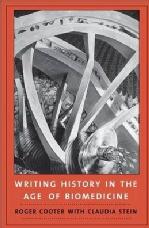
Writing History in the Age of BiomedicineRoger Cooter with Claudia Stein, Yale 2013
A collection of ten essays paired with substantial prefaces, this book chronicles and contextualizes Roger Cooter's contributions to the history of medicine. Through an analysis of his own work, Cooter critically examines the politics of conceptual and methodological shifts in historiography. In particular, he examines the "double bind" of postmodernism and biological or neurological modelling that, together, threaten academic history. To counteract this trend, suggests Cooter, historians must begin actively locating themselves in the problems they consider. The essays and commentaries constitute a kind of contour map of history's recent trends and trajectories - its points of passage to the present - and lead both to a critical account of the discipline's historiography and to an examination of the role of intellectual frameworks and epistemic virtues in the writing of history.
- Stein, Claudia - 03 - Negotiating the French Pox in Early Modern Germany
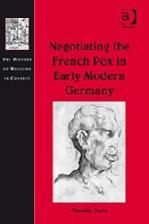
Negotiating the French Pox in Early Modern GermanyClaudia Stein, Ashgate 2009
This book explores the identity of the 'French disease' (alias the 'French pox' or 'Morbus Gallicus') in the German Imperial city of Augsburg between 1495 and 1630. Rejecting the imposition of modern conceptions of disease upon the past, it reveals how early modern medical theory facilitated enormous flexibility in defining disease, and how disease identification was a local matter, and one of constant negotiation and renegotiation.
Drawing on a wealth of primary source material this work combines concern with the conceptualisation of the disease with its practical application, and argues for the inseparability of both. It focuses on how theoretical understanding of the pox shaped the various therapeutic reactions, and vice versa. It exemplifies this in the specific socio-cultural context of sixteenth- and seventeenth-century Augsburg, through an investigation of the city's municipal and private pox hospitals.
Combining medical, religious, economic, municipal and institutional history this book offers a fascinating insight into how early modern society came to terms with disease both in a practical and theoretical sense. This revised English translation of Dr Stein's original German book adds new layers of understanding to a fascinating but complex subject.
- Stein, Claudia - 04 - Die Behandlung Der Franzosenkrankheit in Der Fruehen Neuzeit Am Beispiel Augsburgs
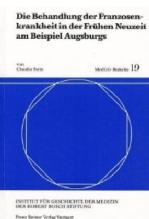
Die Behandlung Der Franzosenkrankheit in Der Fruehen Neuzeit Am Beispiel Augsburgs[The Treatment of the French Disease in the Early Modern Period to the Example of Augsburg]
Claudia Stein, Steiner 2003
This is a study of the treatment of the "French disease" in three hospitals in the imperial city of Augsburg, Germany, between 1495 and 1632.
- Storer, Colin - 01 - A Short History of the Weimar Republic
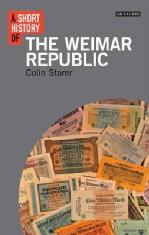
A Short History of the Weimar RepublicColin Storer, I. B. Tauris; London 2013
It is impossible to understand the history of modern Europe without some knowledge of the Weimar Republic. The brief fourteen-year period of democracy was marked by unstable government, economic crisis and the rise of extremist political movements. Yet at the same time a vibrant cultural scene flourished, which continues to influence the international art world, whether indirectly via the enduring popularity of Christopher Isherwood's Berlin Novels and Bob Fosse's Cabaret, or in more concrete ways through the aesthetics of Expressionism and the Bauhaus movement. Historians have seen the Weimar Republic as a democratic experiment set between the authoritarian monarchism of the Wilhelmine Empire and the tyranny of the Third Reich, but contemporaries were not so pessimistic. While some disparaged the new democratic system and fulminated against Weimar cosmopolitanism and 'decadence', most praised attempts to bring social improvement and the emancipation of women, or celebrated the exciting forays into the avant-garde of Weimar's artistic elite.
In the fields of visual art, literature, theatre, cinema, music and architecture - not to mention chemistry, physics and psychology - Germany became a world leader during the 1920s, while her perilous political and economic position ensured that no US or European statesman could afford to ignore her. Weimar Germany was thus much more than merely a cul-de-sac off Germany's difficult 'special path' to modernity, it was a key period in German and European history whose influence continues to be felt. Incorporating original research and a synthesis of the existing historiography, this book will provide students and a general readership with a clear and concise introduction to the history of the first German Republic. It highlights key concepts and themes in the study of German history in general and the Weimar Republic in particular.
- Storer, Colin - 02 - Britain and the Weimar Republic: The History of a Cultural Relationship
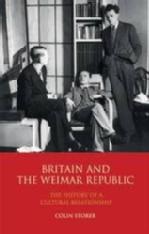
Britain and the Weimar Republic: The History of a Cultural RelationshipColin Storer, I. B. Tauris; London 2010
Between the two world wars, Germany managed - despite all the political upheavals it was experiencing - to attract extremely large numbers of British travellers and tourists. During the Weimar period in particular, Germany attracted visitors from virtually every section of British society. In this book, Colin Storer moves beyond the traditional scholarly focus on figures such as Christopher Isherwood and John Maynard Keynes to provide the first broad comparative study of British intellectual attitudes towards Weimar Germany. Based on original research and using striking examples from intellectual life and literature it highlights the diversity of British attitudes, challenges received opinions on areas such as the 'inevitable collapse' of the Republic, and seeks to establish why Weimar Germany was so appealing to such a variety of individuals.
T
- Thomson, Mathew - 01 - Lost Freedom: The Landscape of the Child and the British Post-War Settlement
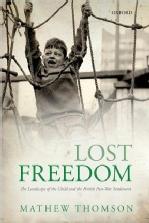
Lost Freedom: The Landscape of the Child and the British Post-War SettlementMathew Thomson, Oxford University Press 2013
Lost Freedom addresses the widespread feeling that there has been a fundamental change in the social life of children in recent decades: the loss of childhood freedom, and in particular, the loss of freedom to roam beyond the safety of home. Mathew Thomson explores this phenomenon, concentrating on the period from the Second World War until the 1970s, and considering the roles of psychological theory, traffic, safety consciousness, anxiety about sexual danger, and television in the erosion of freedom.
Thomson argues that the Second World War has an important place in this story, with war-borne anxieties encouraging an emphasis on the central importance of a landscape of home. War also encouraged the development of specially designed spaces for the cultivation of the child, including the adventure playground, and the virtual landscape of children's television. However, before the 1970s, British children still had much more physical freedom than they do today. Lost Freedom explores why this situation has changed. The volume pays particular attention to the 1970s as a period of transition, and one which saw radical visions of child liberation, but with anxieties about child protection also escalating in response. This is strikingly demonstrated in the story of how the paedophile emerged as a figure of major public concern. Thomson argues that this crisis of concern over child freedom is indicative of some of the broader problems of the social settlements that had been forged out of the Second World War.
- Thomson, Mathew - 02 - Psychological Subjects: Identity, Culture, and Health in Twentieth-Century Britain
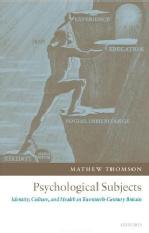
Psychological Subjects: Identity, Culture, and Health in Twentieth-Century BritainMathew Thomson, Oxford University Press 2006
This is a history of how twentieth-century Britons came to view themselves and their world in psychological terms, and how this changed over time. It examines the extent to which psychological thought and practice could mediate, not just understanding of the self, but also a wide range of social and economic, political, and ethical issues that rested on assumptions about human nature. In doing so, it brings together high and low psychological cultures; it focuses not just on health,but also on education, economic life, and politics; and it reaches from the start of the century right up to the 1970s.Mathew Thomson highlights the intense excitement surrounding psychology at the start of the century, and its often highly unorthodox expression in thought and practice. He argues that the appeal of psychological thinking has been underestimated in the British context, partly because its character has been misconstrued. Psychology found a role because, rather than shattering values, it offered them new life. The book considers the extent to which such an ethical and social psychologicalsubjectivity survived the challenges of an industrial civilization, a crisis in confidence regarding human nature wrought by war and political extremism, and finally the emergence of a permissive society. It concludes that many of our own assumptions about the route to psychological modernity - centred onthe rise of individualism and interiority, and focusing on the liberation of emotion, and on talk, relationships, and sex - need substantial revision, or at least setting alongside a rather different path when it comes to the Britain of 1900-70.
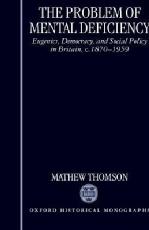
The Problem of Mental Deficiency: Eugenics, Democracy, and Social Policy in Britain c.1870-1959Mathew Thomson, Oxford University Press, 1998
This is the first full study of the great alarm about "mental defectives" in Britain between 1870 and 1959, and the resulting policies of segregation, community care, and sexual sterilization. Mathew Thomson examines the origins of these policies in central government and shows how they were put into practice by health professionals and local authorities. He reveals how policy-makers avoided extremist measures such as compulsory sterilization (introduced in Germany and parts of the US during this period), not for reasons of liberal principle but because of the socially conservative and anti-interventionlist nature of British political culture.
W
- Walton, Charles - 01 - Into Print: Limits and Legacies of the Enlightenment; Essays in Honor of Robert Darnton
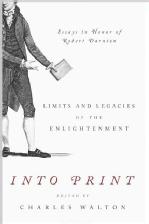
Into Print: Limits and Legacies of the Enlightenment; Essays in Honor of Robert DarntonCharles Walton (editor), University Park: Penn State University Press, 2011
The famous clash between Edmund Burke and Tom Paine over the Enlightenment’s “evil” or “liberating” potential in the French Revolution finds present-day parallels in the battle between those who see the Enlightenment at the origins of modernity’s many ills, such as imperialism, racism, misogyny, and totalitarianism, and those who see it as having forged an age of democracy, human rights, and freedom. The essays collected by Charles Walton in Into Print paint a more complicated picture. By focusing on print culture—the production, circulation, and reception of Enlightenment thought—they show how the Enlightenment was shaped through practice and reshaped over time. These essays expand upon an approach to the study of the Enlightenment pioneered four decades ago: the social history of ideas. The contributors to Into Print examine how writers, printers, booksellers, regulators, police, readers, rumormongers, policy makers, diplomats, and sovereigns all struggled over that broad range of ideas and values that we now associate with the Enlightenment. They reveal the financial and fiscal stakes of the Enlightenment print industry and, in turn, how Enlightenment ideas shaped that industry during an age of expanding readership. They probe the limits of Enlightenment universalism, showing how demands for religious tolerance clashed with the demands of science and nationalism. They examine the transnational flow of Enlightenment ideas and opinions, exploring its domestic and diplomatic implications. Finally, they show how the culture of the Enlightenment figured in the outbreak and course of the French Revolution. Aside from the editor, the contributors are David A. Bell, Roger Chartier, Tabetha Ewing, Jeffrey Freedman, Carla Hesse, Thomas M. Luckett, Sarah Maza, Renato Pasta, Thierry Rigogne, Leonard N. Rosenband, Shanti Singham, and Will Slauter.
- Walton, Charles - 02 - Policing Public Opinion in the French Revolution: The Culture of Calumny and the Problem of Free Speech
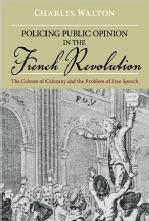
Policing Public Opinion in the French Revolution: The Culture of Calumny and the Problem of Free SpeechCharles Walton, New York: Oxford University Press, 2009
In the 1789 Declaration of the Rights of Man and of the Citizen, French revolutionaries proclaimed the freedom of speech, religion, and opinion. Censorship was abolished, and France appeared to be on a path towards tolerance, pluralism, and civil liberties. A mere four years later, the country descended into a period of political terror, as thousands were arrested, tried, and executed for crimes of expression and opinion.
In Policing Public Opinion in the French Revolution, Charles Walton traces the origins of this reversal back to the Old Regime. He shows that while early advocates of press freedom sought to abolish pre-publication censorship, the majority still firmly believed injurious speech—or calumny-constituted a crime, even treason if it undermined the honor of sovereign authority or sacred collective values, such as religion and civic spirit.
With the collapse of institutions responsible for regulating honor and morality in 1789, calumny proliferated, as did obsessions with it. Drawing on wide-ranging sources, from National Assembly debates to local police archives, Walton shows how struggles to set legal and moral limits on free speech led to the radicalization of politics, and eventually to the brutal liquidation of "calumniators" and fanatical efforts to rebuild society's moral foundation during the Terror of 1793-1794.
With its emphasis on how revolutionaries drew upon cultural and political legacies of the Old Regime, this study sheds new light on the origins of the Terror and the French Revolution, as well as the history of free expression.
